





 |
 |
 |
 |
 |
 |
|---|---|---|---|---|---|
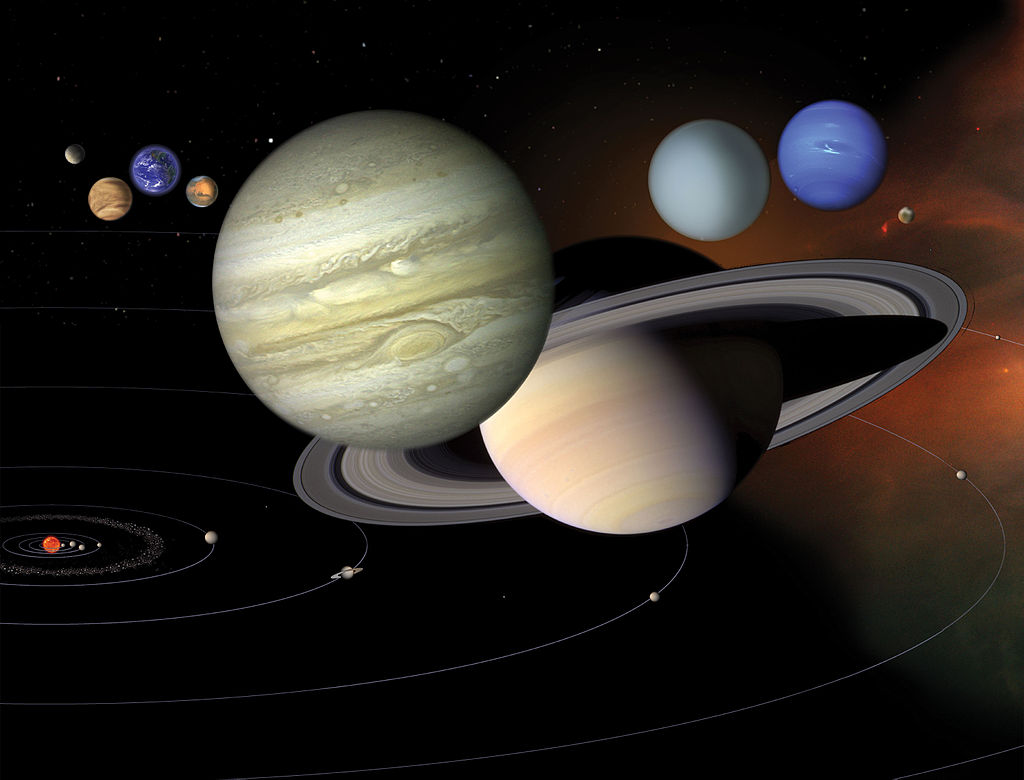 |
|
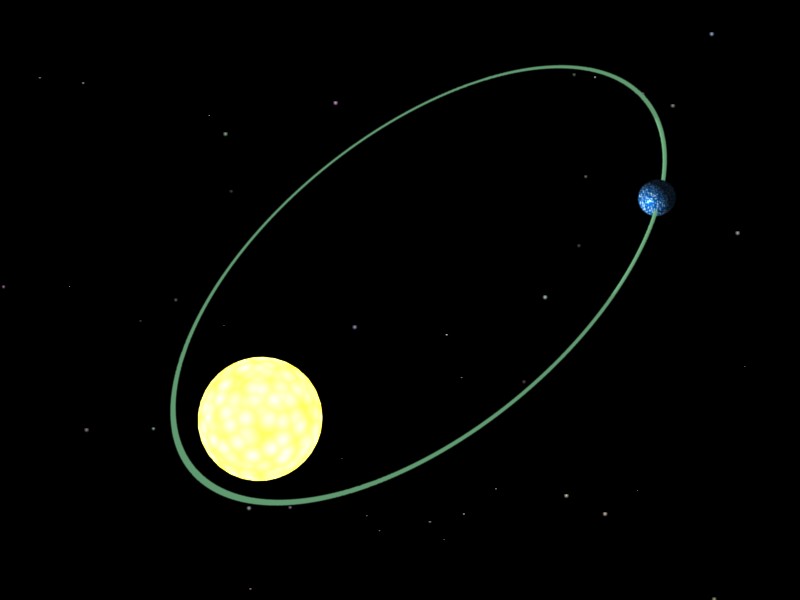 |
 |
 |
|---|---|---|---|---|
 |
.gif) |
 |
 |
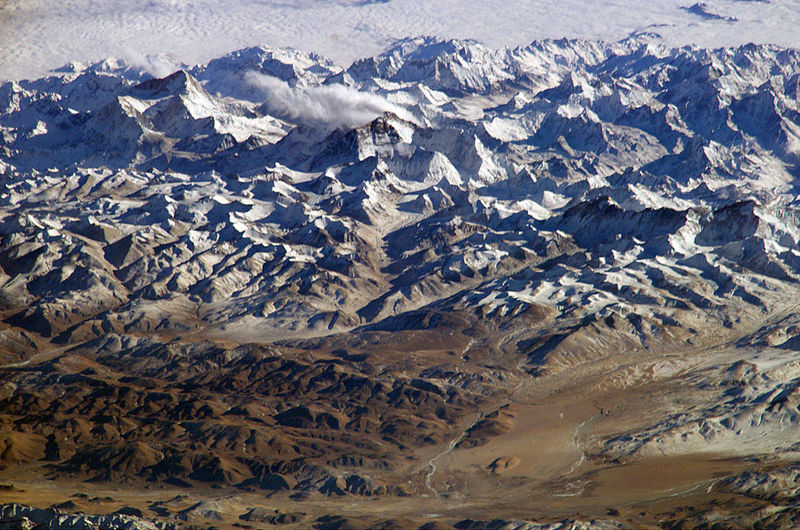 |
|---|---|---|---|---|
 |
 |
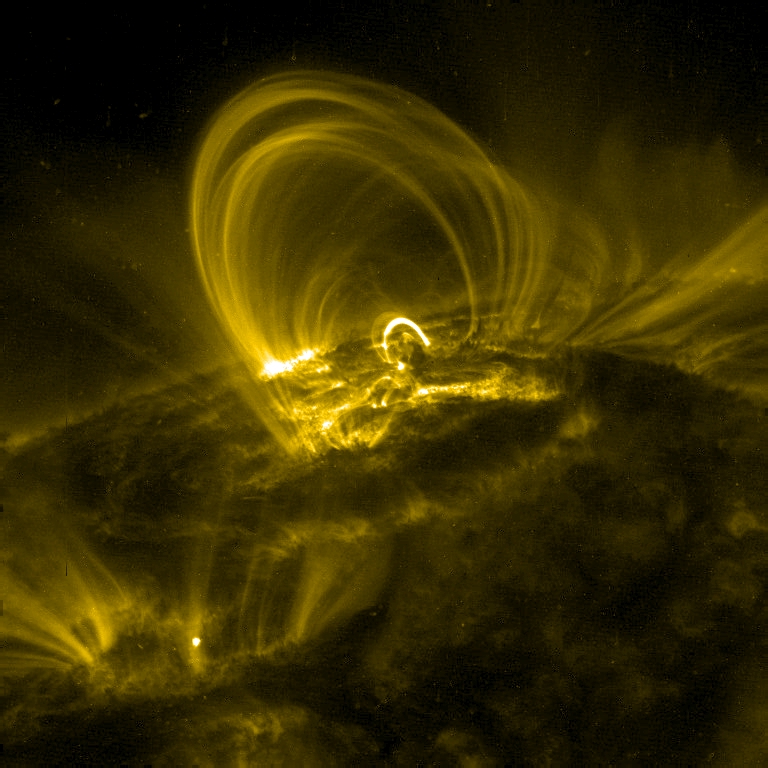 |
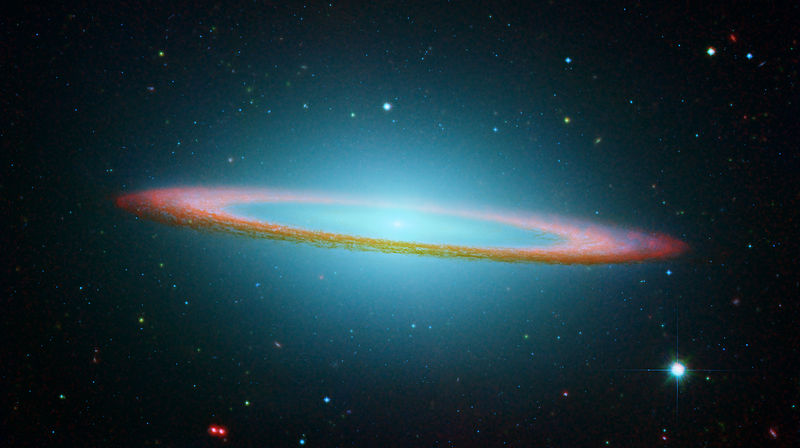 |
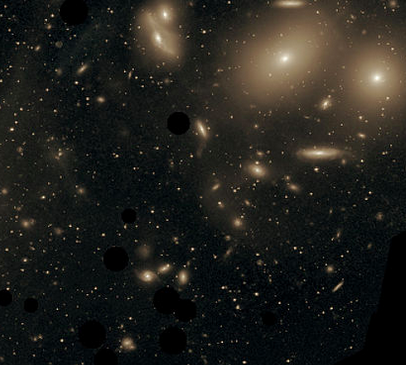 |
|---|---|---|---|---|
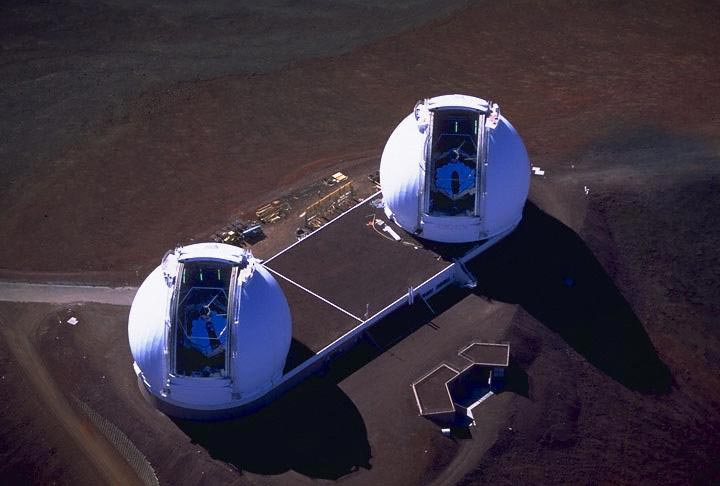 |
 |
|---|---|
 |
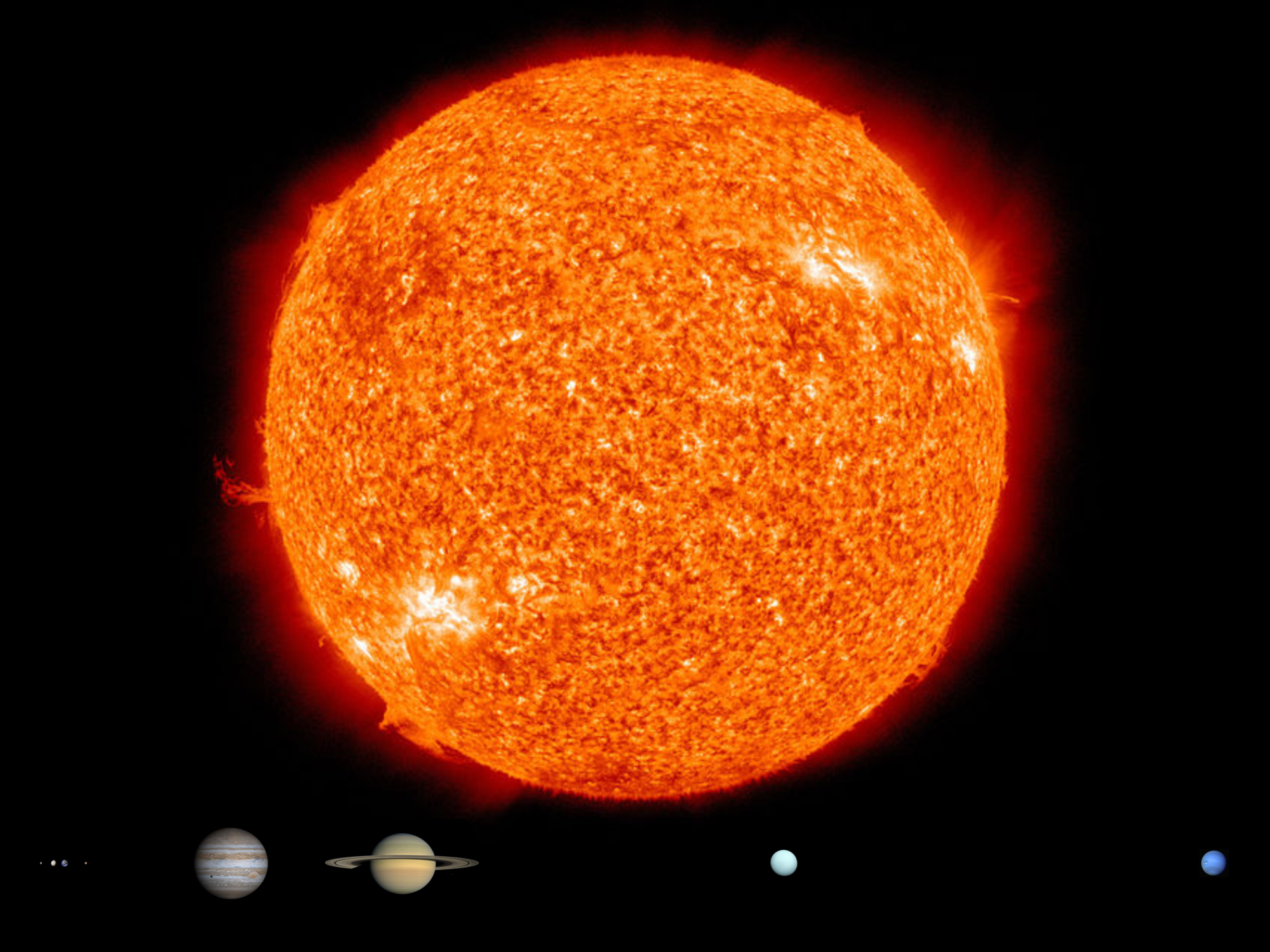 |
|---|
 |
|---|
All sizes to scale, and the size of each moon is in scale with the distance to its host planet.
Pluto and Charon are faintly visible at this scale.
In the following figure all objects are magnified by a factor of 40 and the positions are unchanged. The planets are too large to display at this scale and so they are replaced by green dots. Pluto's moons Nix and Hydra are faintly visible at this scale.
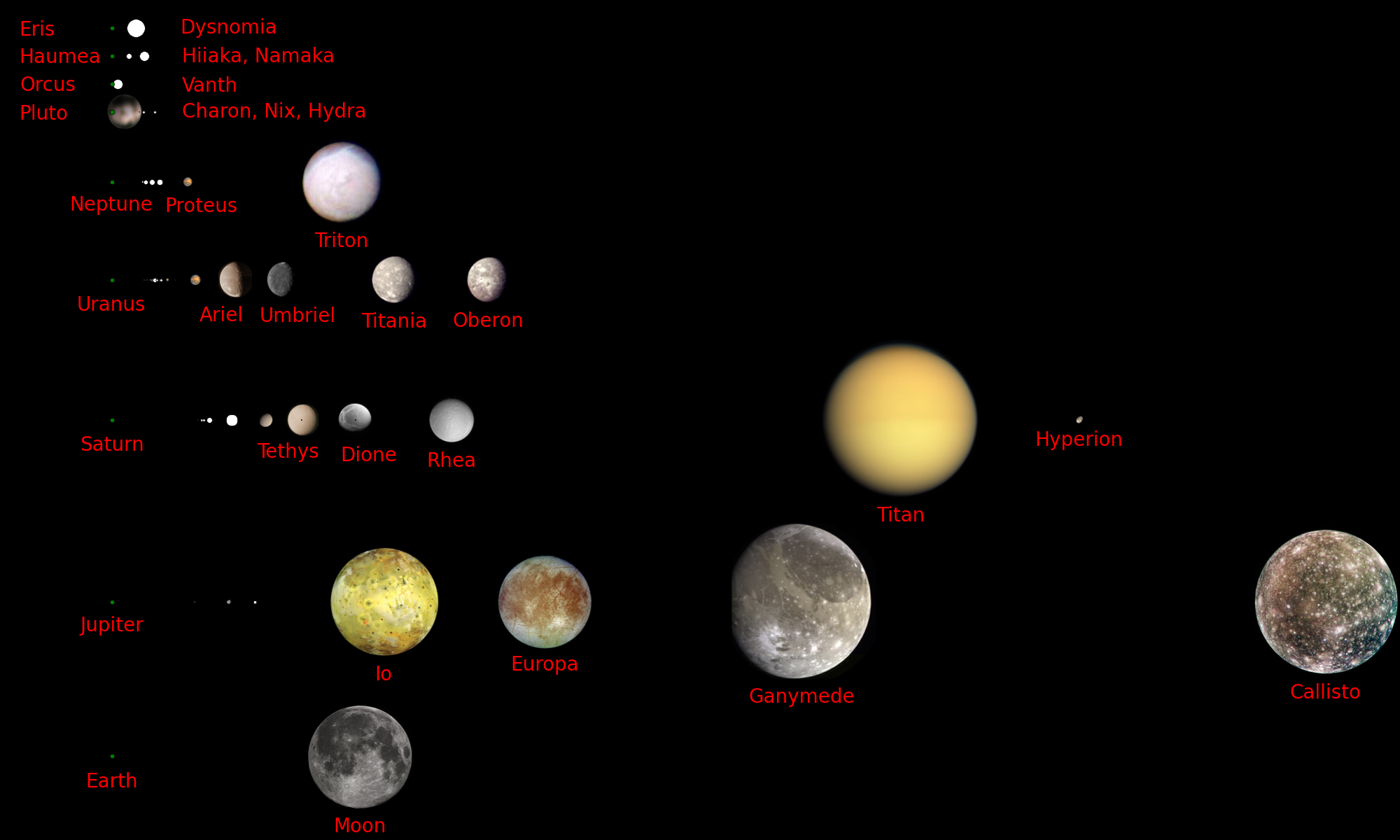 |
|---|
 |
|---|
Planet sizes are in scale with moon sizes.
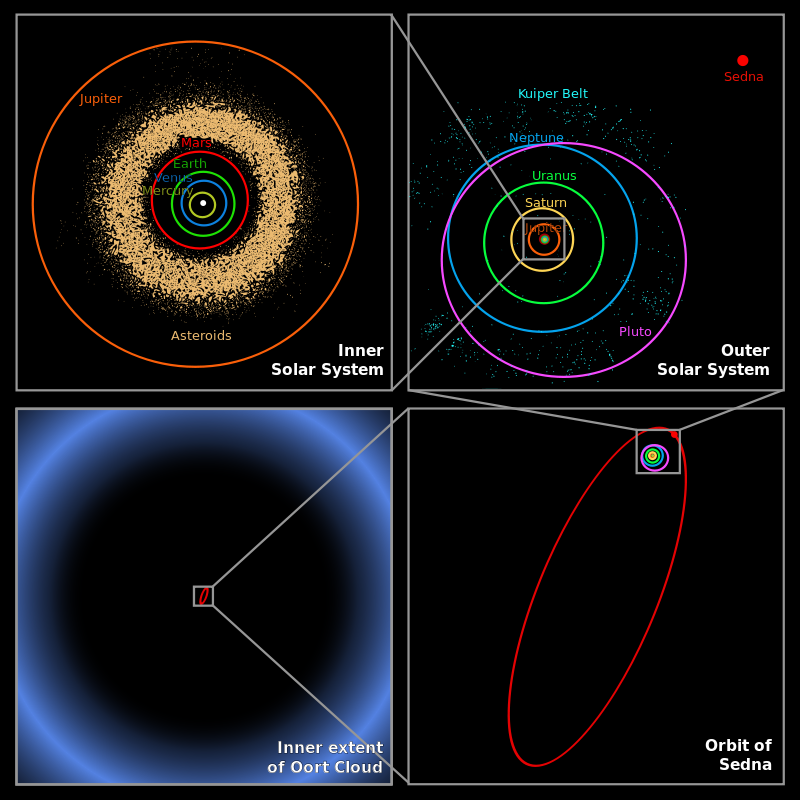 |
|---|
Moon radius / Earth radius = .273 Jupiter radius / Earth radius = 10.9 Sun radius / Earth radius = 109 Moon orbit radius / Earth radius = 60.3 = 384399 km / 6371 km Earth orbit radius / Moon orbit radius = 389 Neptune orbit radius / Earth orbit radius = 30.1 Sets the size of the solar system Light year / Earth orbit radius = 63241 Alpha Centauri distance / Earth orbit radius = 276100 Nearest star. Distance from sun = 4.366 light years Galactic center distance / Light year = 27200 Sets the size of the Milky Way galaxy Andromeda galaxy distance/ Galactic center distance= 94 Size of local group of galaxies. Andromeda is 2.6e6 light years away Virgo cluster distance / Andromeda distance = 21 Nearest supercluster, 53.5 million light years away Edge of universe / Virgo clulster distance = 256 Define the edge of the universe to be 13.7 billion light years Mass of Earth = 5.972e24 kg Radius of Earth = 6371 km Earth-Sun distance = 1.496e11 meters
Semimajor Mass Radius Escape Orbit Parent
axis (AU) (Earth=1) (Earth=1) speed speed planet
(km/s) (km/s)
Sun 333000 109.2 618.
Mercury .387 .0553 .383 4.3 47.9
Venus .723 .8150 .950 10.46 35.0
Earth 1.000 1.0000 1.000 11.2 29.8
Mars 1.524 .1074 .532 5.03 24.1
Jupiter 5.203 317.83 10.86 59.5 13.1
Saturn 9.537 95.16 9.00 35.5 9.64
Uranus 19.19 14.50 3.97 21.3 6.81
Neptune 30.07 17.20 3.86 23.5 5.43
Pluto 39.48 .00220 .184 1.23 4.74
Moon .0123 .273 2.38 1.68 Earth
Phobos 2.5e-10 .0018 .0113 2.14 Mars
Deimos 1.8e-10 .0010 .0056 1.35 Mars
Io .01495 .286 2.56 17.3 Jupiter
Europa .00804 .245 2.02 13.7 Jupiter
Ganymede .0248 .413 2.74 10.9 Jupiter
Callisto .0180 .379 2.44 8.2 Jupiter
Titan .0225 .404 2.64 5.6 Saturn
Triton .00358 .213 1.455 4.4 Neptune
Charon .000271 .093 .23 .21 Pluto
Asteroids .0005 Mass of all asteroids
Vesta 2.36 .0000447 .0413 .36 19.3 Asteroid
Ceres 2.766 .00016 .074 .51 17.9 Asteroid
Pallas 2.77 .0000359 .0427 .32 17.6 Asteroid
Kuiper belt .03 Mass of all Kuiper belt objects
Haumea 43.34 .00070 .0487 .84 4.48 Kuiper belt object
Makemake 45.79 .0007 .11 .74 4.42 Kuiper belt object
Eris 67.67 .00278 .183 1.34 3.44 Kuiper belt object
"Orbit speed" refers to speed around the sun for planets and to speed around the
planet for moons.
Sizes are to scale and colors are as your eye perceives. Brightness is scaled logarithmically. The image is 40 light years across.
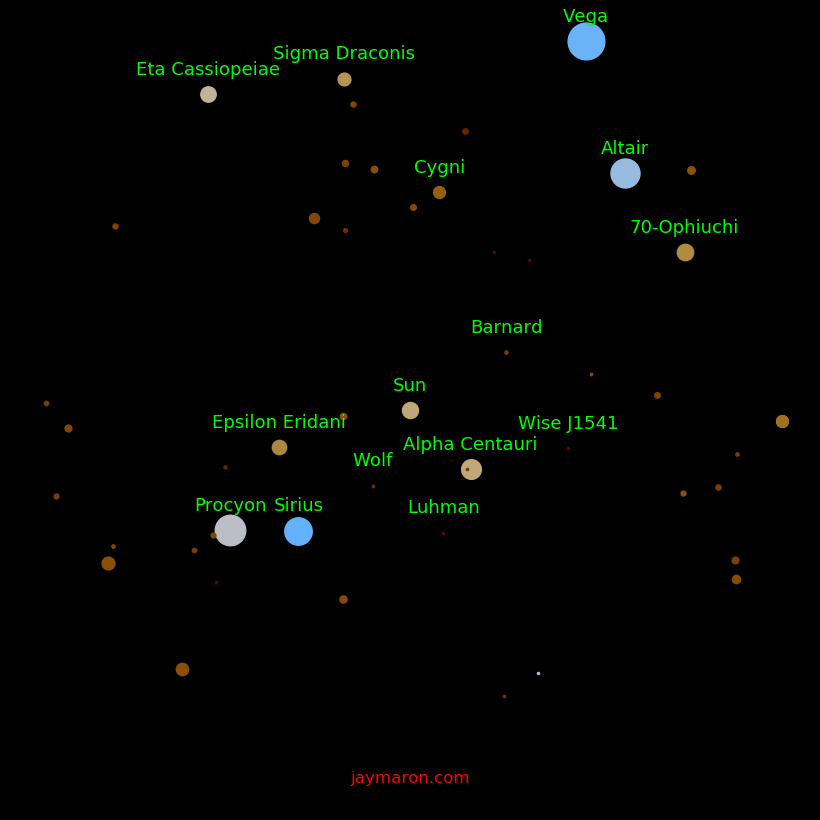 |
|---|
Proxima Centauri is the small red dot on top of Alpha Centauri. Beta Centauri is at the same place as Alpha Centauri, and is not shown.
Faint red dots are red dwarfs.
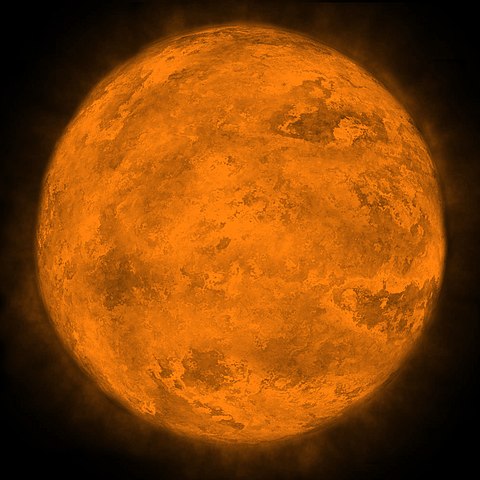 |
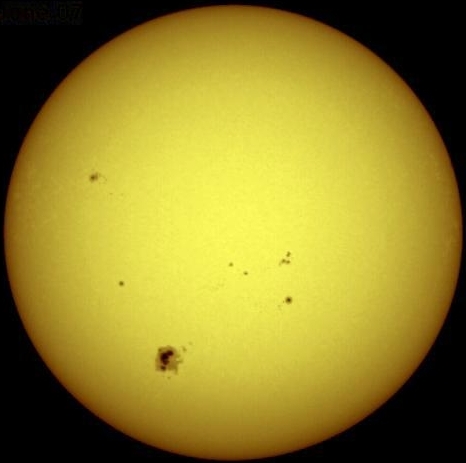 |
 |
 |
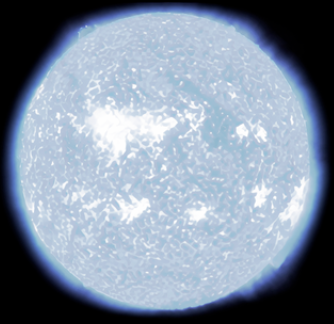 |
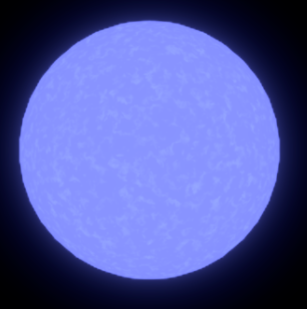 |
|||
|---|---|---|---|---|---|---|---|---|
The sun is a G star.
Sizes and colors are to scale. Brightness is not to scale. Blue giants are vastly brighter than red dwarfs.
Mass increases rightward.
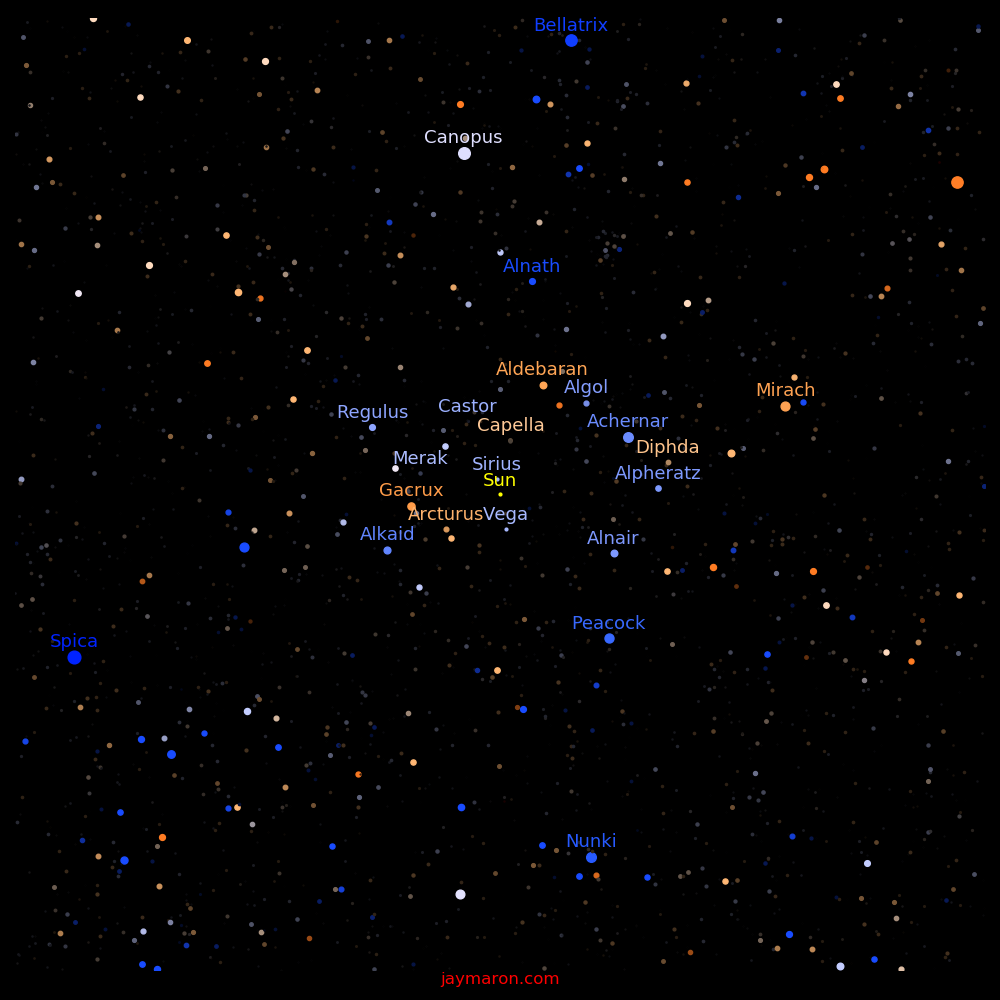 |
|---|
Color is as your eye perceives, and dot size scales with the logarithm of luminosity. The image is 500 light years across, and it's aligned with the galactic plane. If you are far away from the galaxy, such that all the stars are the same distance from you, then this is what you would see. The galaxy is a mix of red, orange, white, and blue stars, and they average to white.
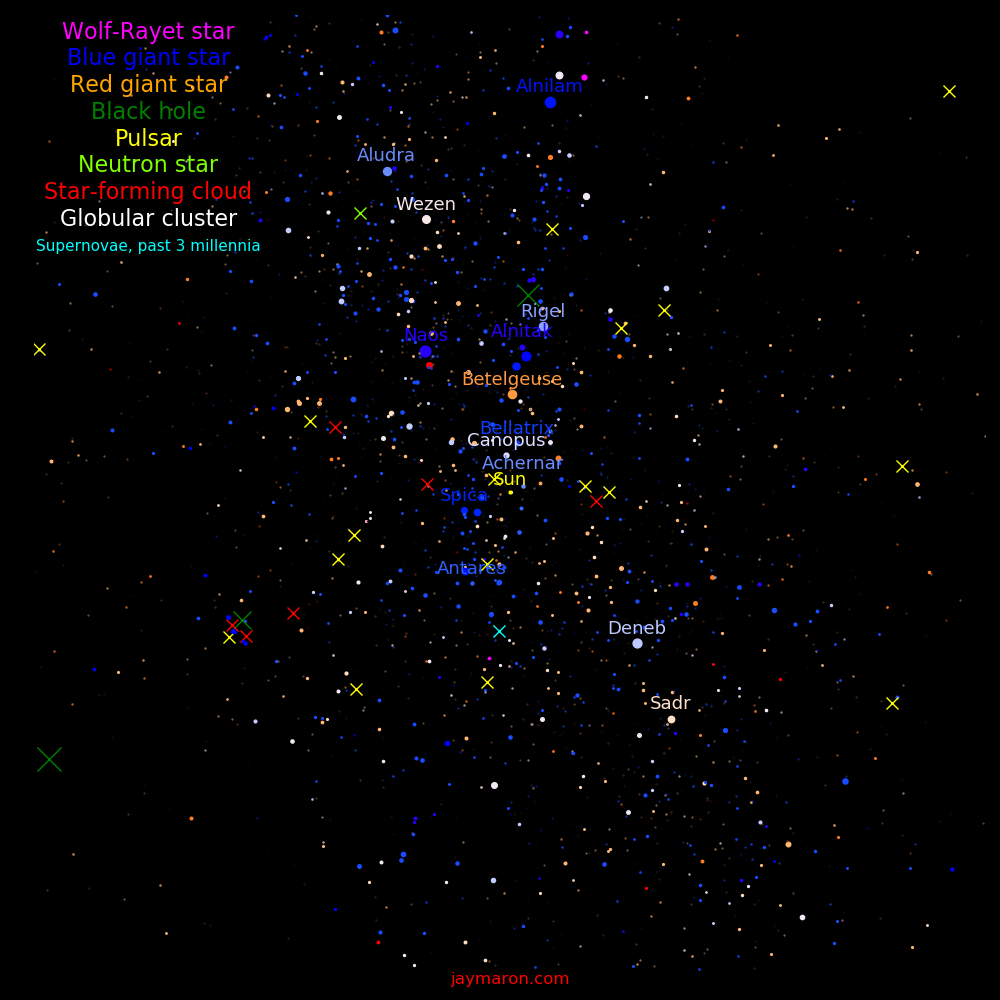 |
|---|
For stars, color is as your eye perceives, and dot size scales with the logrithm of luminosity. The image is 5000 light years across, and it's aligned with the galactic plane.
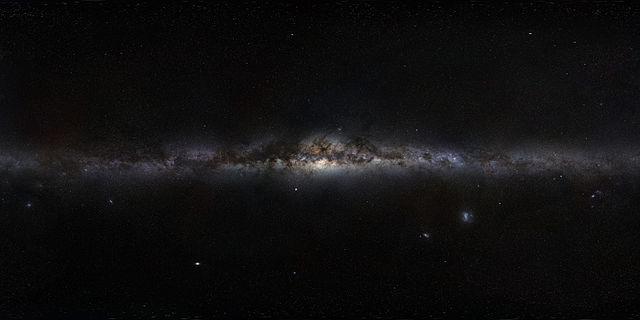 |
|---|
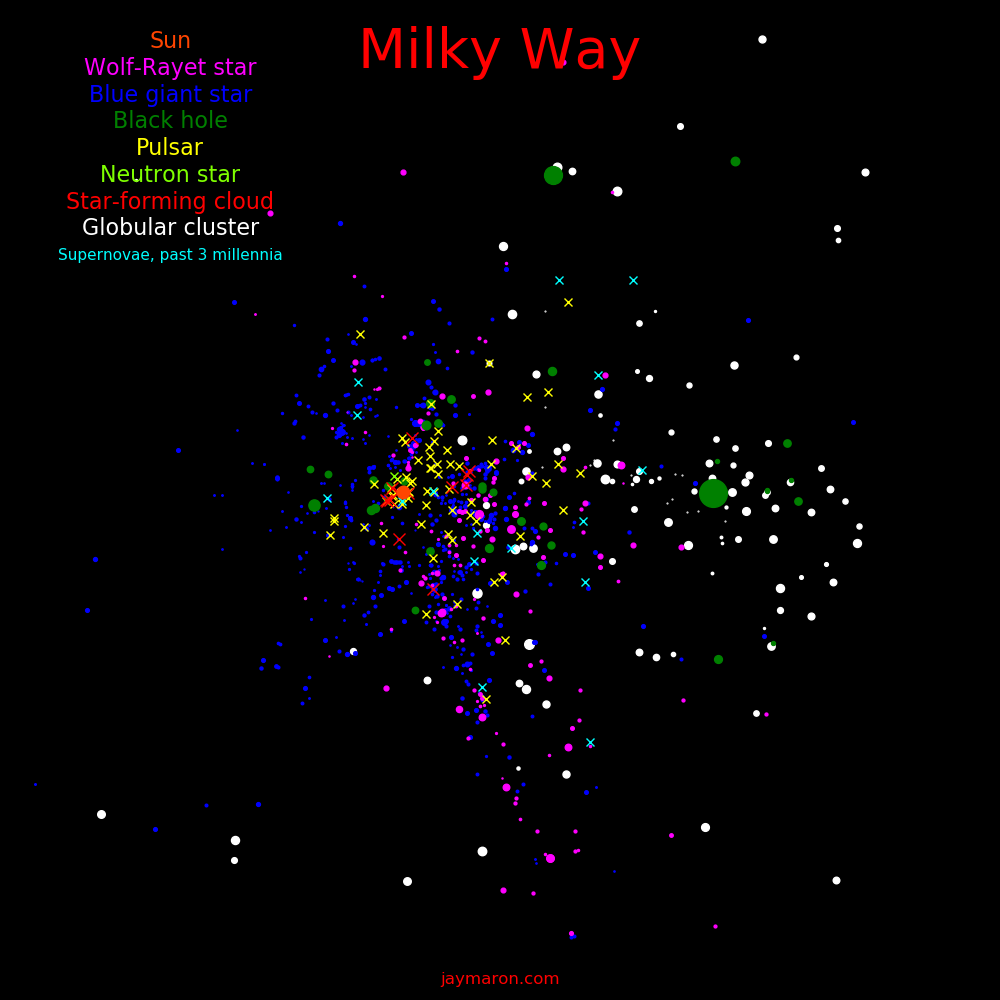 |
|---|
The big green dot is the supermassive black hole at the center of the galaxy, and the sun is to the left. The image is 80000 light years across.
Globular clusters are centered around the galaxy center.
The sun is in a spiral arm, which is mapped out by stars and star-forming clouds.
Most of the far side of the galaxy is obscured by dust, which is why most of the objects are on the near side of the galaxy. Globular clusters and blue giant stars are bright enough to be seen on the far side of the galaxy.
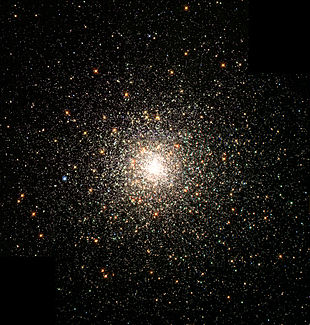 |
|---|
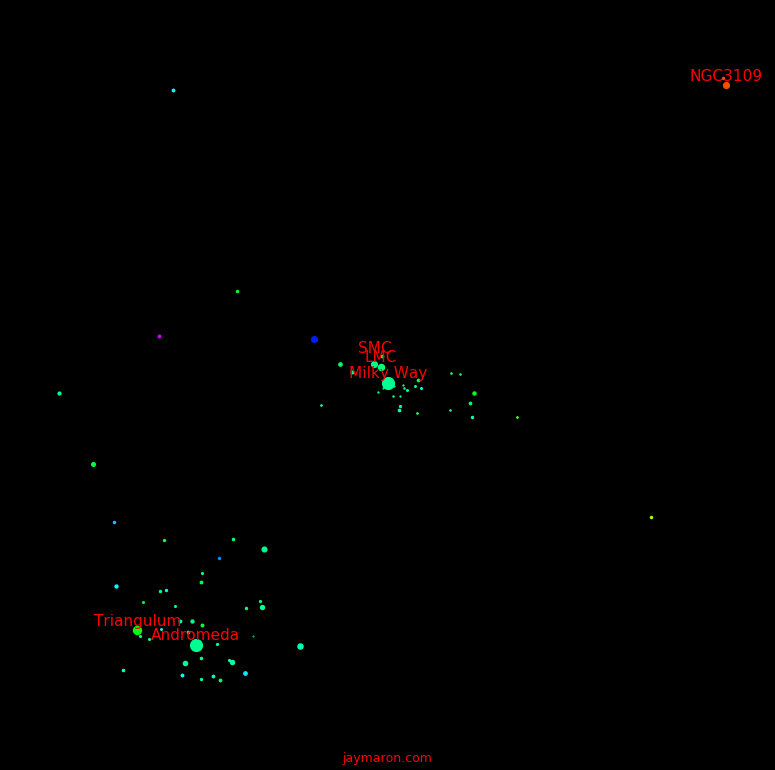 |
|---|
The largest galaxies in the local group are the Milky Way and Andromeda. Sizes and distances are to scale. The image is 6 million light years across. Color indicates the Z coordinate. Blue points have positive Z, red points have negative Z, and green points have Z=0.
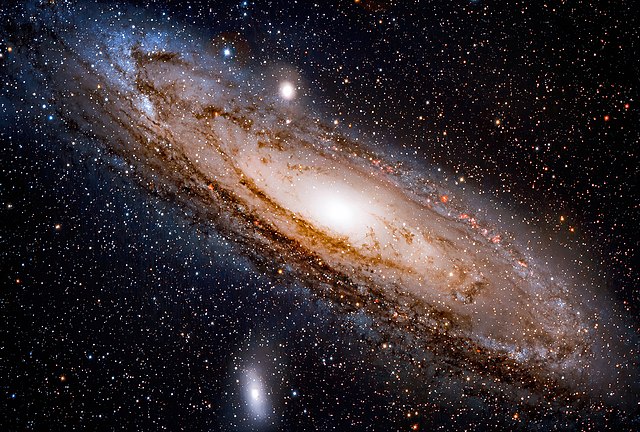 |
 |
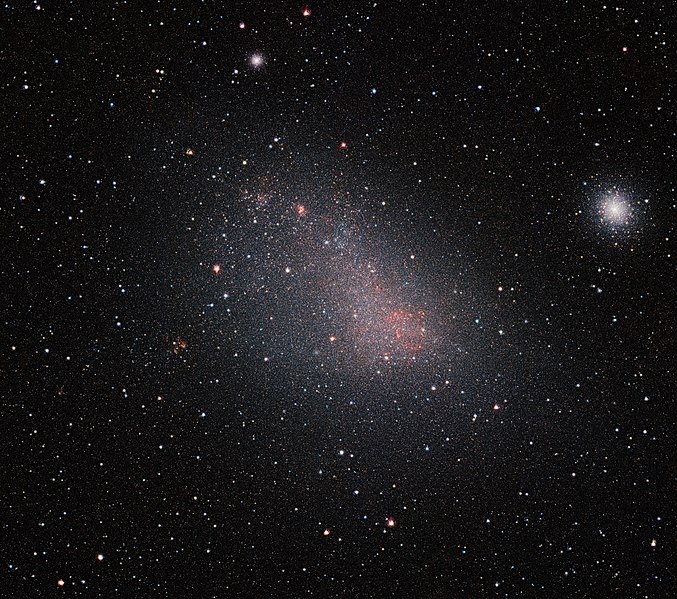 |
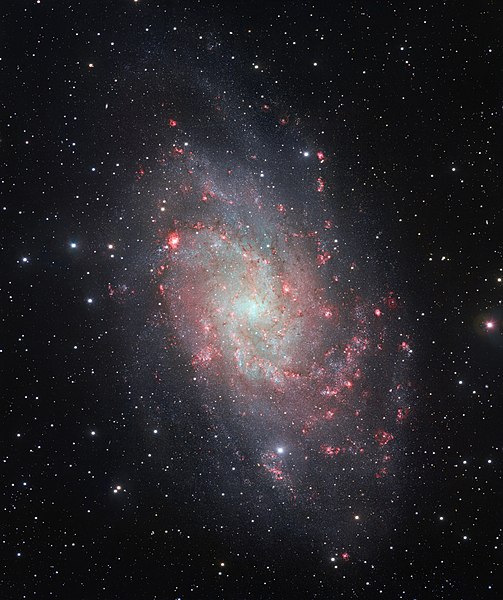 |
|---|---|---|---|
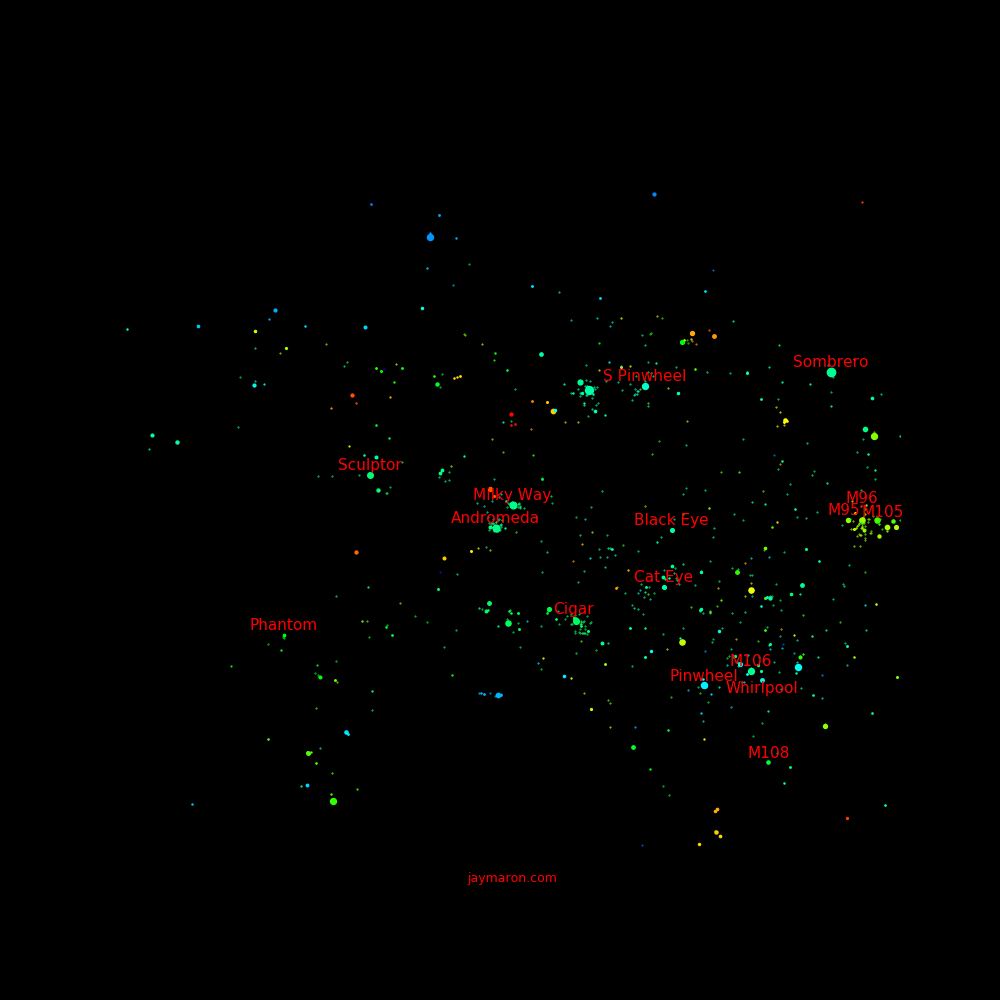 |
|---|
Most galaxies lie in a plane, the "supergalactic plane". This is why most of them are green. The plane Z=0 is aligned with the supergalactic plane.
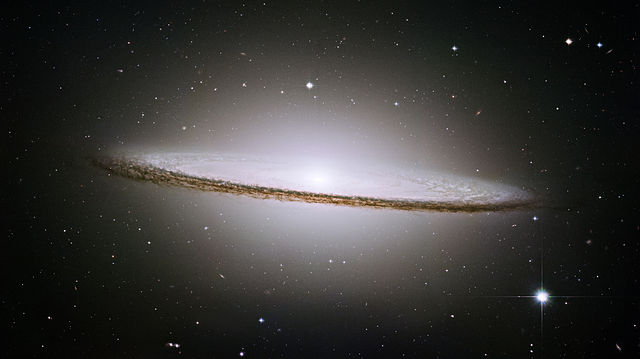 |
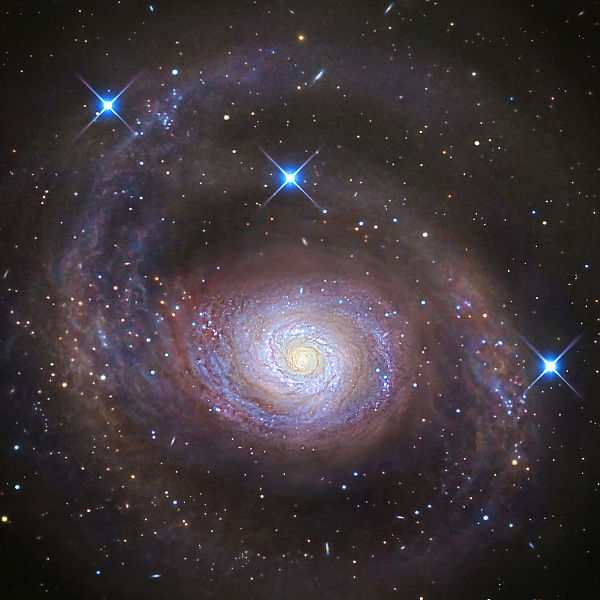 |
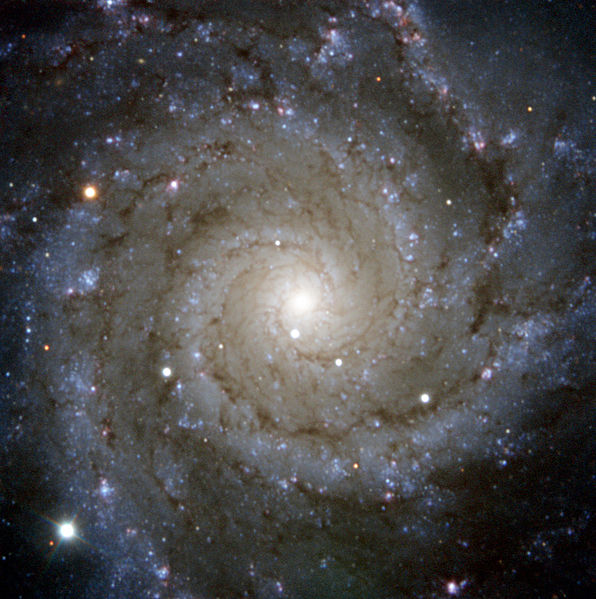 |
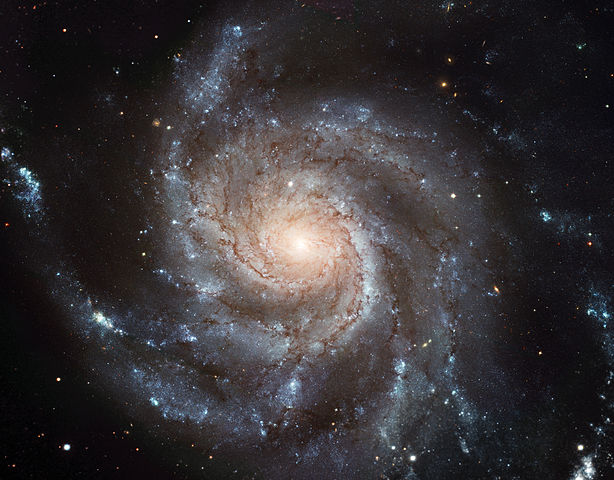 |
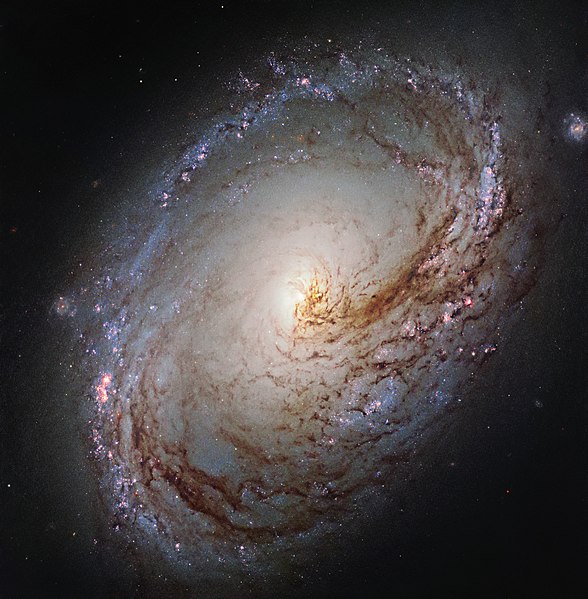 |
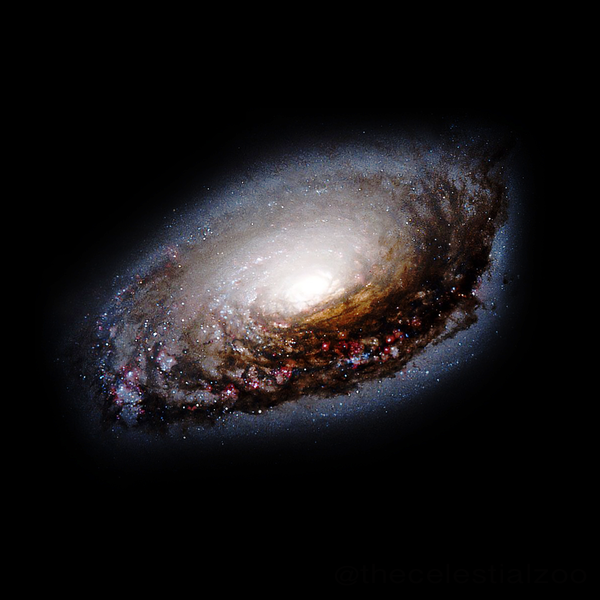 |
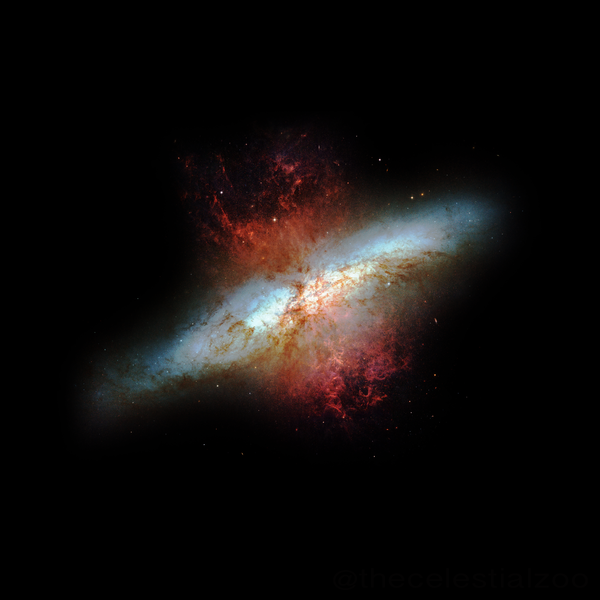 |
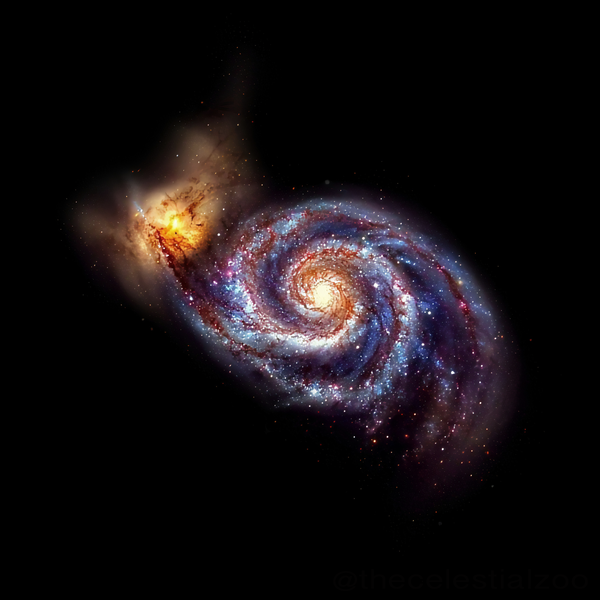 |
 |
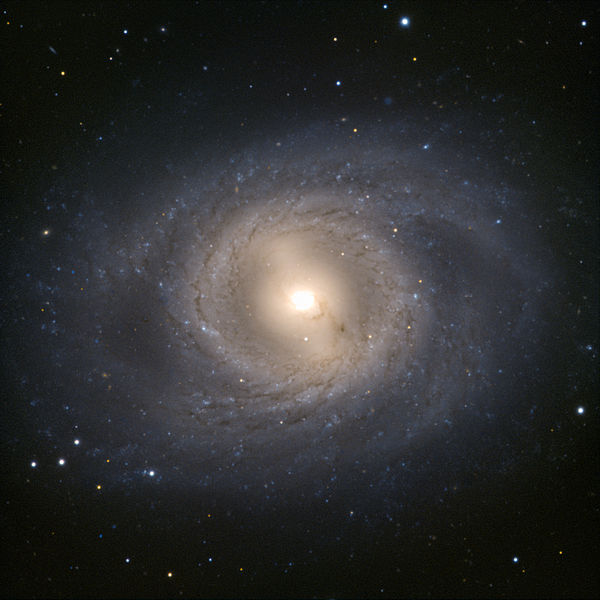 |
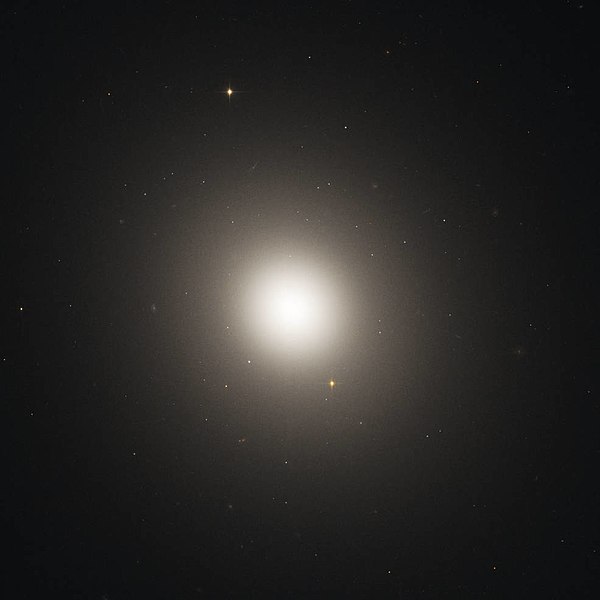 |
 |
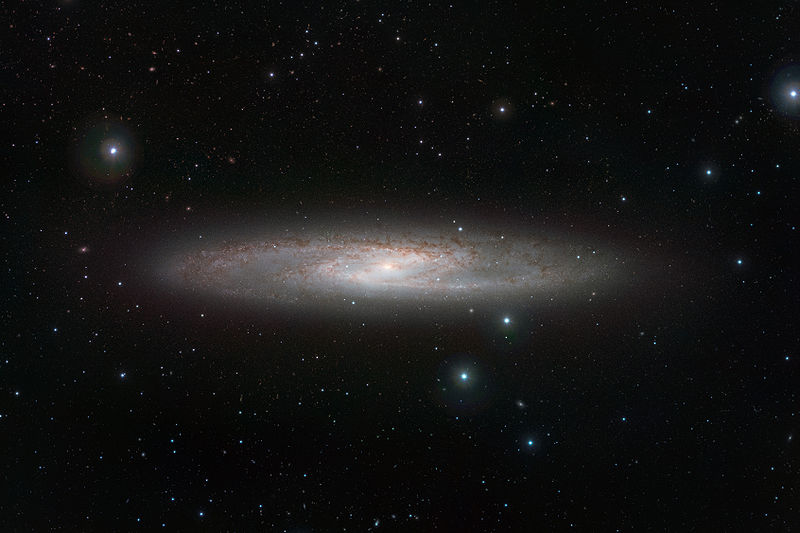 |
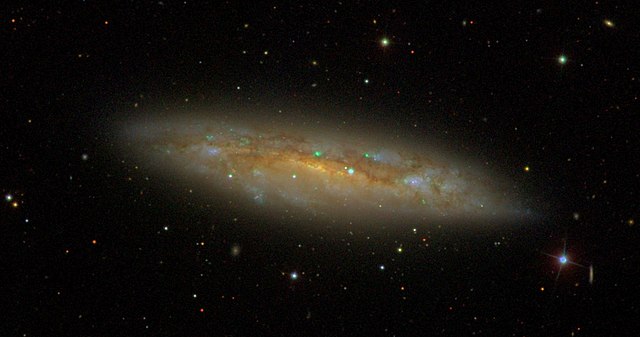 |
|---|---|---|---|---|---|---|---|---|---|---|---|---|---|
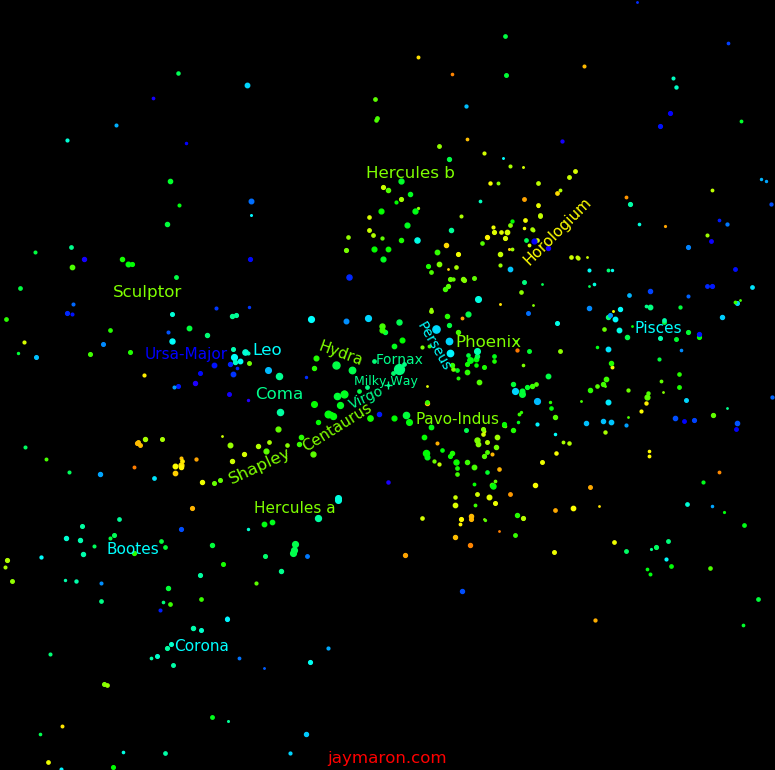 |
|---|
Dots are "Abell clusters", which are clusters of galaxies. Abell clusters are often grouped into superclusters.
The image is 2000 million light years across. Blue points have positive Z, red points have negative Z, and green points have Z=0.
Most superclusters lie in a plane, the "supergalactic plane". This is why most of them are green. The plane Z=0 is aligned with the supergalactic plane.
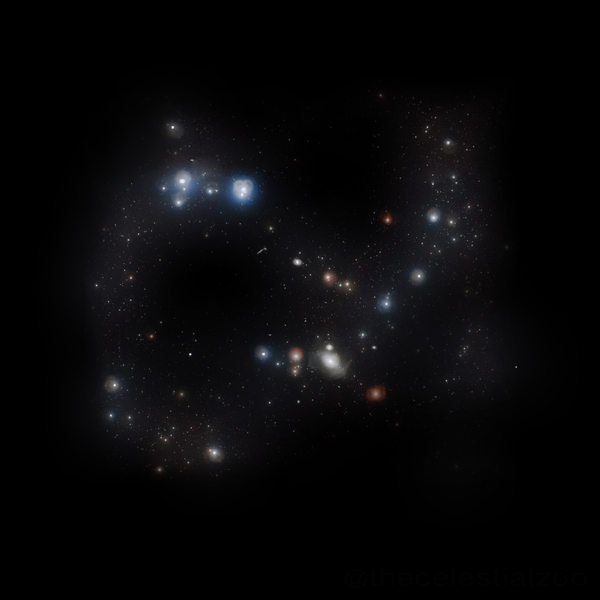 |
 |
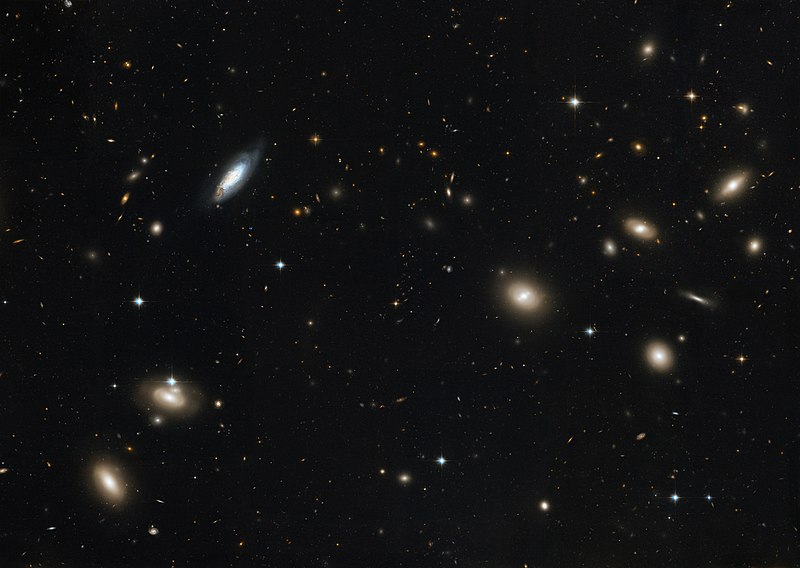 |
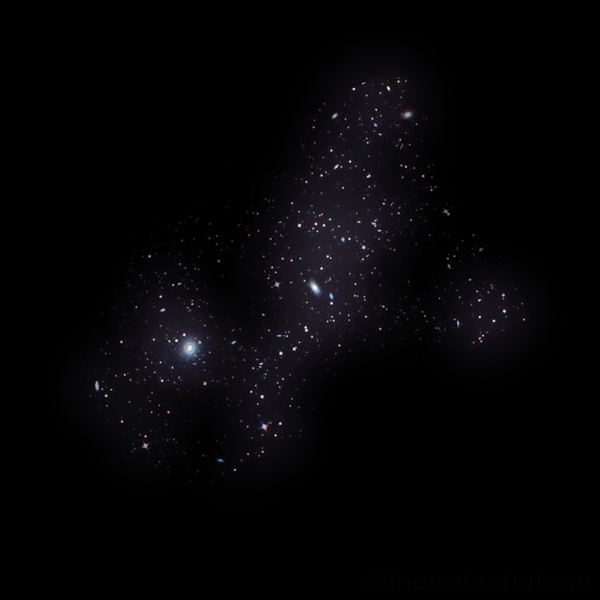 |
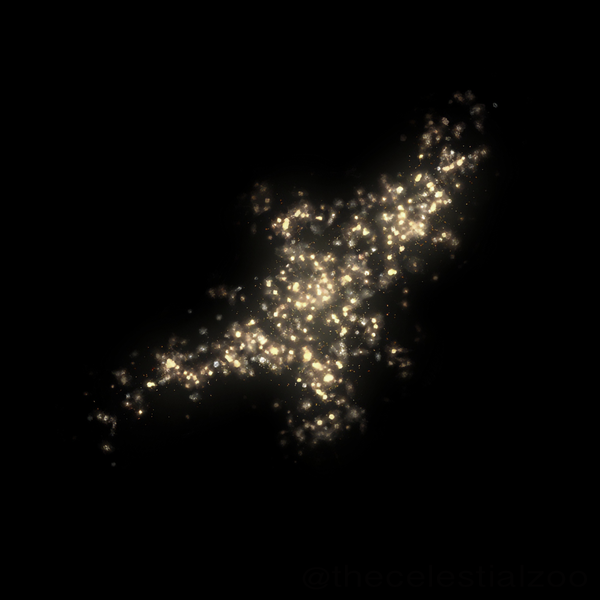 |
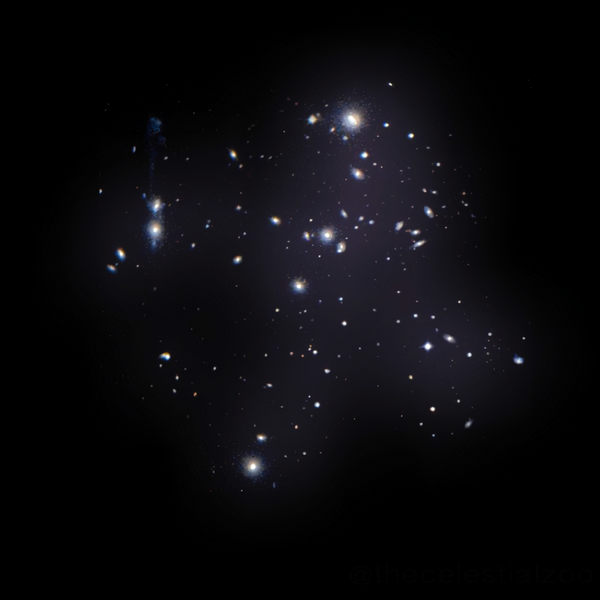 |
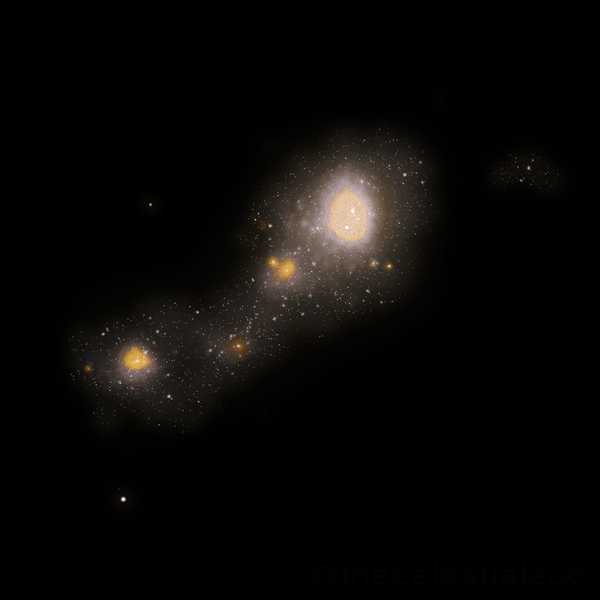 |
|---|---|---|---|---|---|---|
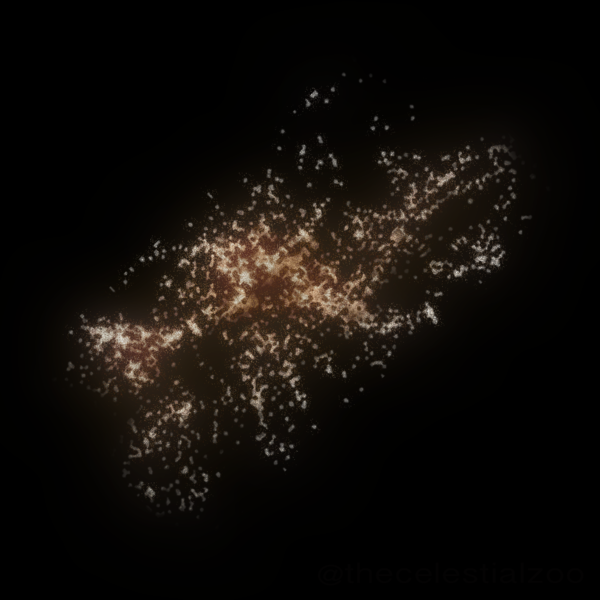 |
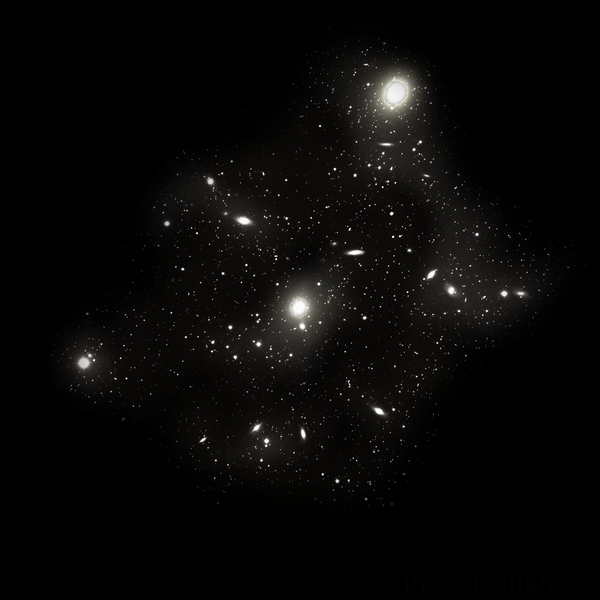 |
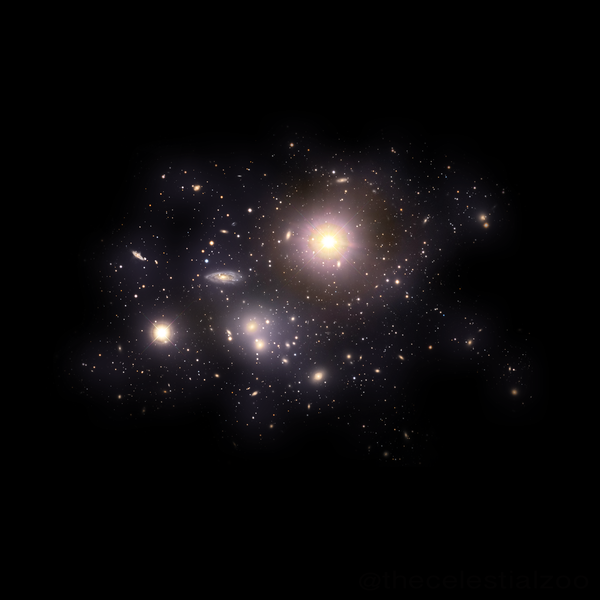 |
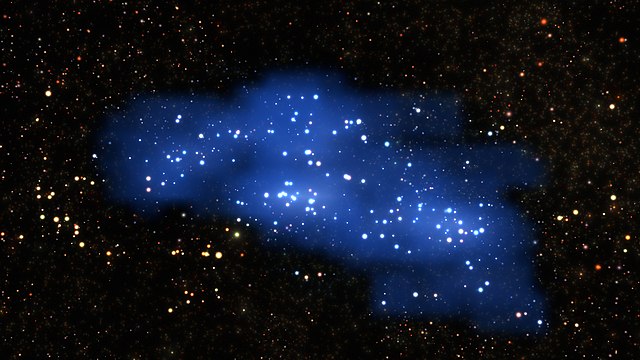 |
 |
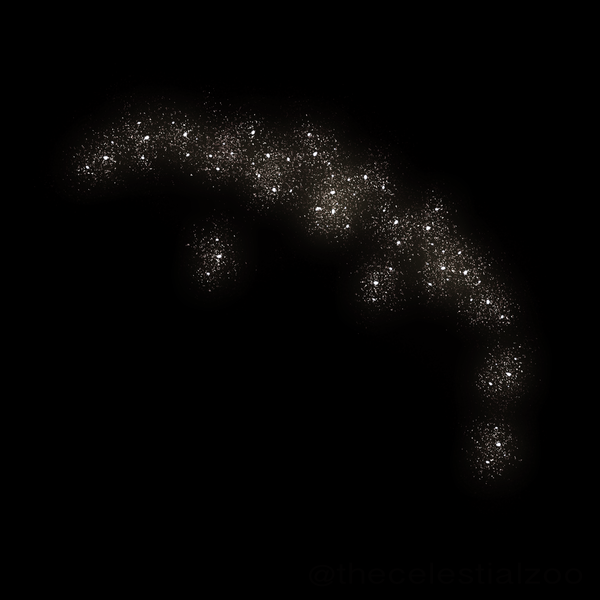 |
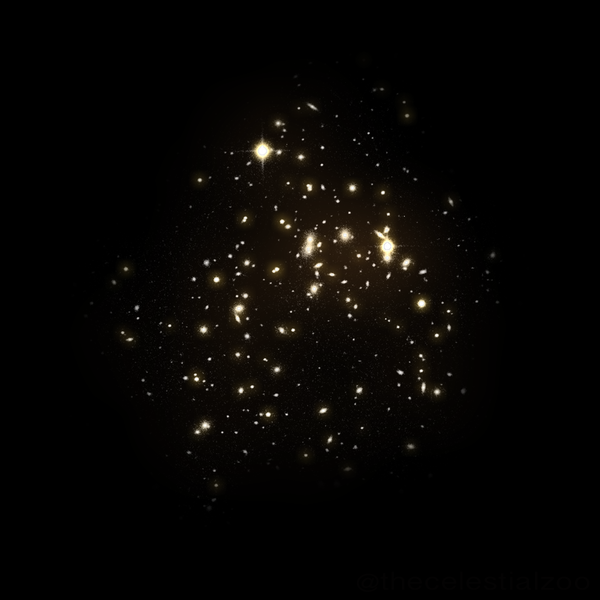 |
|---|---|---|---|---|---|---|
This shows the galaxies of the local group and their radial velocities. Most galaxies are heading in the direction of the Milky Way. Andromeda is headed for a collision with the Milky Way. The LMC and SMC are headed away from us but they will turn around and crash into the Milky Way.
 |
|---|
This shows the Hubble law. Nearby galaxies tend to be moving toward us and distant galaxes are always moving away from us. The farther the galaxy, the faster it tends to move away from us.
 |
|---|
The universe expands according to the Hubble law. If there were no gravity, all galaxies would fall on the Hubble line. Departures rom the Hubble law are due to gravity between galaxies.
For each cluster, we identified the largest galaxies and used these for the plot. Each point represents a galaxy, and the label denotes what cluster the galaxy belongs go.
 |
|---|
 |
|---|
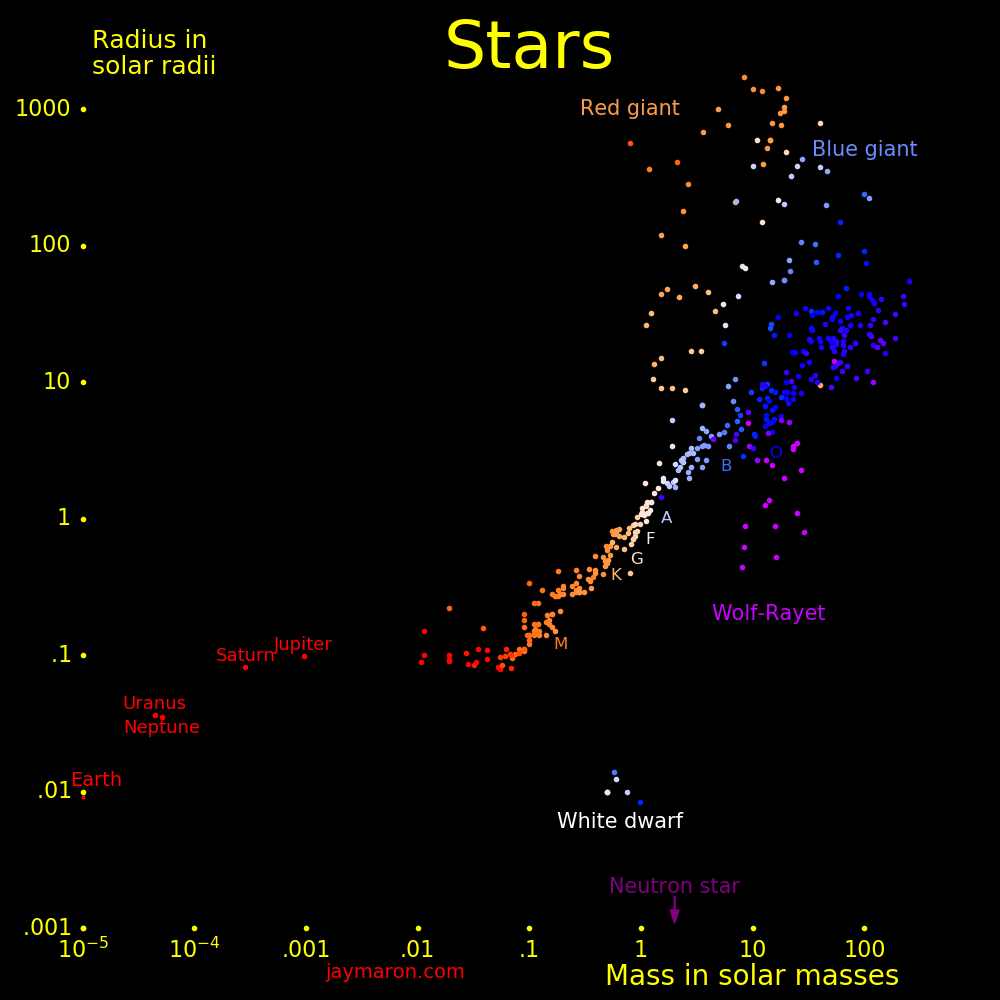 |
|---|
 |
|---|
 |
|---|
Mass of Earth = M = 5.972⋅1024 kg Radius of Earth = R = 6371 km Gravitational constant = G = 6.67⋅10-11 Newton meters2/kg2 Mass of a test object = m Force on the test object = F = -G M m / R2 = g m Gravitational acceleration = g = -G M / R2 = 9.8 meters/second2 Gravitational energy = E = -G M m / R
 |
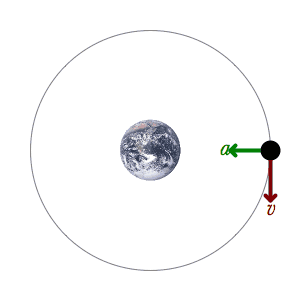 |
|---|---|
Mass of central object = M Gravity constant = G Distance of satellite from central object = R Velocity for a satellite on a circular orbit = Vc = (G M / R) Escape velocity for a satellite = Ve = 2 (G M / R) = 2½ VcFor a satellite on a circular orbit,
Gravity force = Centripetal force G M m / R2 = m V2c / RThe escape velocity is obtained by setting
Gravity energy = Kinetic energy
G M m / R = ½ m V2e
Escape Circular orbit
velocity velocity
(km/s) (km/s)
Earth 11.2 7.9
Mars 5.0 3.6
Moon 2.4 1.7
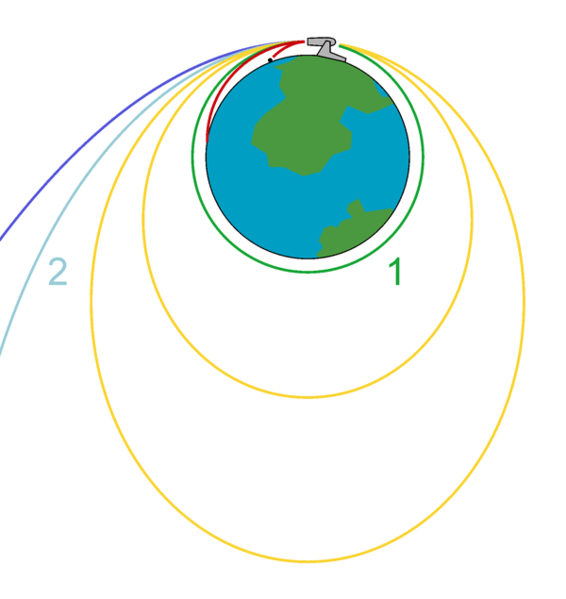 |
|---|
If a cannonball is fired at a speed of 7.8 km/s then it orbits the Earth in a circle. If the speed is lower then it crashes into the Earth.
Speed (km/s) Orbit type
Red <7.8 Ellipse Too slow to reach orbit. Crashes into the Earth
Green 7.8 Ellipse (circle) Critical speed for a circular orbit
Yellow Ellipse Orbits Earth as an ellipse
Cyan 11.2 Parabola Min speed to escape Earth, the "escape speed"
Blue >11.2 Hyperbola More than the escape speed
Elliptic orbit: Retraces its path each cycle
Parabolic orbit: Departs the Earth and limits to a speed of zero
Hyperbolic orbit: Departs the Earth and limits to a positive speed
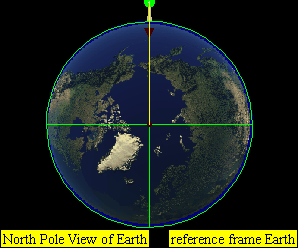 |
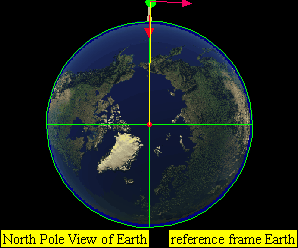 |
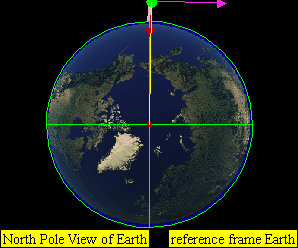 |
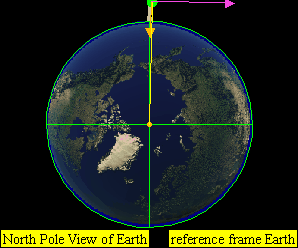 |
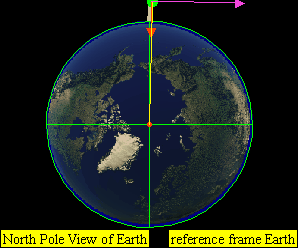 |
 |
|---|---|---|---|---|---|
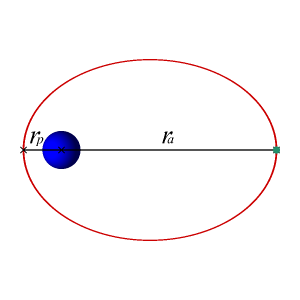 |
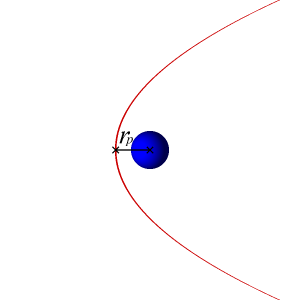 |
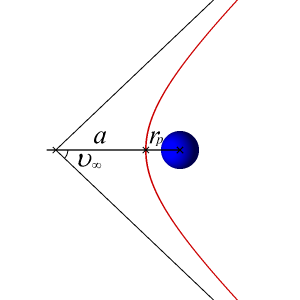 |
|---|---|---|
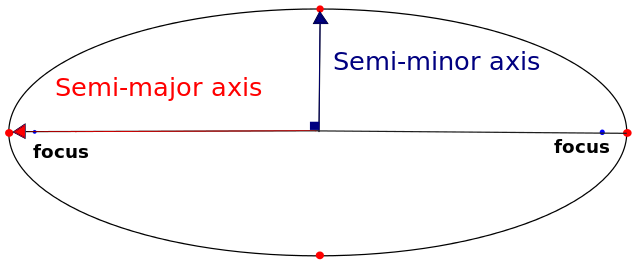 |
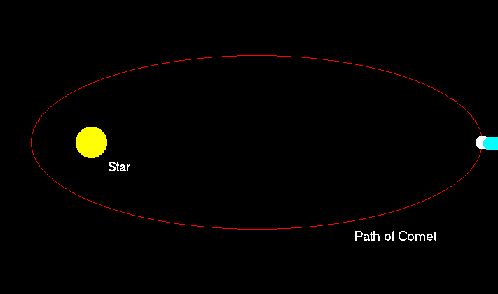 |
 |
|---|---|---|
In general an orbit is either an ellipse, a parabola, or a hyperbola. A circle is a special case of an ellipse with an eccentricity of 0.
The degree of elongation of an ellipse is parameterized by its "eccentricity".
Eccentricity Orbit type e = 0 Circle (a circle is a special case of an ellipse) 0 < e < 1 Ellipse (less than escape velocity) e = 1 Parabola (exactly escape velocity) e > 1 Hyperbola (more than escape velocity)In describing an ellipse we replace the radius with the "semimajor axis". For a circle they are equal.
Semimajor axis = A (equal to the radius if the ellipse is a circle)
Semiminor axis = B = a (1-e2)1/2 (A=B for a circle)
Periapsis = X = A (1-e) ("perigee" if the focus is the Earth)
Apoapsis = Y = A (1+e) ("apogee" if the focus is the Earth)
Eccentricity = e = (1-B2/A2)½
Central mass = M (mass at the focus)
Gravity constant = G
Orbit time = T = 2πA (GM)-½ (depends on the semimajor axis and not the eccentricity)
For an object on a circular orbit,
Gravitational energy = -2 * Kinetic energyThe relationship between the kinetic and gravitational energy doesn't depend on R. If a satellite inspirals toward a central object, the gain in kinetic energy is always half the loss in gravitational energy. The total energy is negative.
Total energy = Gravitational energy + Kinetic energy
= ½ * Gravitational energy
= -½ G M m / R
Angular momentum = m V R
= m (G M R)½
As R decreases, both energy and angular momentum decrease. In order for a
satellite to inspiral it has to give energy and angular momentum to another
object.
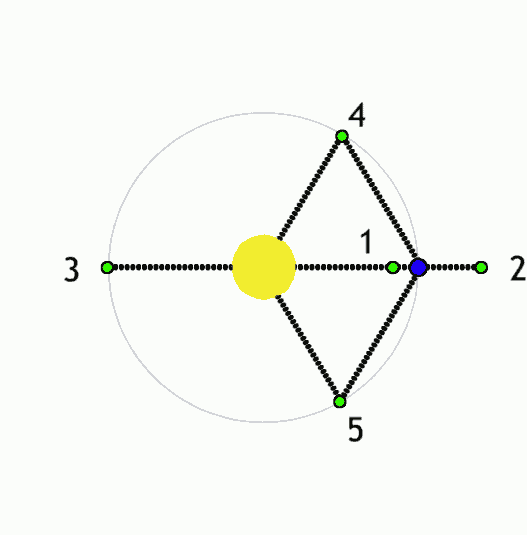 |
 |
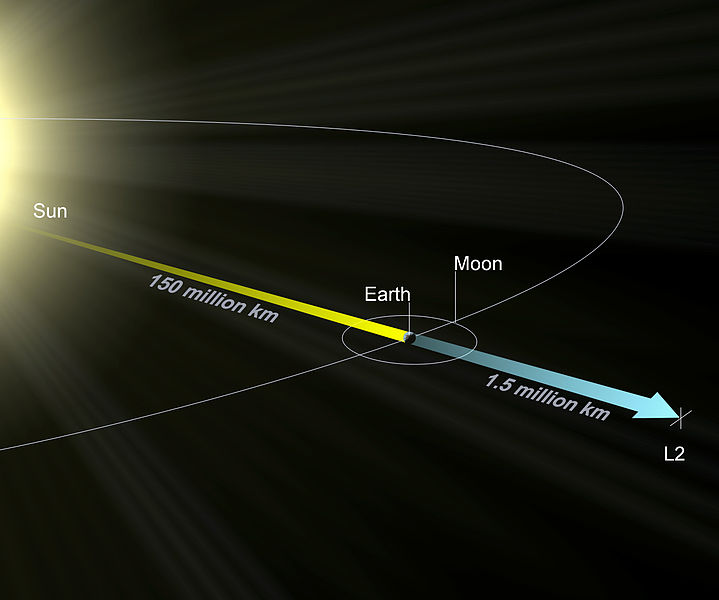 |
|---|---|---|
A planet has 5 "Lagrange points". An object orbiting at any of these points orbits in synch with the planet. L4 and L5 are the "Trojan points" and objects here are stable. If an object at one of the points is jostled it will stay in the region of the Lagrange point and stay in synch with the planet. The L1, L2, and L3 points are unstable. If an object here is jostled it will exit the region and lose synch with the planet. A spaceship can park at these points but it requires an occasional small rocket firings to maintain its position. The Webb telescope will be at L2.
If a planet orbits a star and a moon orbits a planet, and if the two orbit periods are equal, then
Star mass = M0 Planet mass = M Planet orbit time = T Moon orbit time = t = T Planet orbit radius = R Moon orbit radius = r = R ( M/M0)1/3 Hill radius = H = R (3M/M0)1/3 DerivationThe "Hill radius" characterizes the range of a planet's gravitational influence. In the limit of M << M0, the Hill radius equal to the distance from the planet to the L1 or L2 Lagrange point.
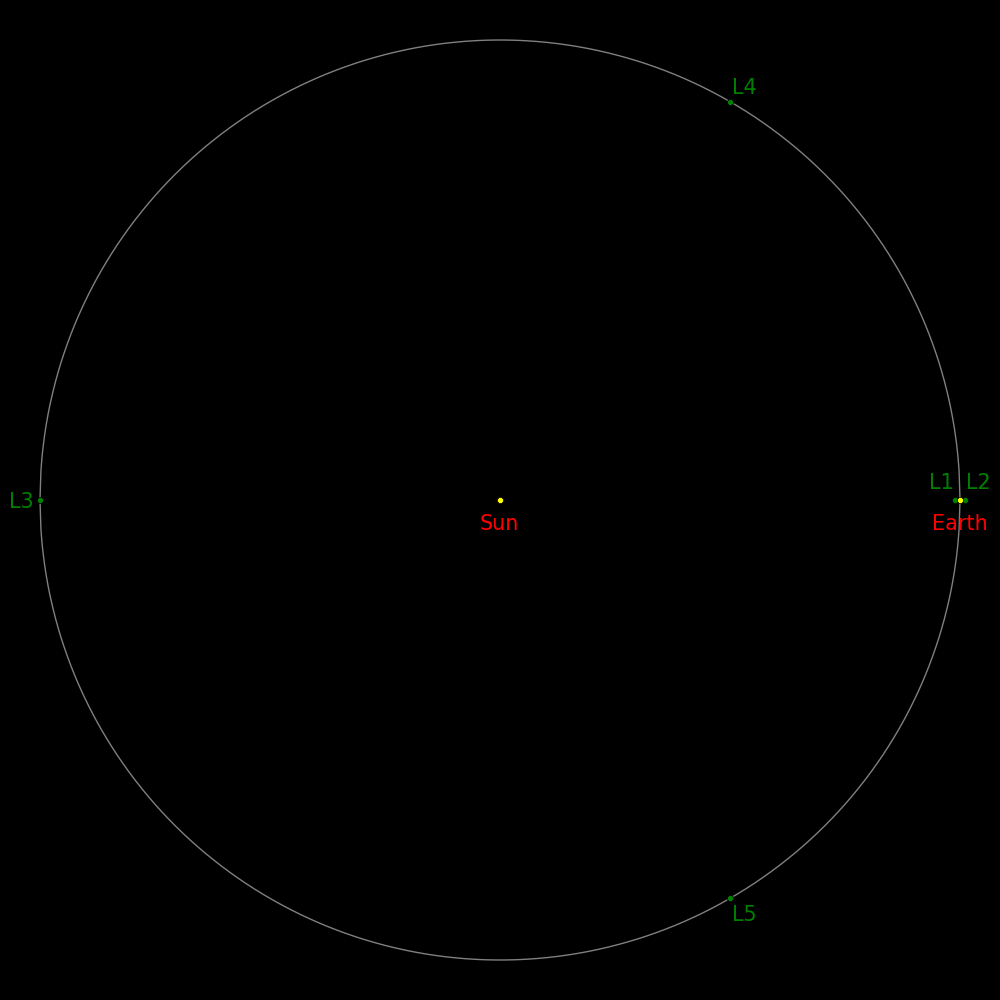 |
|---|
If a moon orbits too far from a planet then it gets stolen by the star. The boundary for this is around 1/3 of the planet's Hill radius. The Earth's moon is barely within this boundary.
Moon orbital radius / Earth Hill radius = .256
The moons of the gas giants are all well within their planet's Hill radius.
If two planets orbit within ~ 10 Hill radii of each other then they disrupt each other's orbits. This is a planet's "zone of gravitational dominance".
 |
|---|
 |
|---|
 |
|---|
 |
|---|
An object is defined as be a planet if it is:
*) Large enough for gravity to squash it into a round shape (Ceres is near this threshold).
*) Capable of clearing its orbit of other objects.
*) Not a satellite of something else.
Pluto doesn't make the cut because its Hill radius is small and because it orbits within Neptune's zone of gravitational influence.
Earth Earth Solar
radii masses masses
Neutron star 3.0 Maximum mass before a neutron star becomes a black hole
White dwarf 1.4 Maximum mass before a white dwarf becomes a neutron star
Sun 109 333000 1.0
Red dwarf 9 25000 .075 Minimum mass to fuse hydrogen and be a star
Brown dwarf 10 4130 .0124 Minimum mass to fuse deuterium & max planet mass
Jupiter 10.9 318 .00095 Largest gas giant in the solar system
Uranus 4.0 14.5 Smallest gas giant in the solar system
Earth 1.0 1.0
Venus .95 .82
Mars .53 .11
Mercury .38 .0553 Smallest object capable of clearing its orbital zone
Ganymede .41 .025
Titan .40 .022 Smallest object with an atmosphere
Callisto .38 .018
Io .29 .015
Moon .27 .012
Europa .24 .0080
Triton .21 .0036
Eris .18 .0028
Pluto .18 .0022
Ceres .074 .00016 Round asteroid. Min mass to be round
Vesta .041 .000045 Largest object that is not round
The minimum mass to be a gas is somewhere between the mass of Earth and Uranus.
The minimum mass to have an atmosphere is in the range of .02 Earth masses. If we base the definition of a planet on this mass, then Ganymede, Titan, and Callisto potentially qualify, and Pluto doesn't.
If the definition of a planet is based on gravitational roundness, and if orbital state is ignored, then a deluge of objects quality.
History of the discovery of solar system objects:
Year Object Semi major Earth Discoverer
axis (AU) masses
1781 Uranus 19.19 14.50 Herschel
1801 Ceres 2.77 .00016 Piazzi
1802 Pallas 2.77 .0000359 Olbers
1804 Juno 2.67 .0000045 Harding
1807 Vesta 2.36 .0000447 Olbers
1845 Astraea 2.57 .00000049 Hencke
1846 Neptune 30.07 17.20 Galle, using calculations by Verrier
1930 Pluto 39.48 .00220 Tombaugh
2002 Quaoar 43.37 .00023 Trujillo, Brown
2003 Sedna 506.2 .0002 Brown, Trujillo, Rabinowitzs
2004 Orcus 39.47 .000108 Brown, Trujillo, Rabinowitzs
2005 Haumea 43.22 .00070 Brown
2005 Makemake 45.79 .0007 Brown
2005 Eris 67.67 .00278 Brown
2007 OR10 66.99 .0005 Schwamb, Brown, Rabinowitz
1851 15 asteroids are known and they are grouped into their own category.
2000 The American Museum of Natural History builds a planet exhibit designed by Neil Tyson
2001 A New York Times article points out that Pluto is not present in the AMNH planet exhibit.
2006 Soter publishes a paper defining planethood in terms of "clearing the orbit".
2006 The International Astronomical Union redefines planethood, drawing from the
Soter definition. Pluto is expelled from the planet club.
Ceres, Pluto, Eris, Haumea, Makemake, Quaoar, Sedna, and Orcus are deemed
to be "dwarf plaents".
 |
|
|---|---|
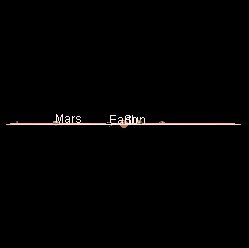 |
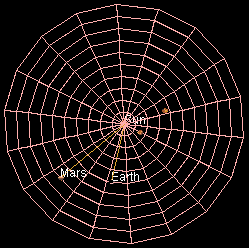 |
|---|---|
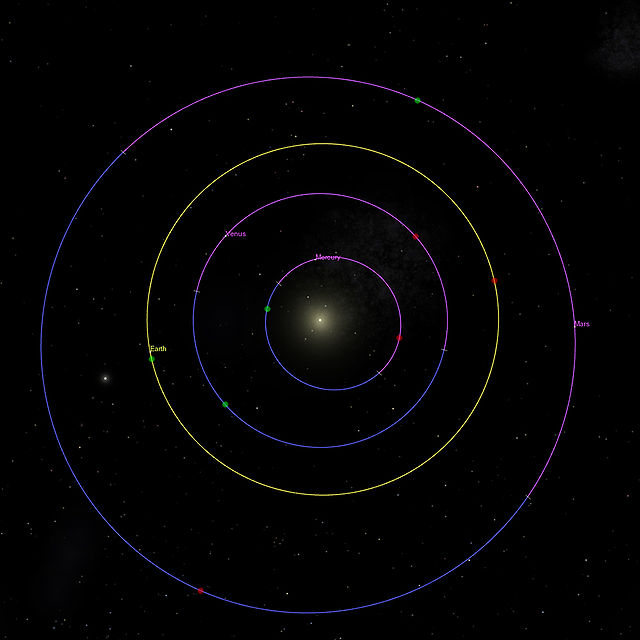 |
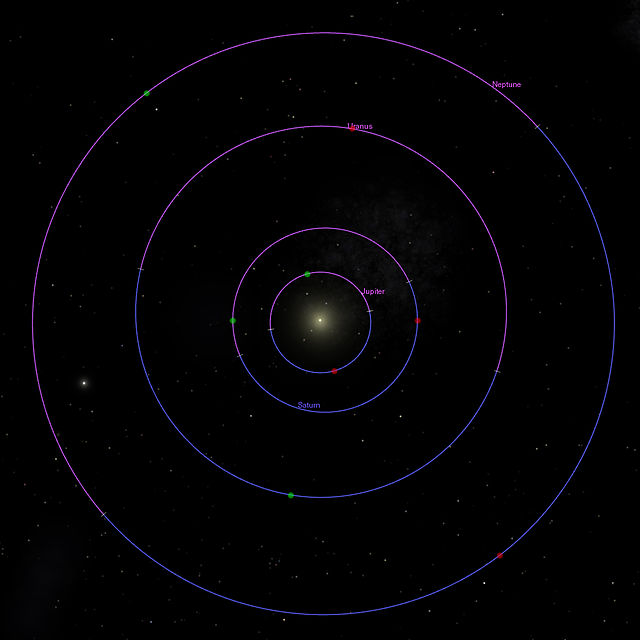 |
|---|---|
Eccentricities of the planets. Dots indicate pericenter and apocenter. As the planets orbit the pericenter and apocenter stay fixed in space.
Mercury's large eccentricity and orbit speed allowed Einstein to use it to test general relativity.
Extrasolar planets tend to have larger eccentricities and inclinations than solar system planets.
All planets spin in the same direction as their orbit except for Venus, which is reverse, and Uranus, which is sideways.
"Orbit inclination" is with respect to the ecliptic plane.
"Spin tilt" is with respect to the planet's orbit.
Eccentricity Orbit Spin Spin tilt
inclination (days) (deg)
(deg)
Sun - - 25.05 7.25
Mercury .2056 7.00 87.97 .034
Venus .0068 3.39 243.02 177.36
Earth .0167 0.00 .997 23.44
Mars .0934 1.85 1.026 25.19
Ceres .0758 10.59 .378 4
Jupiter .0484 1.30 .414 3.13
Saturn .0542 2.48 .440 26.7
Uranus .0472 .77 .718 97.8
Neptune .0086 1.77 .671 28.3
Pluto .2488 17.14 6.39 119.6
Eris .0437 43.89 1.08
Sedna .857 11.93 .43
 |
|---|
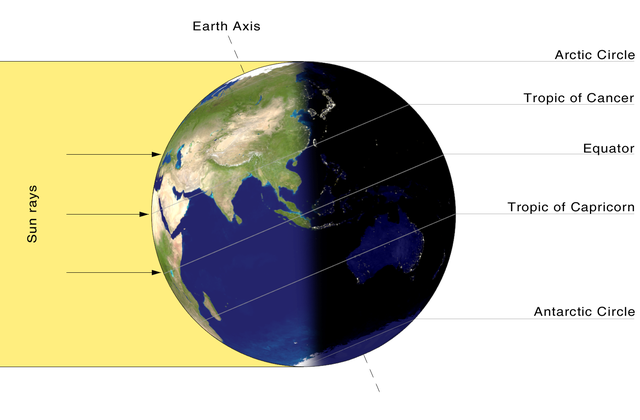 |
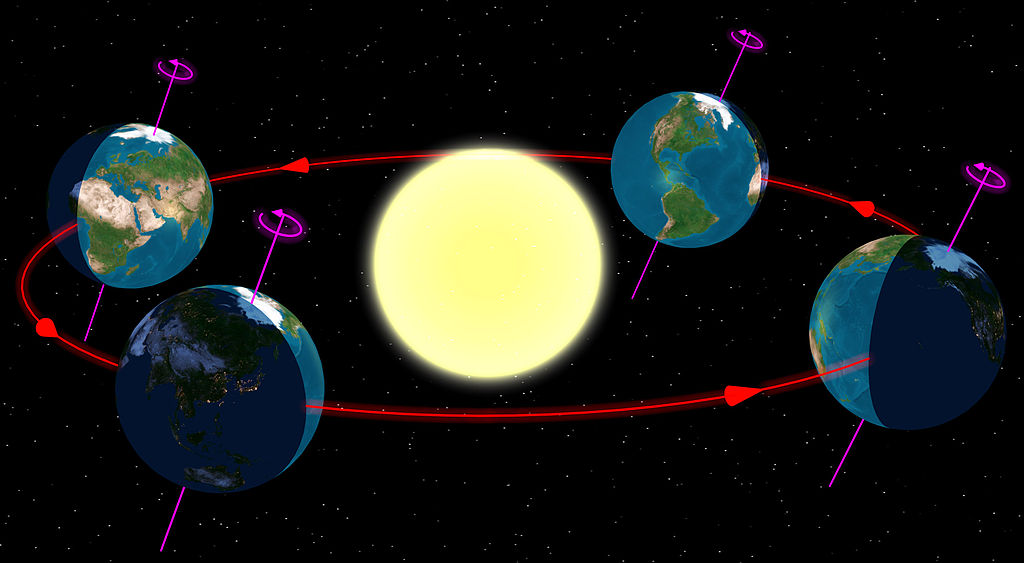 |
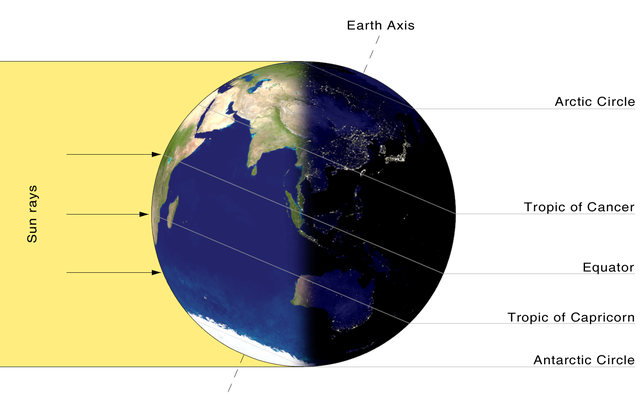 |
|---|---|---|
The Earth's spin angular momentum is conserved and the north pole always points toward the north star. The Earth's tilt is more important than the distance from the sun for determining warmth.
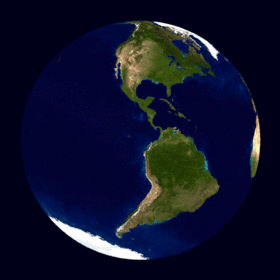 |
 |
|
|---|---|---|
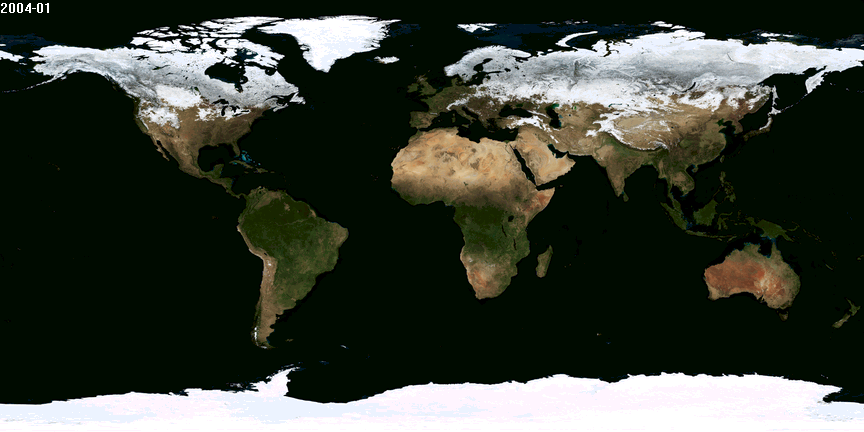 |
|
|---|---|
Earth maximum orbital distance (apocenter) = 1.017 AU Earth minimum orbital distance (pericenter) = .983 AU Solar intensity at 1 AU = 1 (scaled units) Solar intensity at apocenter = .967 (scaled units) Solar intensity at pericenter = 1.035 (scaled units) Apocenter intensity / Pericenter intensity = 1.070 Sun intensity in space = 1366 Watts/meter2 Earth surface, sun at zenith, clear day = 1050 Watts/meter2 Earth surface, average over day and night = 250 Watts/meter2 Earth tilt angle = 23 degrees Projected intensity at 0 degrees = cos( 0) = 1 Projected intensity at 23 degrees = cos(23) = .921 Projected intensity at 46 degrees = cos(46) = .695The change from projecting at 23 degrees exceeds the change from orbital ellipticity.
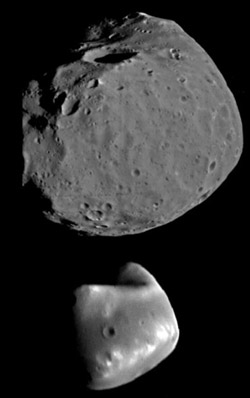 |
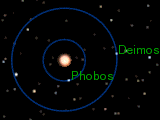 |
|---|---|
 |
|---|
Mass Radius Orbit Orbit Escape speed
(Earth=1) (km) (Mm) (km/s) (km/s)
Mars .1074 3390 - - 5.04
Phobos 2.5e-10 11.3 9.38 2.14 .0114
Deimos 1.8e-10 6.2 23.5 1.35 .0056
 |
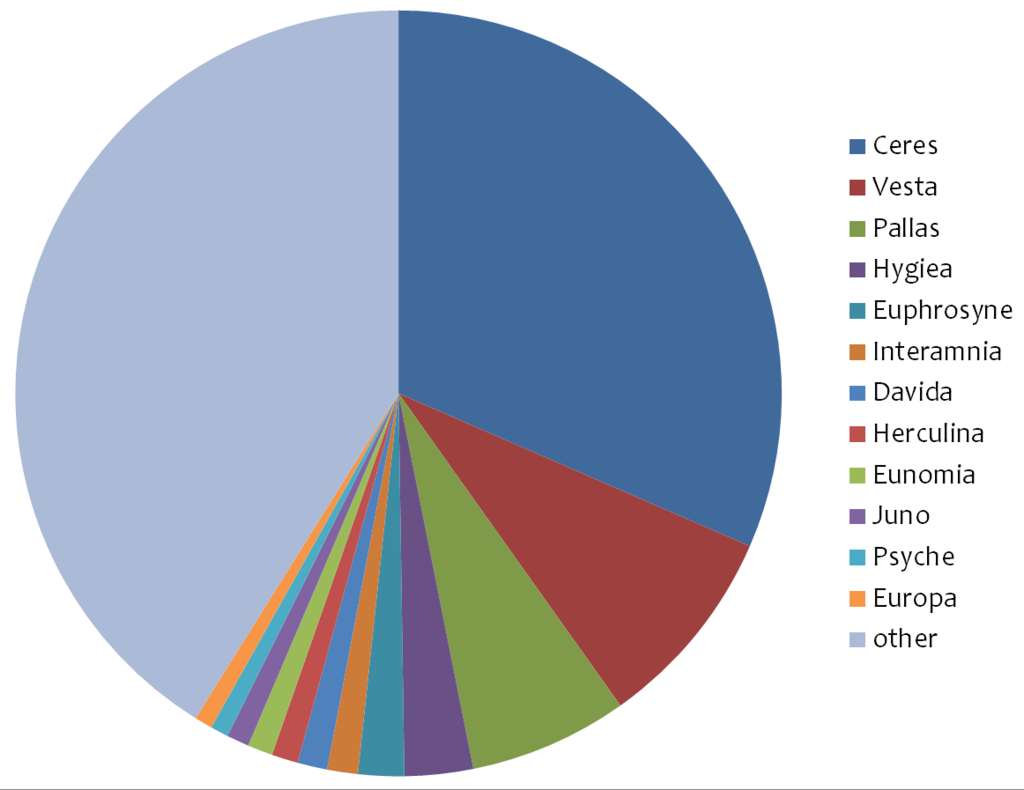 |
|---|---|
 |
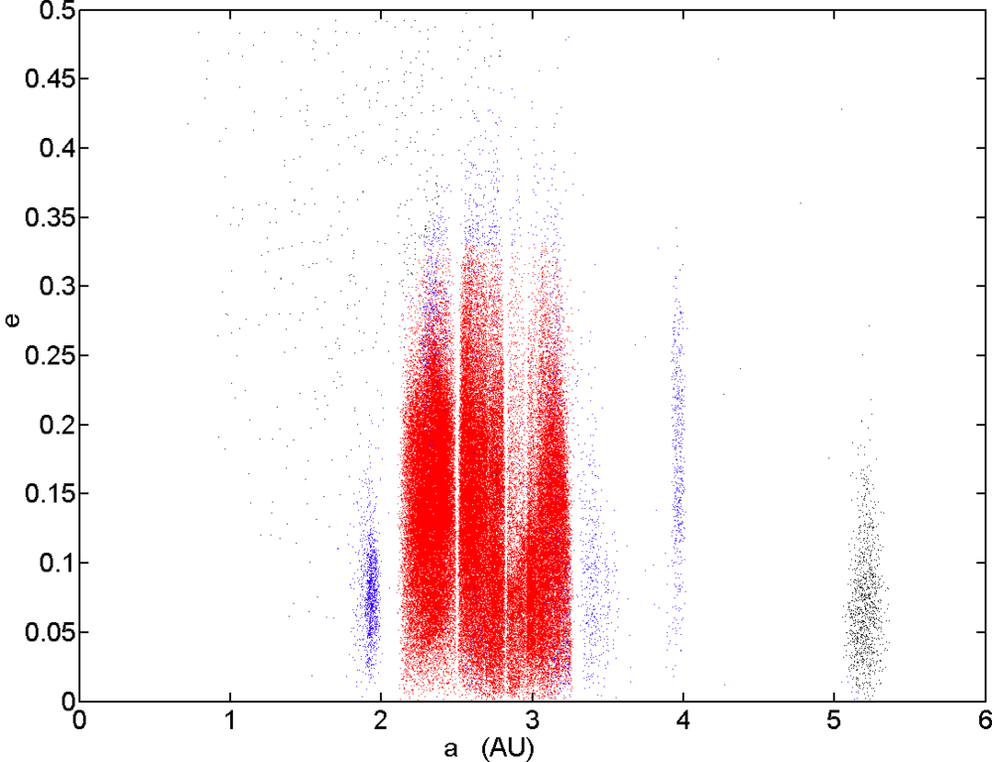 |
|---|---|
 |
 |
|---|---|
The plot of inclination vs. eccentricity shows a set of asteroid families, which resulted from the breakup of larger asteroids.
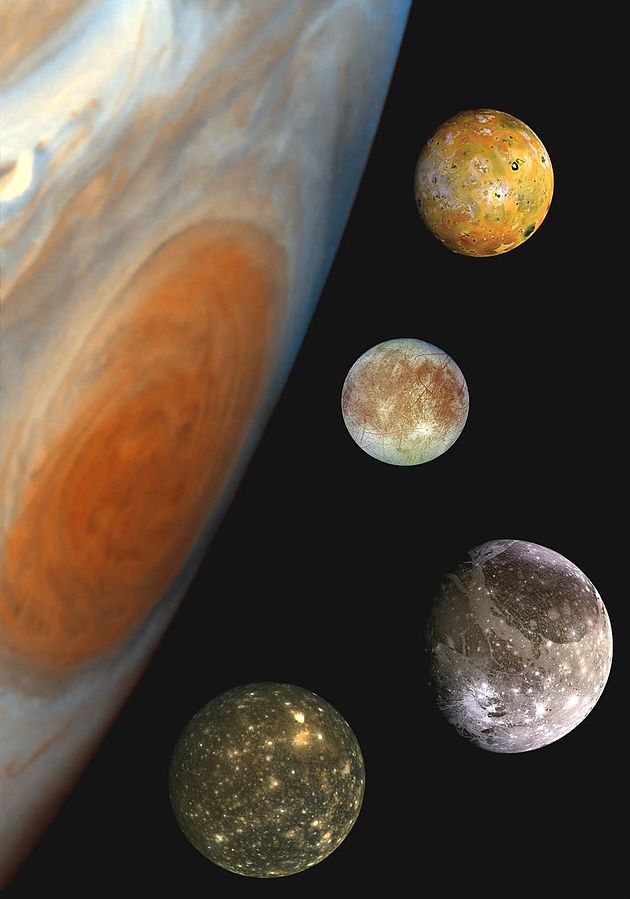 |
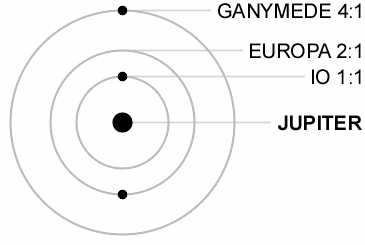 |
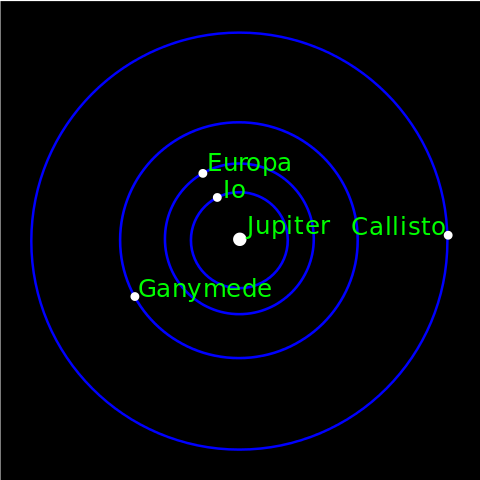 |
|---|---|---|
Io, Europa, and Ganymede are all tidally locked with Jupiter and they orbit in a 1:2:4 resonance. If the moons were alone, the tidal lock would be perfect and the moons would experience no tidal heating. Since the moons jostle each other's orbits, the tidal lock isn't perfect and tides heat the moon's interiors. Io is heated most and is intensely volcanic. Europa's tidal heating gives rise to a subsurface ocean.
Mass Diameter Orbit Orbit
(e18 kg) (km) (Mm) speed
(km/s)
Amalthea 2.08 180 .18 26.57
Io 89319 3640 .422 17.33
Europa 48000 3122 .671 13.74
Ganymede 148190 5262 1.07 10.88
Callisto 107590 4821 1.88 8.20
Himalia 6.70 170 11.4 3.31
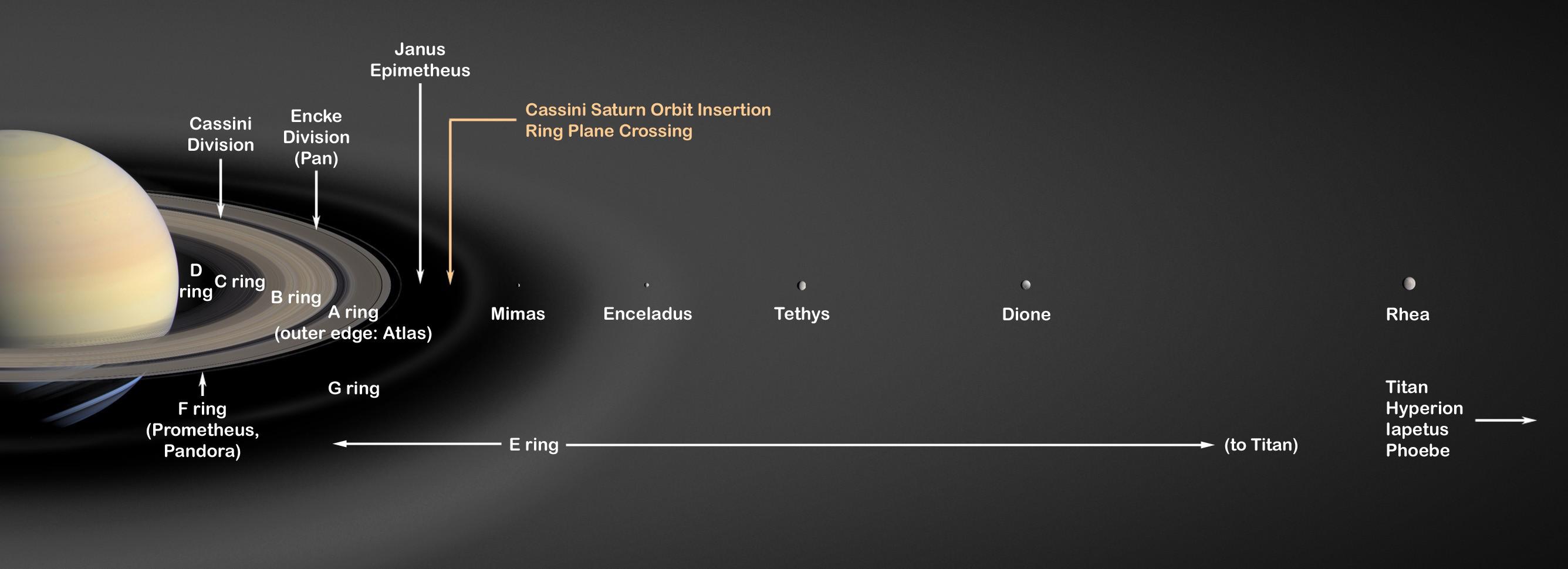 |
|---|
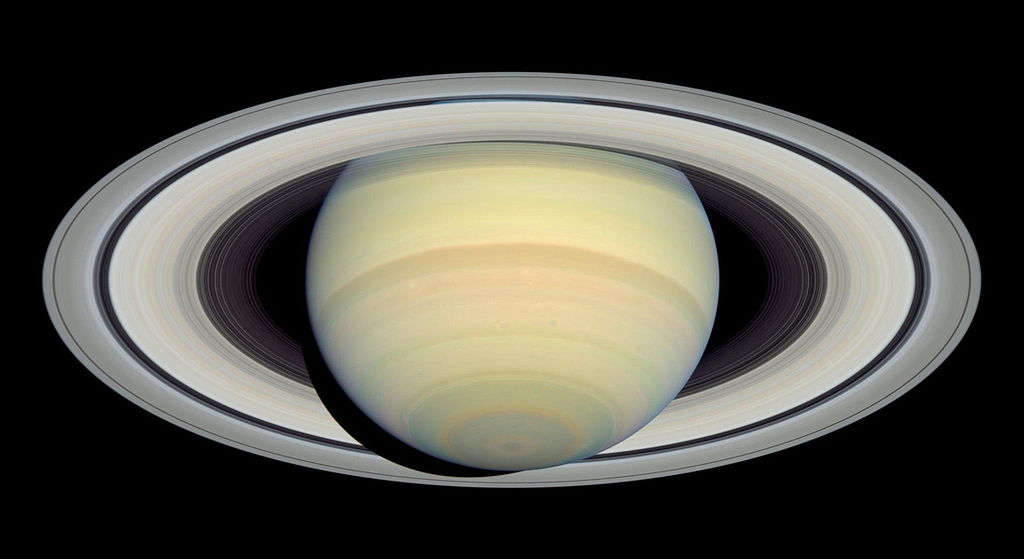 |
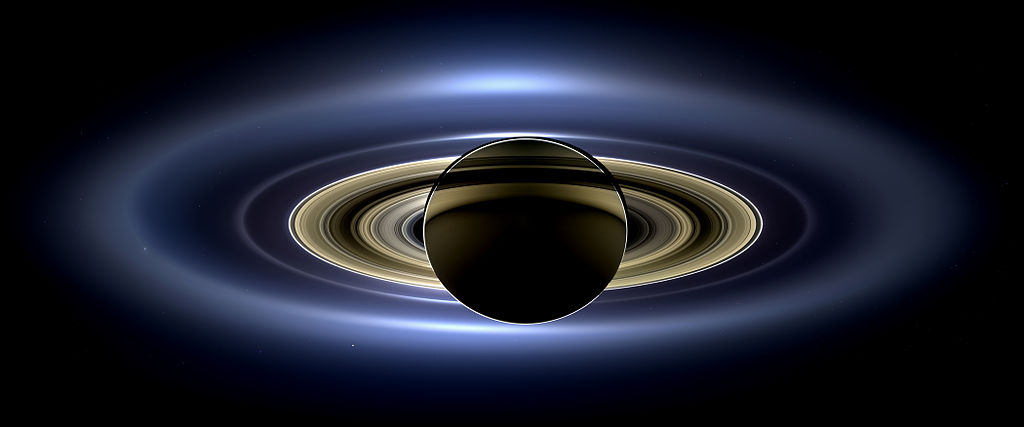 |
|---|---|
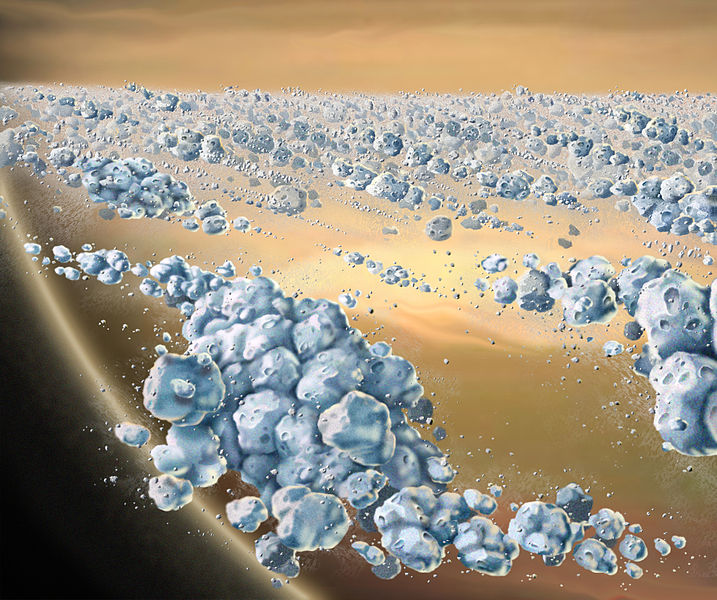 |
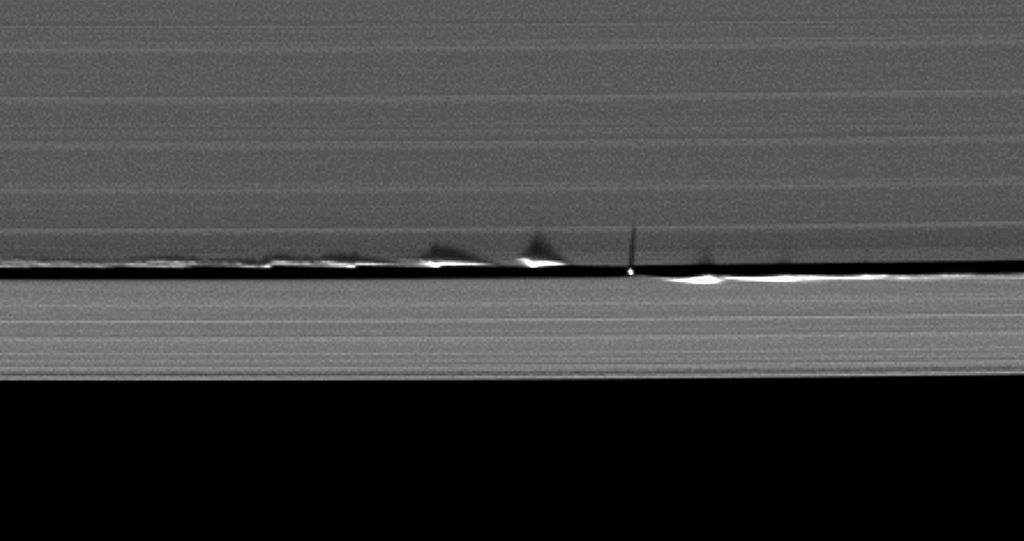 |
 |
|---|---|---|
Mass Diameter Orbit Orbit speed
(e18 kg) (km) (Mm) (km/s)
Janus 1.90 179 .151
Mimas 37 396 .185
Enceladus 110 504 .238
Tethys 620 1062 .295
Dione 1100 1123 .377
Rhea 2300 1527 .527 8.48
Titan 135000 5150 1.22 5.58
Hyperion 5.6 270 1.48
Iapetus 1800 1470 3.56 3.26
Phoebe 8.3 213 12.9
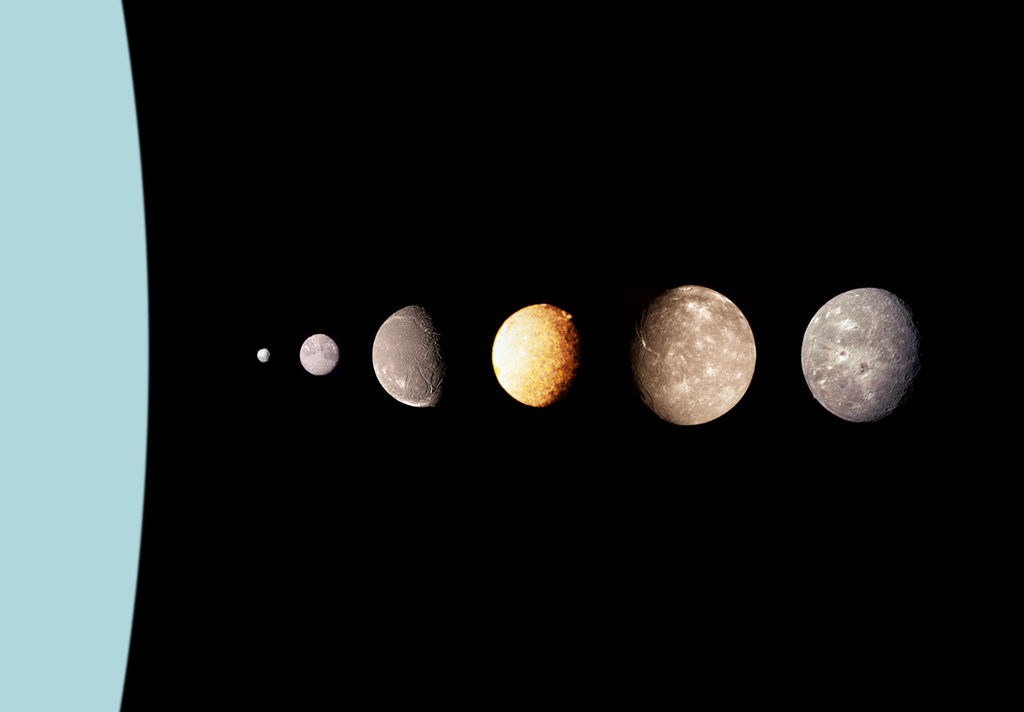 |
|---|
Mass Diameter Orbit Orbit
(e18 kg) (km) (Mm) speed
(km/s)
Portia 1.70 135 .066 9.37
Puck 2.9 162 .086 8.21
Miranda 66 472 .129 6.66
Ariel 1353 1158 .191 5.51
Umbriel 1172 1169 .266 4.67
Titania 3527 1577 .436 3.64
Oberon 3014 1522 .584 3.15
Sycorax 2.3 150 12.2
 |
|---|
Mass Diameter Orbit Orbit
(e18 kg) (km) (Mm) speed
(km/s)
Despina 2.10 150 .053
Galatea 2.12 176 .062
Larissa 4.6 194 .074
Proteus 44 420 .118 7.62
Triton 21408 2705 .355 4.39
Nereid 27 340 5.51 .93
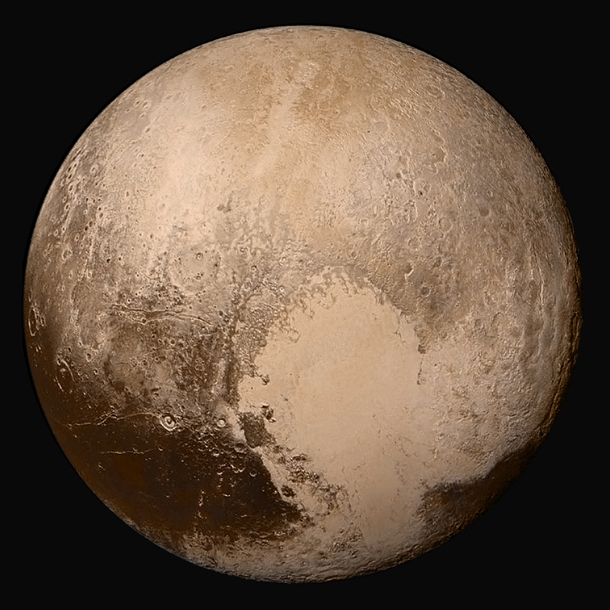 |
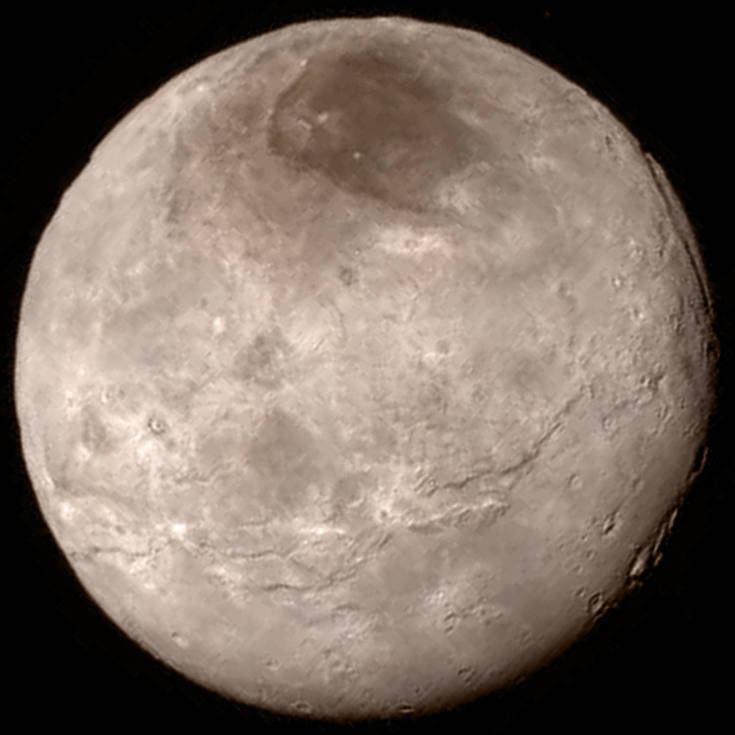 |
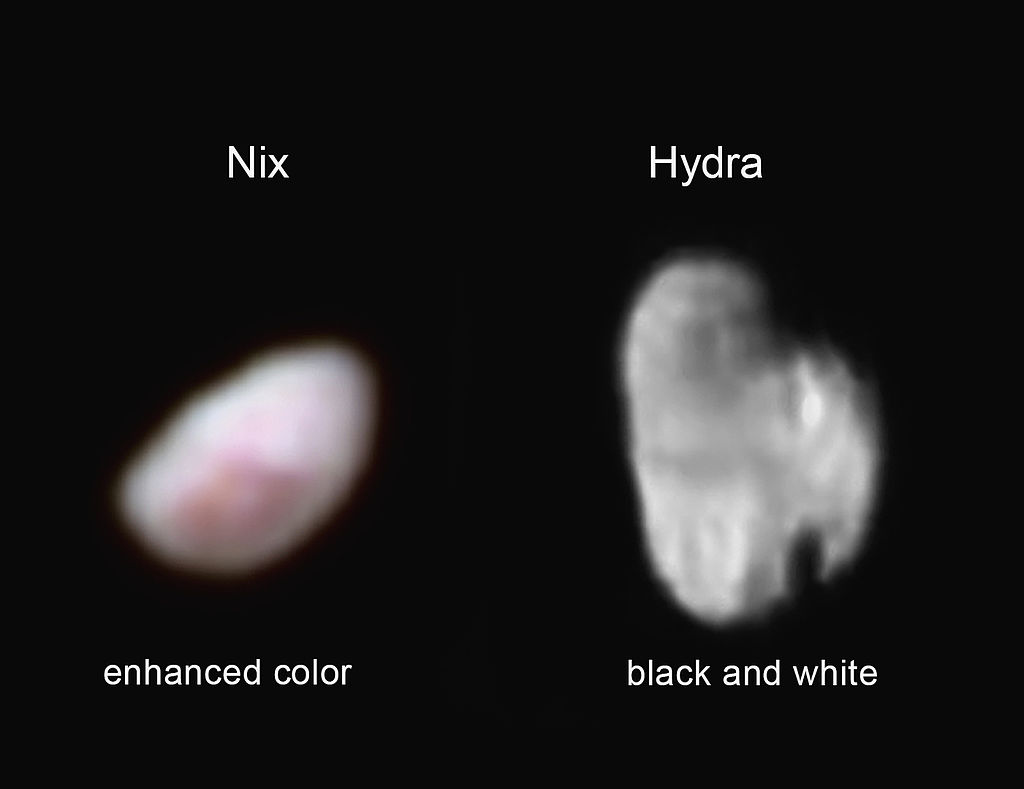 |
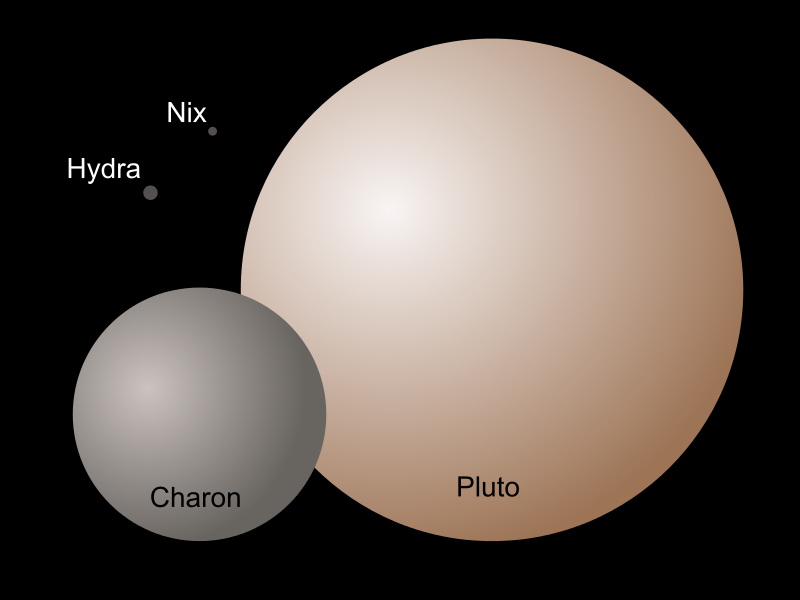 |
|---|---|---|---|

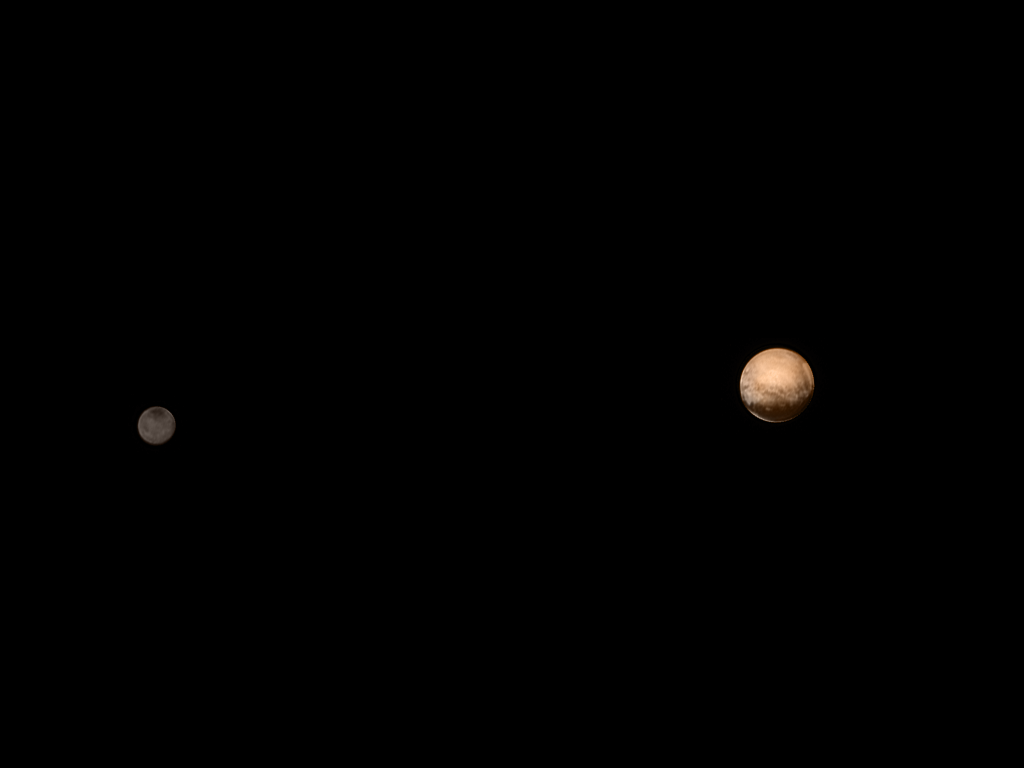 |
 |
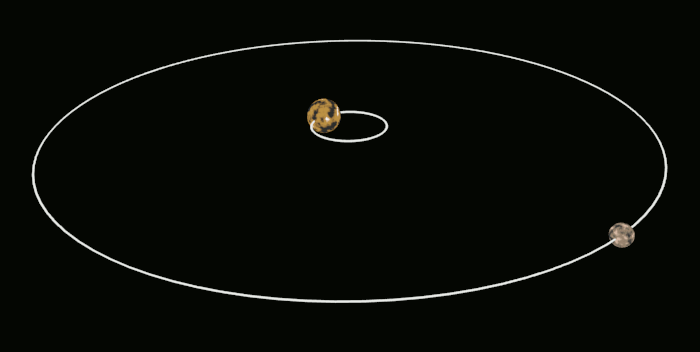 |
|---|---|---|
Pluto Orbit 10*HillRadius Radius Density Eccentricity Inclination
masses (Pluto (Pluto radii) (km) (g/cm2) (deg)
radii)
Pluto 1 1170 2.03
Charon .0490 15.2 38.6 604 1.65 0 .001
Styx tiny 36.4 ~0 ~0
Nix <.00006 42.2 < 11.7 .0030 .195
Kerbero tiny 51.1 ~0 ~0
Hydra <.00006 56.1 < 15.6 .0051 .212
Pluto radius = 1153 km Pluto mass = 1.305e22 kg
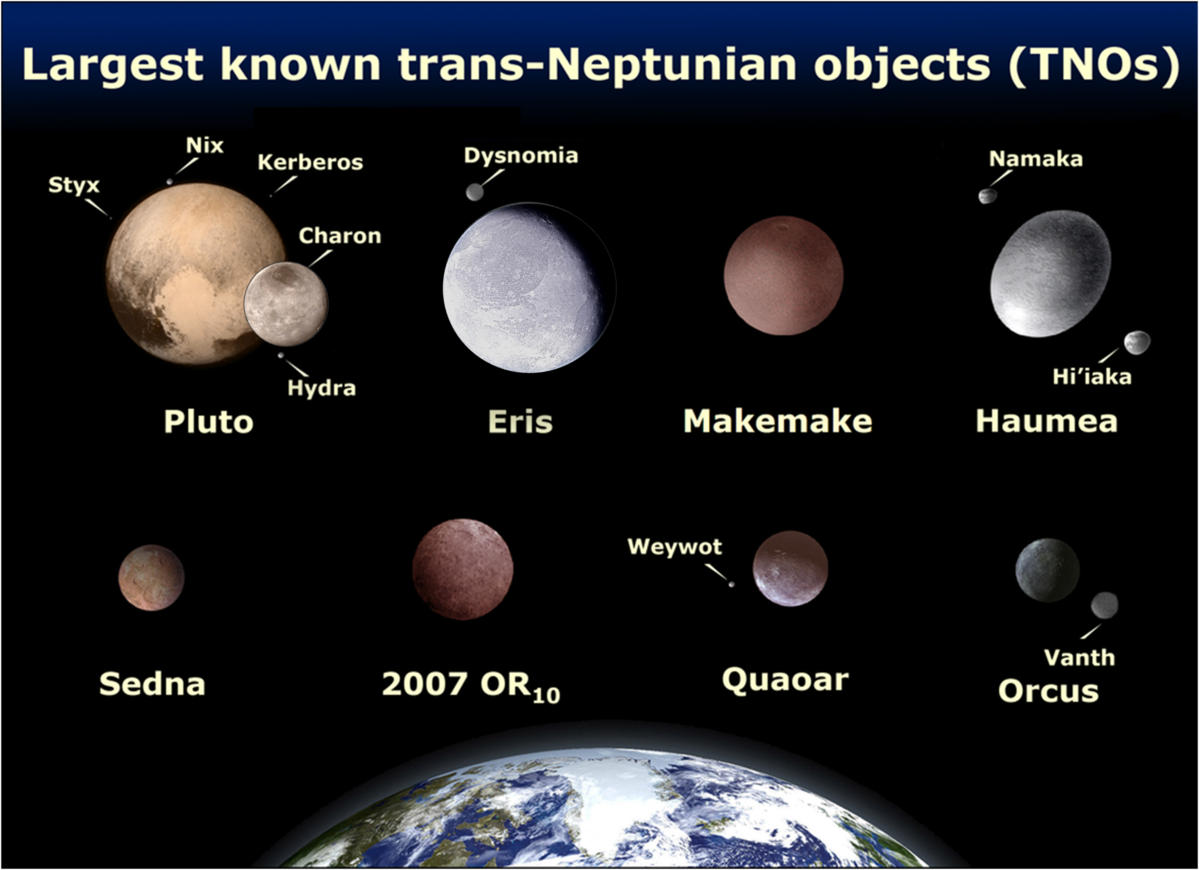 |
|---|
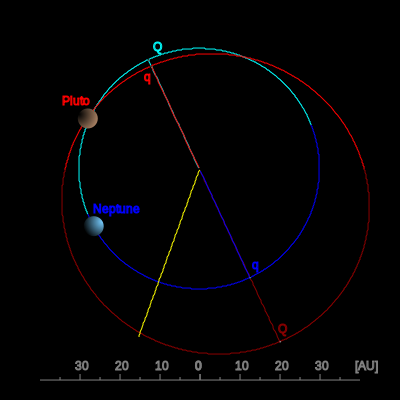 |
 |
|---|---|
 |
 |
|---|---|
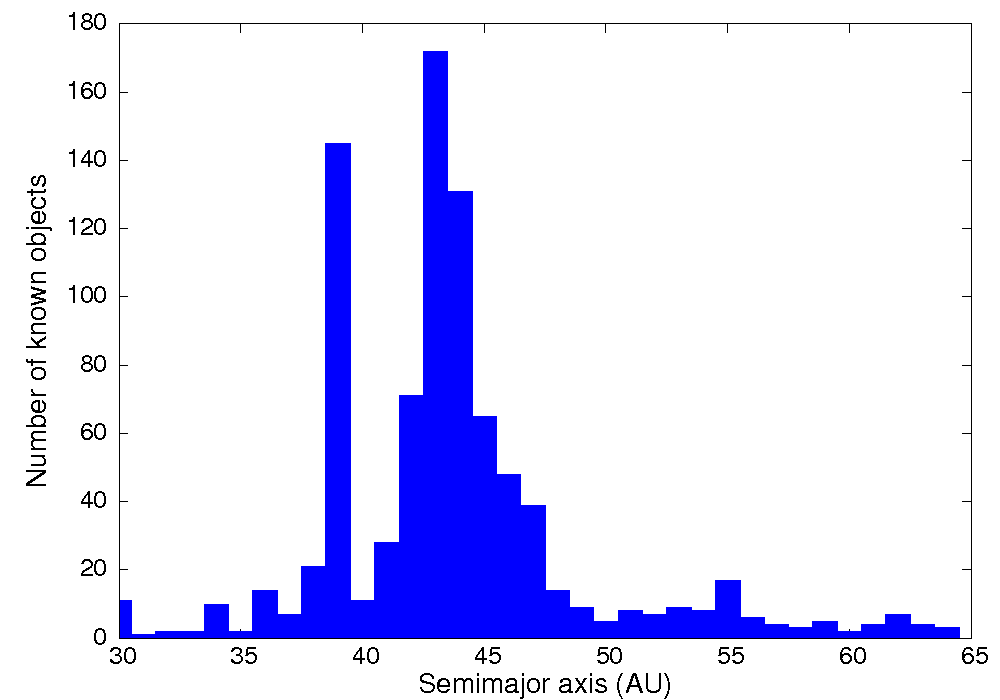 |
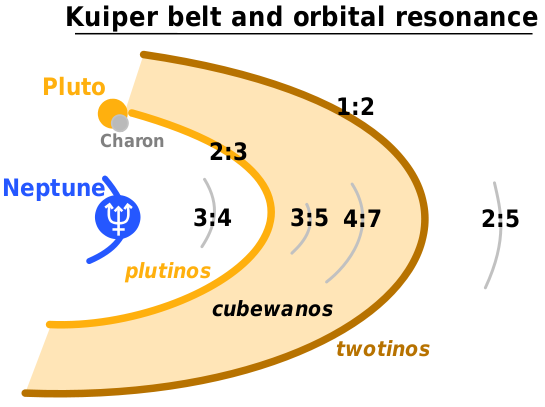 |
|---|---|
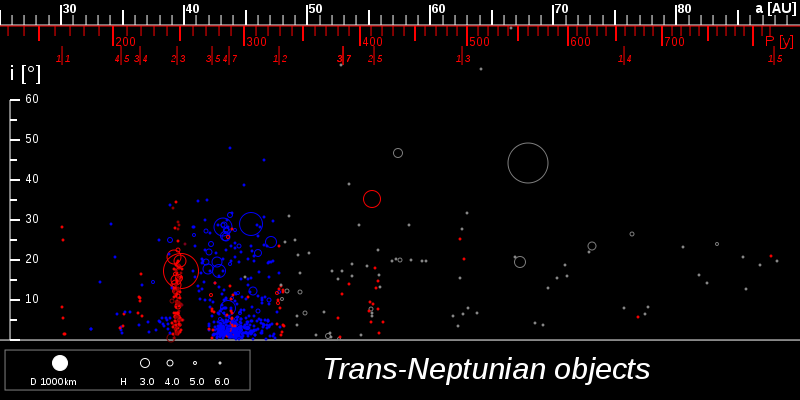 |
|---|
The largest Kuiper belt objects are listed below, along with Neptune for comparison.
Semi major Earth
axis (AU) masses
Neptune 30.07 17.20
Eris 67.67 .00278
Pluto 39.48 .00220
Haumea 43.22 .00070
Makemake 45.79 .0007
2007OR10 66.99 .0005
Quaoar 43.37 .00023
Sedna 506.2 .0002
Orcus 39.47 .000108
Most of the objects in the Kuiper belt were thrown there by the gas giants.
A planet's ability to throw objects into the outer solar system is given by
the ratio of the escape velocity to the orbital velocity. The gas giants
are sufficiently large and the rocky planets aren't, nor are Pluto and Eris.
Semimajor Mass Escape Orbit Escape speed
axis (AU) (Earth=1) speed speed / Orbit speed
(km/s) (km/s)
Mercury .387 .0553 4.3 47.9 .09
Venus .723 .8150 10.46 35.0 .30
Earth 1.000 1.0000 11.2 29.8 .38
Mars 1.524 .1074 5.03 24.1 .21
Jupiter 5.203 317.83 59.5 13.1 4.54
Saturn 9.537 95.16 35.5 9.64 3.68
Uranus 19.19 14.50 21.3 6.81 3.13
Neptune 30.07 17.20 23.5 5.43 4.33
Pluto 39.48 .00220 1.23 4.74 .26
Eris 67.67 .00278 1.34 3.44 .39
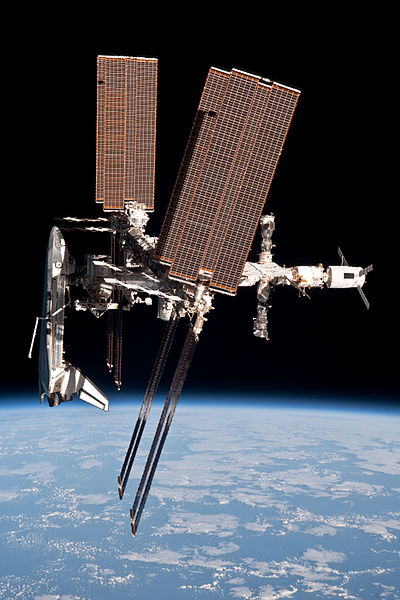 |
 |
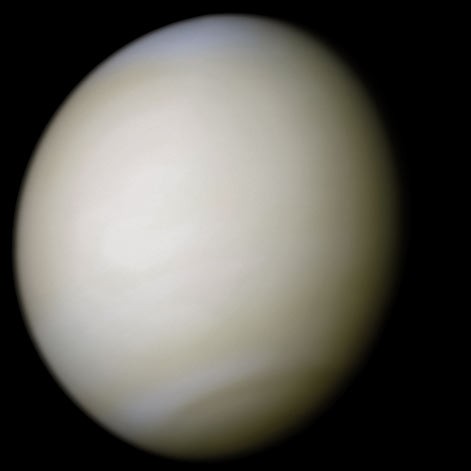 |
 |
|---|---|---|---|
Density Pressure Column Temp Height Escape Gravity N2 O2 N2 CO2 Ar
kg/m3 Bar ton/m2 Kelvin km km/s m/s2 kg/m3 frac frac frac frac
Venus 67 92.1 1000 735 16 10.36 8.87 2.34 0 .035 .965
Titan 5.3 1.46 120 94 30 2.64 1.35 5.22 0 .984
Earth 1.2 1 10 287 8 11.2 9.78 .94 .209 .781 .00039 .0093
Mars .020 .0063 .16 210 11 5.03 3.71 .00054 .0013 .027 .953 .016
No other object in the solar system has a meaningful atmosphere, except for the gas giants.
Titan is the smallest object with an atmosphere and Mercury is the largest object without an atmosphere.
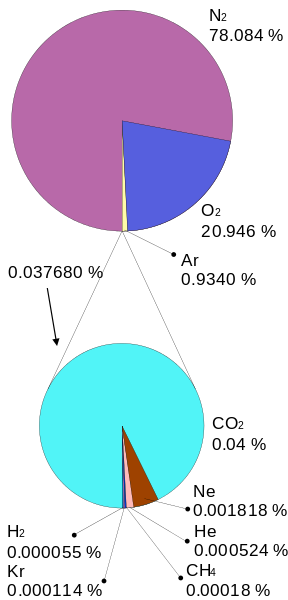 |
|---|
Gas Concentration Contribution
(ppm by volume) to warming
H2O 36-72%
CO2 394 9-26%
CH4 1.79 4-9%
O3 <=.07 3-7%
 |
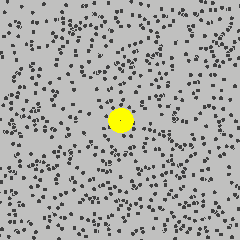 |
|---|---|
M = Mass of a gas molecule P = Pressure T = Temperature Vol= Volume N = Number of gas molecules within the volume D = Density in kg/m3 = N M / Vol k = Boltzmann constant = 1.38*10-23 Joules/Kelvin Mol= Number of moles of gas molecules = N /6.62*1023 V = Characteristic thermal speed of gas molecules E = Mean kinetic energy of a gas molecule = 1/2 M V2Ideal gas law:
P = k T N / Vol = 2/3 N E / Vol = 1/3 N M V2 / Vol = 1/3 D V2 = 8.3 Moles TFor a system in thermodynamic equilibrium each degree of freedom has a mean energy of .5 k T.
A gas molecule moving in 3 dimensions has 3 degrees of freedom and so the mean kinetic energy is
E = 3 * .5 k T = 1.5 k TThis is also equal to the mean kinetic energy of a gas molecule.
E = .5 M V2Hence
k T = 2/3 E
Gamma = Adiabatic constant
= 7/5 for diatomic molecules such as H2, O2, N2. Air also has Gamma=7/5
= 5/3 for monatomic molecules such as Helium and Xenon
The sound speed for an ideal gas is
SoundSpeed2 = Gamma P / Density
= 1/3 Gamma V2
For air,
Gamma = 7/5
SoundSpeed = .63 ThermalSpeed
= 343 meters/second at 20 Celsius
Gas properties simulation
The "Balloons and Buoyancy" simulation at phet.colorado shows a gas with a mix of light and heavy molecules.
S = Escape speed
T = Temperature
k = Boltzmann constant
= 1.38e-23 Joules/Kelvin
g = Planet gravity at the surface
M = Mass of heavy molecule m = Mass of light molecule
V = Thermal speed of heavy molecule v = Thermal speed of light molecule
E = Mean energy of heavy molecule e = Mean energy of light molecule
H = Characteristic height of heavy molecule h = Characteristic height of light molecule
= E / (M g) = e / (m g)
Z = Energy of heavy molecule / escape energy z = Energy of light molecule / escape energy
= .5 M V2 / .5 M S2 = .5 m v2 / .5 m S2
= V2 / S2 = v2 / S2
For an ideal gas, all molecules have the same mean kinetic energy.
E = e = 1.5 k T
.5 M V2 = .5 m v2 = 1.5 k T
The light molecules tend to move faster than the heavy ones. This is why
your voice increases in pitch when you breathe helium. Breathing a heavy gas such
as Xenon makes you sound like Darth Vader.
For an object to have an atmosphere, the thermal energy must be much less than the escape energy.
V2 << S2 <-> Z << 1
Escape Atmos Temp H2 N2 Z Z
speed density (K) km/s km/s (H2) (N2)
km/s (kg/m2)
Jupiter 59.5 112 1.18 .45 .00039 .000056
Saturn 35.5 84 1.02 .39 .00083 .00012
Neptune 23.5 55 .83 .31 .0012 .00018
Uranus 21.3 53 .81 .31 .0014 .00021
Earth 11.2 1.2 287 1.89 .71 .028 .0041
Venus 10.4 67 735 3.02 1.14 .084 .012
Mars 5.03 .020 210 1.61 .61 .103 .015
Titan 2.64 5.3 94 1.08 .41 .167 .024
Europa 2.02 0 102 1.12 .42 .31 .044
Moon 2.38 0 390 2.20 .83 .85 .12
Pluto 1.21 0 44 .74 .28 .37 .054
Ceres .51 0 168 1.44 .55 8.0 1.14
Even if an object has enough gravity to capture an atmosphere it can still lose it
to the solar wind. Also, the upper atmosphere tends to be hotter than at the
surface, increasing the loss rate.
Titan is the smallest object with a dense atmosphere, suggesting that the threshold for capturing an atmosphere is on the order of Z = 1/25, or
Thermal Speed < 1/5 Escape speed
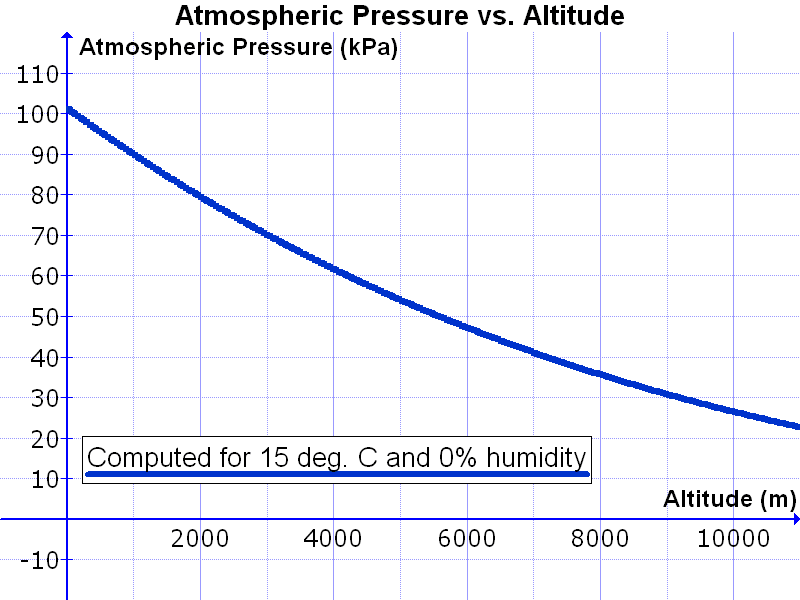 |
|---|
M = Mass of a gas molecule V = Thermal speed E = Mean energy of a gas molecule = 1/2 M V2 H = Characteristic height of an atmosphere g = Gravitational accelerationSuppose a molecule at the surface of the Earth is moving upward with speed V and suppose it doesn't collide with other air molecules. It will reach a height of
M H g = 1/2 M V2This height H is the characteristic height of an atmosphere.
Pressure of air at sea level = 1 Bar Pressure of air in Denver = .85 Bar One mile high Pressure of air at Mount Everest = 1/4 Bar 10 km highThe density of the atmosphere scales as
Density ~ (Density At Sea Level) * exp(-E/E0)where E is the gravitational potential energy of a gas molecule and E0 is the characteristic thermal energy given by
E0 = M H g = 1/2 M V2Expressed in terms of altitude h,
Density ~ Density At Sea Level * exp(-h/H)For oxygen,
E0 = 3/2 * Boltzmann_Constant * TemperatureE0 is the same for all molecules regardless of mass, and H depends on the molecule's mass. H scales as
H ~ Mass-1
The solar wind consists primarily of protons moving at ~ 600 km/s. The density of protons at Earth orbit is ~ 7 /cm3.
 |
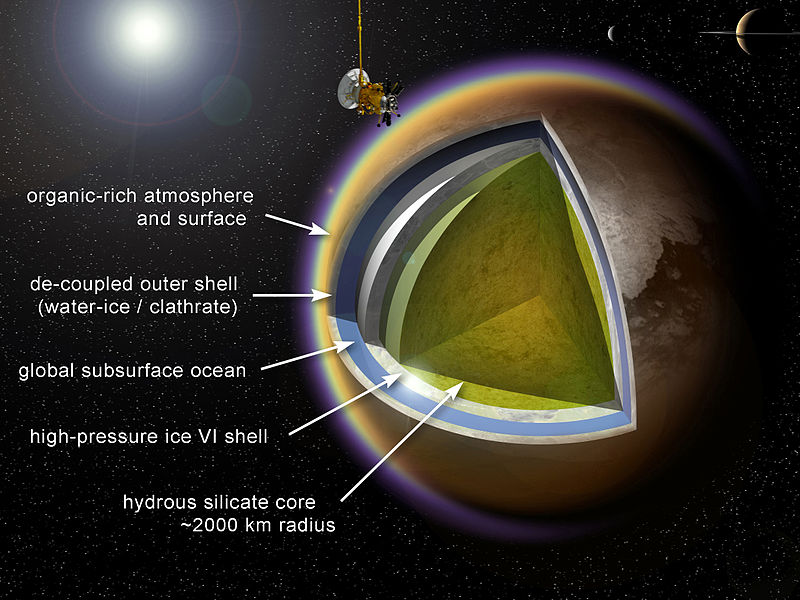 |
|---|---|
Dist from Mass H2O H2O Density
sun (AU) (Earth=1) (Earth=1) frac (g/cm3)
Mercury .39 .055 - - 5.60
Venus .72 .82 - - 5.20
Earth 1.00 1.00 .00025 .00025 5.52
Moon 1.00 .0123 - - 3.35
Mars 1.52 .107 .00000027 .0000025 3.95
Phobos 1.52 1.88
Deimos 1.52 1.47
Vesta 2.36 .0000447 - - 3.42
Ceres 2.77 .00016 .000033 .21 2.08
Pallas 2.77 .0000359 - - 2.8
Io 5.20 .0150 - - 3.528
Europa 5.20 .0080 .0033 .4 3.103
Ganymede 5.20 .0248 .012 .5 1.942
Callisto 5.20 .0180 .0084 .5 1.834
Pan 9.54 8.3e-10 .42
Mimas 9.54 .0000063 1.15
Titan 9.54 .0225 .012 .5 1.88
Triton 30.07 .00358 .00067 ~.2 2.061
Pluto 39.48 .00220 2.03
Charon 39.48 .000271 1.72
Jupiter 5.20 317.83 1.326
Saturn 9.54 95.16 .687
Uranus 19.19 14.50 1.270
Neptune 39.48 17.20 1.638
Ceres has an ocean's worth of H2O.
Ceres H2O / Earth H2O = .13
Earth mass = 5.972e24 kg
Oceans .954 Ice caps and glaciers .024 Lakes and rivers .006 Underground .016 Atmosphere .00001
Planet Metal & H2O Gas Density H2O
mass rock (g/cm3) frac
Ceres .00016 .00013 .000033 0 2.08 .21
Europa .0080 .005 .0033 0 3.103 .4
Mars .107 .107 .00000027 .000000004 3.95 .0000025
Earth 1 1 .00025 .0000009 5.52 .00025
Jupiter 317.9 12-45 Most of it 1.33
Saturn 95.2 9-22 Most of it .69
Uranus 14.5 0.5-3.7 9.3-13.5 .5-1.5 1.27 3/4
Neptune 17.2 1.2 10-15 1.0-2.0 1.64 3/4
Masses in Earth masses
Mean
Temperature Min Max Parent Albedo
(K) (K) (K) planet
Mercury 340 100 700
Venus 735 735 735
Earth 288 184 330
Moon 220 100 390
Mars 210 130 308
Ceres 168 ? 235
Europa 102 50 125 Jupiter
Ganymede 110 70 152 Jupiter
Callisto 134 80 165 Jupiter
Titan 94 Saturn
Titania 70 60 89 Uranus
Oberon 75 Uranus
Nitrogen freeze 63
Oxygen freeze 54
Triton 38 Neptune .76
Nereid 50 Neptune .155
Pluto 44 33 55 .58
Hydrogen freeze 14
The boundary between rocky and icy objects is at Ceres' orbit.
The boundary for frozen nitrogen is at Neptune's orbit.
Freeze Boil Heat Capacity Density
(Kelvin) (Kelvin) (J/g/Kelvin) (g/cm3)
Water 273 373 4.2 1.00
Ammonia 195 240 4.7 .73
Methane 91 112 1.6 .42
Ethanol 159 351 2.4 .79
Ethane 89 184 .55
Propane 86 281 .58
Hydrogen 14.0 20.3
Nitrogen 63.2 77.4
Oxygen 54.4 90.2
CO 68
CO2 194.7 216.6
Argon 83.8
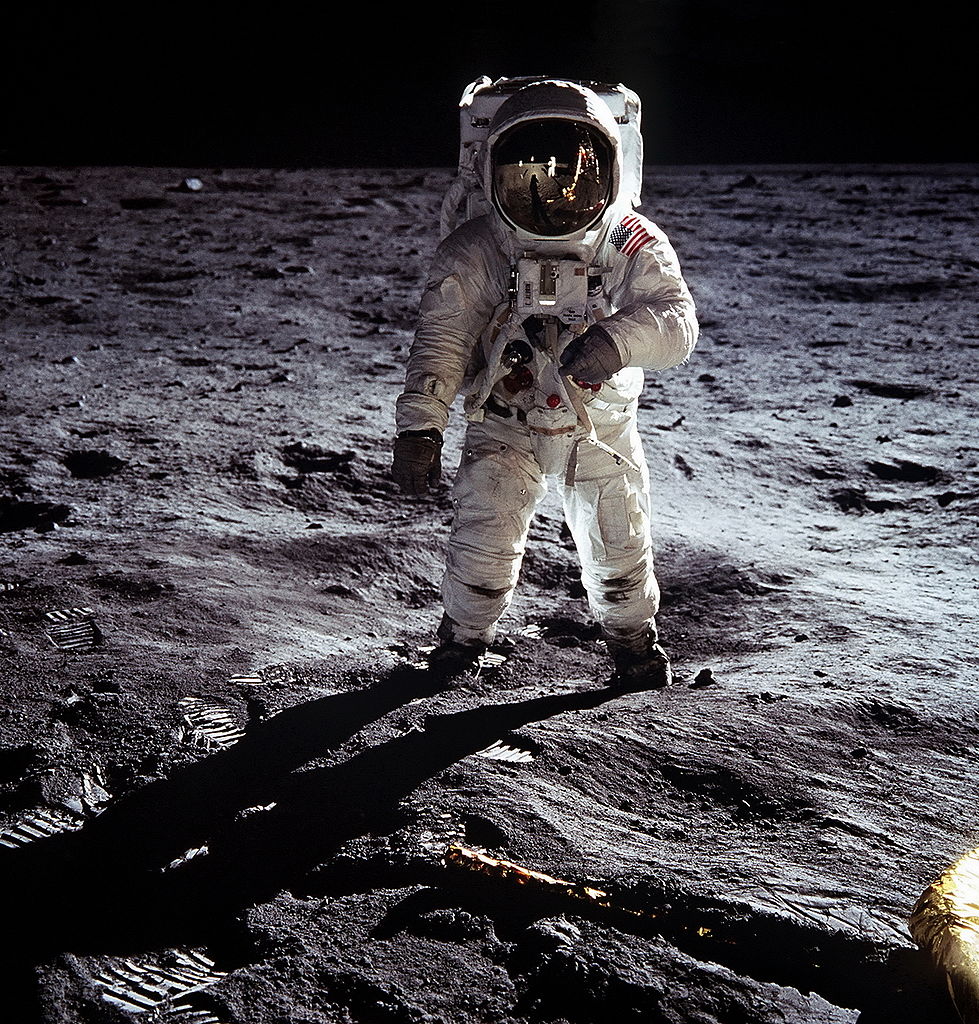 |
 |
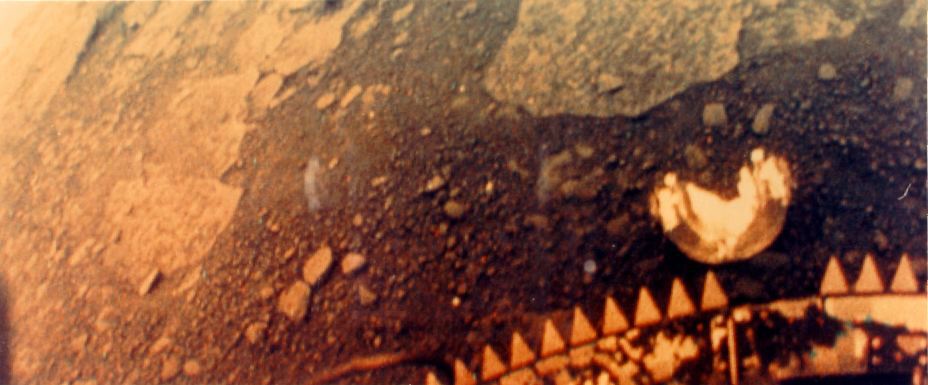 |
|---|---|---|
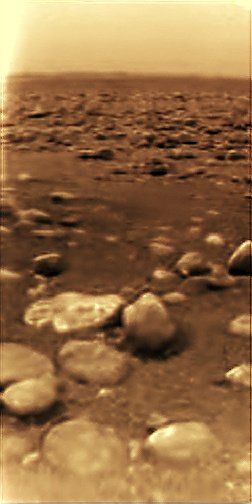 |
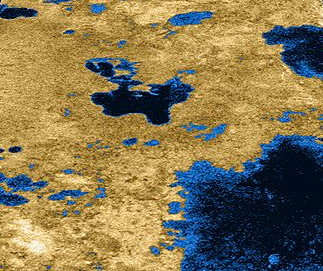 |
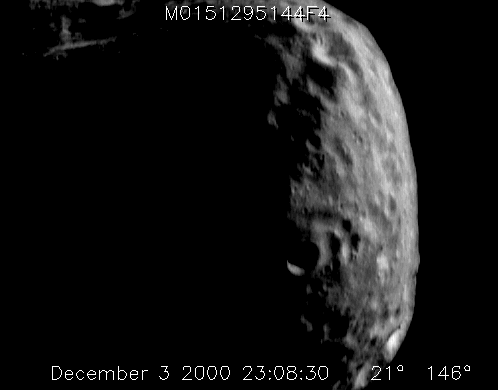 |
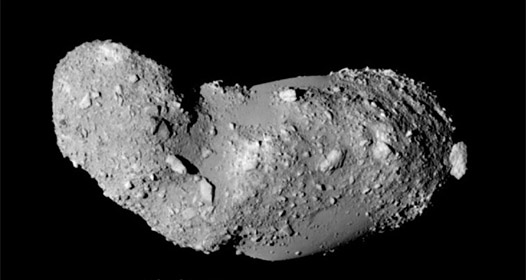 |
|---|---|---|---|
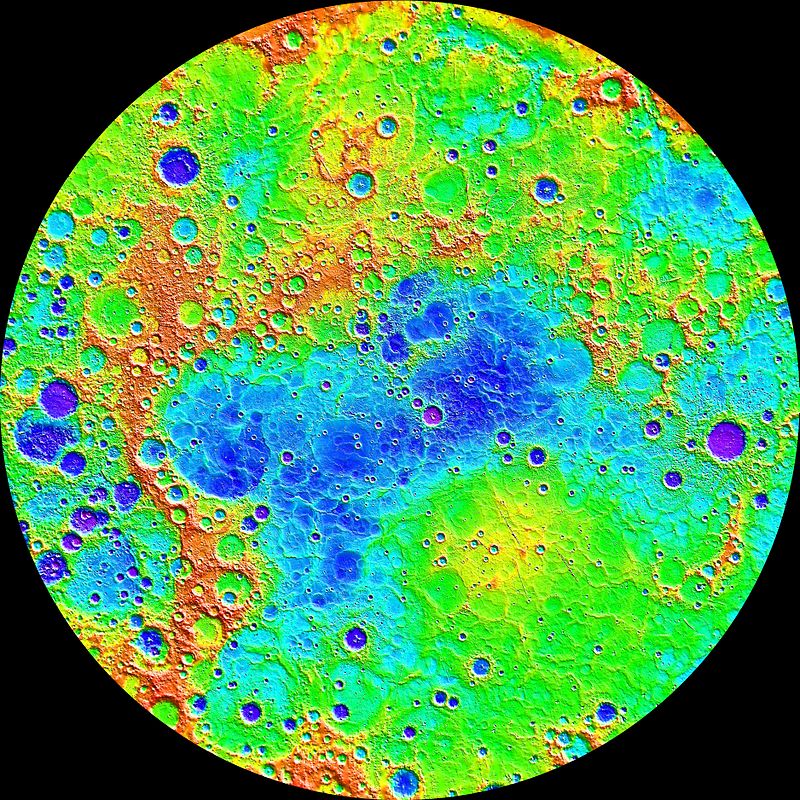 |
 |
|---|---|
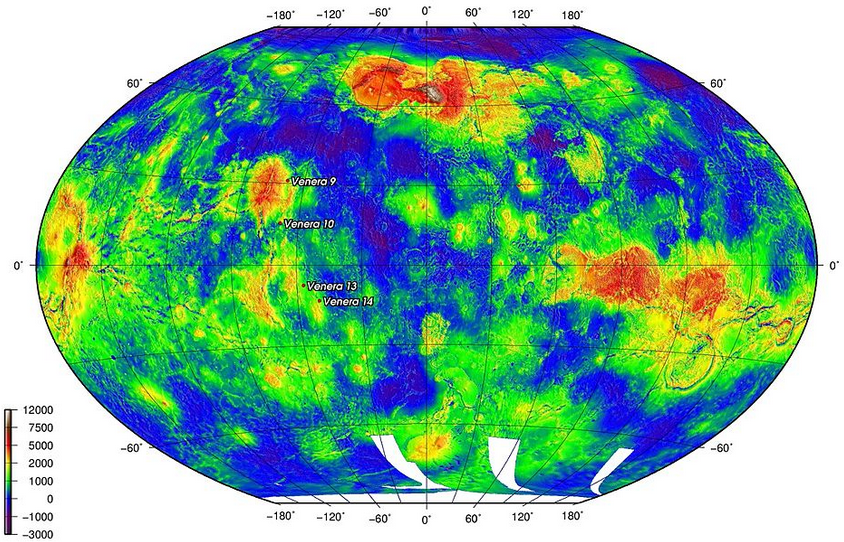 |
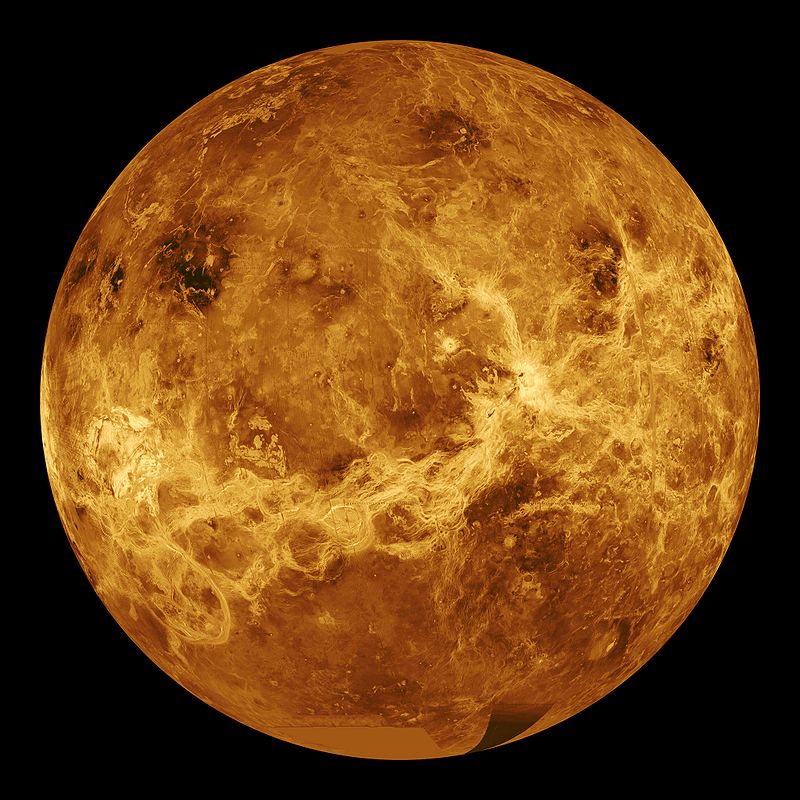 |
|---|---|
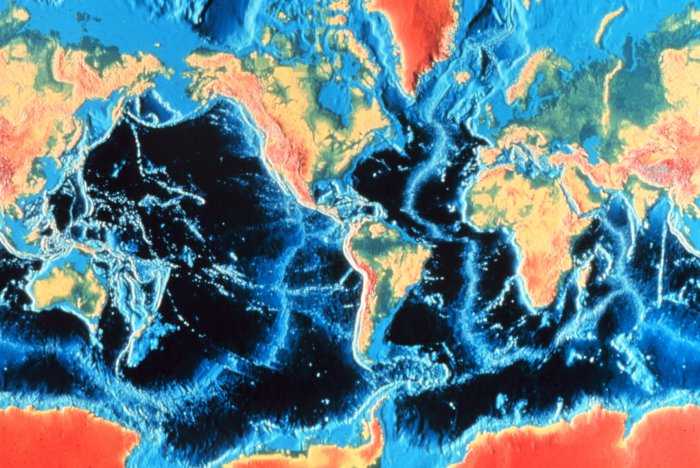 |
|---|
 |
.svg.png) |
|---|---|
_with_poles_HiRes.jpg) |
|---|
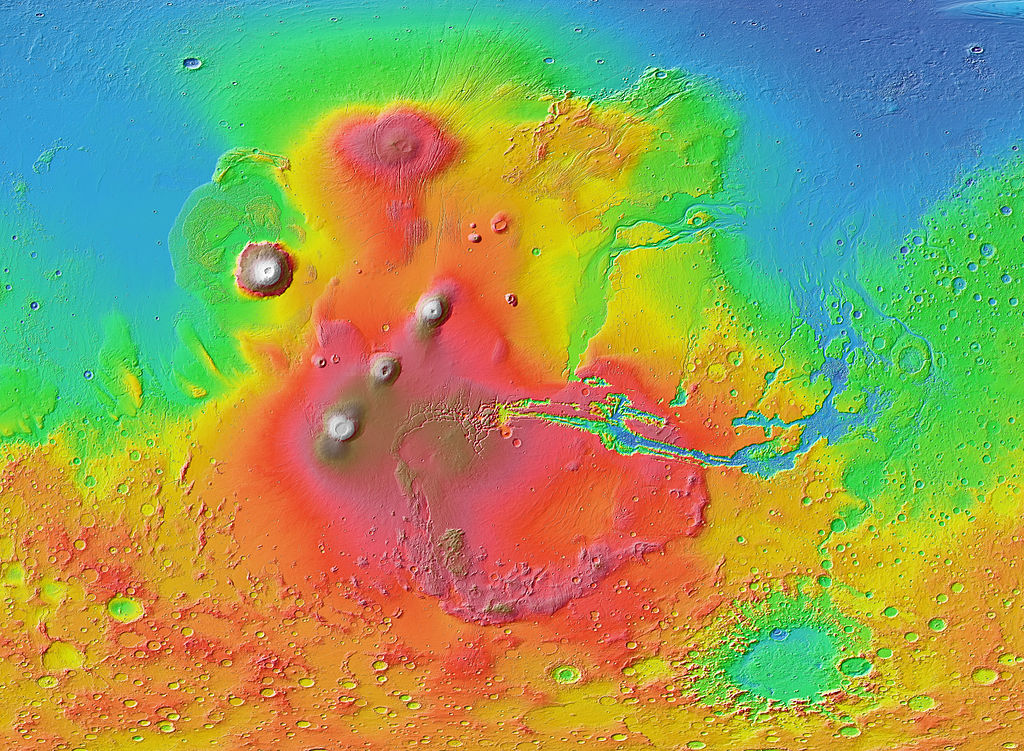 |
 |
|---|---|
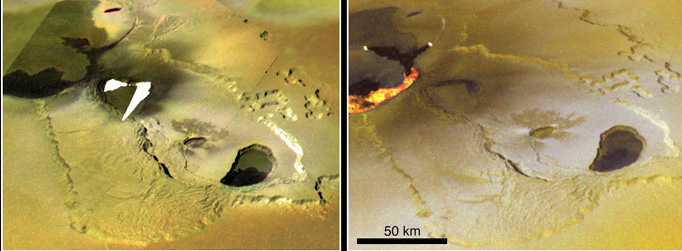 |
|---|
 |
|---|
Air at sea level .00127 Ice .92 Water 1.00 Rock ~ 2 Iron 7.9 Nickel 8.9 Metallic asteroids are composted of mostly iron and nickel Lead 11.3 Uranium 19.1 Gold 19.3 Osmium 22.6 Densest element White dwarf e9 Atomic nuclei 2e17 Neutron star 2e17 Planck density 5.1e96
D = Density R = Radius M = Mass = Density * Volume = 4/3 Pi D R3 A = Acceleration at the surface = G M / R2 = (4/3) π G D RAcceleration is proportional to R
Density Radius Gravity
g/cm3 (Earth=1) m/s2
Earth 5.52 1.00 9.8
Venus 5.20 .95 8.87
Uranus 1.27 3.97 8.69
Mars 3.95 .53 3.71
Mercury 5.60 .38 3.7
Moon 3.35 .27 1.62
Titan 1.88 .40 1.35
Ceres 2.08 .074 .27
 |
|---|
If a mountain gets too high, pressure deforms the rock and the mountain sags. The height of a mountain is limited by the tensile strength of the rock. For a stout rock such as granite this is ~ 100 MegaPascals (Newton / meter2). The density of granite is ~ 3000 kg/m3.
The pressure at the base of a mountain is
Pressure = RockDensity * Gravity * HeightThe height that gives a pressure of 100 MegaPascals is
Height ~ 103 N/m2 / 10 m/s2 / 3000 kg/m3 ~ 3 km
Gravity Radius Tallest mountain Mountain/Radius
(m/s2) (km) (km) (km/km)
Earth 9.8 6371 8.9 .0014 Mount Everest
Venus 8.9 6052 8 .0013 Volcanic
Mercury 3.7 2440 10 .0041
Mars 3.7 3386 21.2 .0063 Mount Olympus. Previously volcanic
Io 1.80 1822 18 .0099 Supervolcanos
Moon 1.62 1738 7 .0040 No geological activity
Titan 1.35 2576 2 .0008 Ice mountains
Ceres .27 476 5 .0105 Ice mountains. Round
Pluto .66 1173 4 .0034 Ice mountains.
Vesta .25 265 Tall Not round
If a planet is substantially heavier than the earth and if it has enough
water for oceans, gravity might make it impossible for dry land to exist.
If we define the roundness of an object as the characteristic mountain height divided by the object's radius, then for the Earth,
Roundness ~ 10 km / 7*103 km ~ 10-3The surface gravity for equal-density objects is proportional to radius, hence the roundness of an object of radius R scales as
Roundness ~ 10-3 * (R / RadiusOfEarth)2For an object a tenth the size of the earth, the roundness is ~ 10-1. If we take this magnitude as the boundary between round and potato-shaped, then the smallest round objects should be a tenth the Earth's radius. The smallest round object in the solar system is Ceres, which has a radius of 487 km. The radius of the earth is ~ 6370 km.
 |
|---|
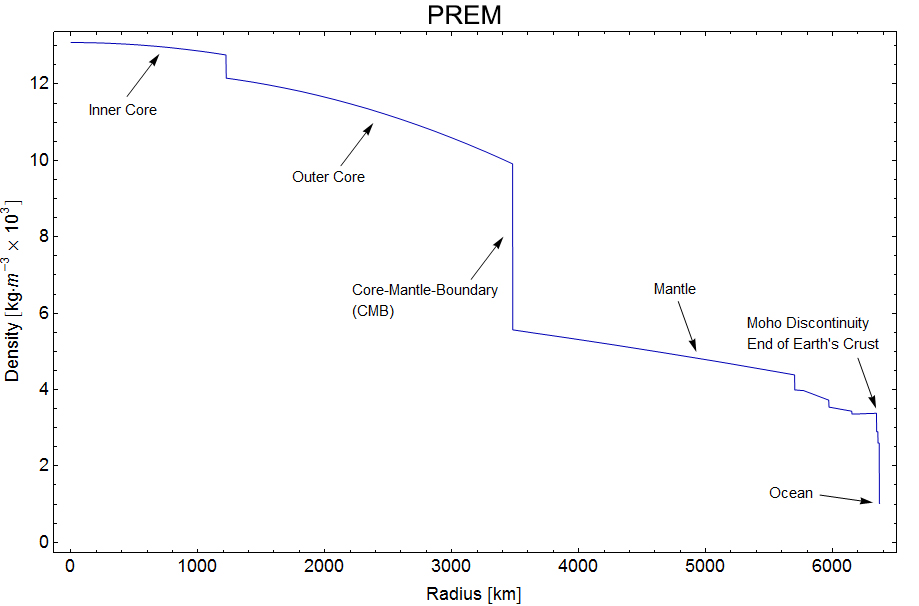 |
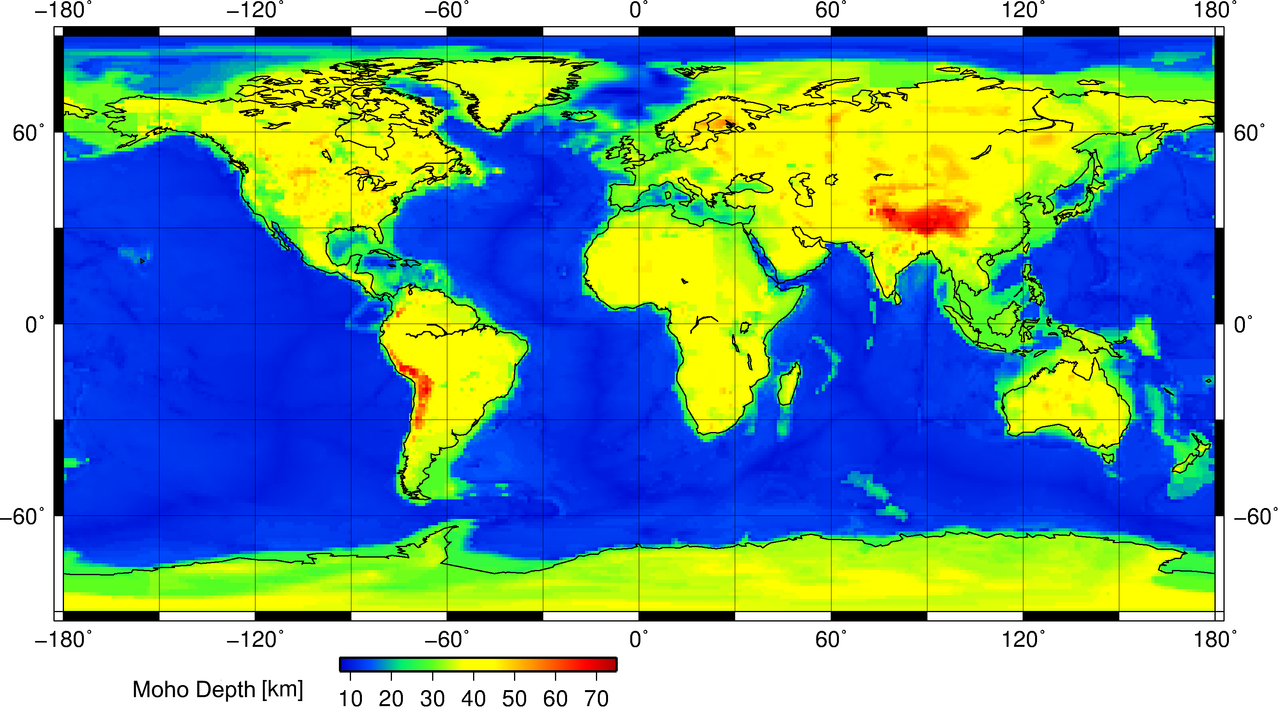 |
|---|---|
The Moho discontinuity divides the crust from the mantle.
Depth Min density Max density Composition
(km) (g/cm3) (g/cm3)
Ocean 4 1.0 1.0 Water
Crust 35 1.0 3.4 Granite, basalt, feldspar
Lithosphere 100 3.4 3.5 Peridotite, Dunite
Upper mantle 500 3.75 4.0 Mafic rock
Lower mantle 2890 4.5 5.5 Mafic rock
Outer core 5150 10.0 12.1 Iron, nickel
Inner core 6360 12.8 13.1 Iron, nickel
Limestone Calcium carbonate CaCO3 Mafic Rock containing iron or magnesium. Abundant below oceans. Denser than feldspar Granite Quartz, mica, feldspar, amphibole minerals Basalt Solidified lava. Mafic Igneous Granite, basalt Feldspar KAlSi3O8, NaAlSi3O8, CaAl2Si2O8. Abundant above the Moho discontinuity and absent below.
The following diagrams are based on models and one shouldn't expect too much precision from them.
 |
|---|
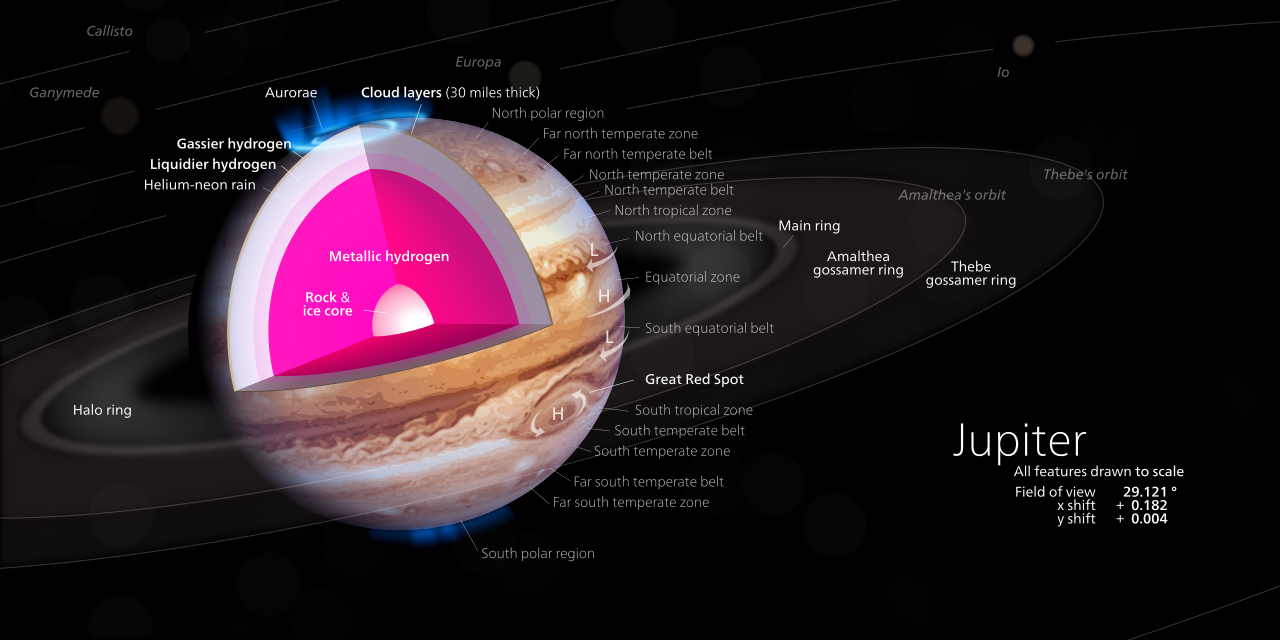 |
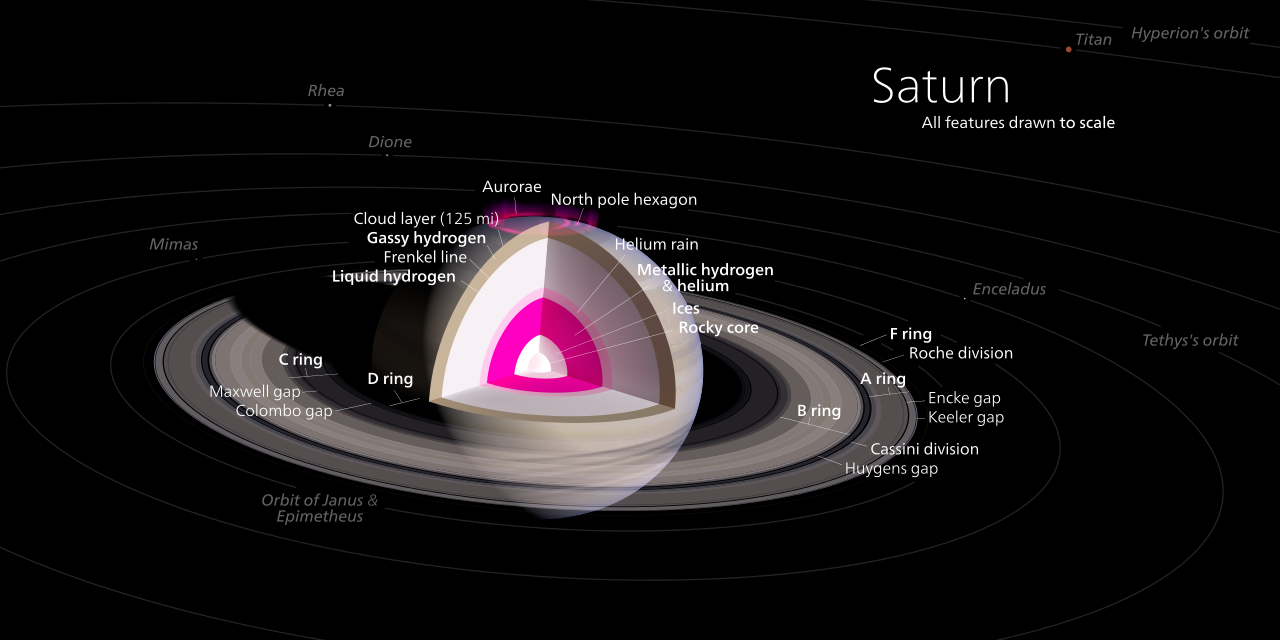 |
|---|---|
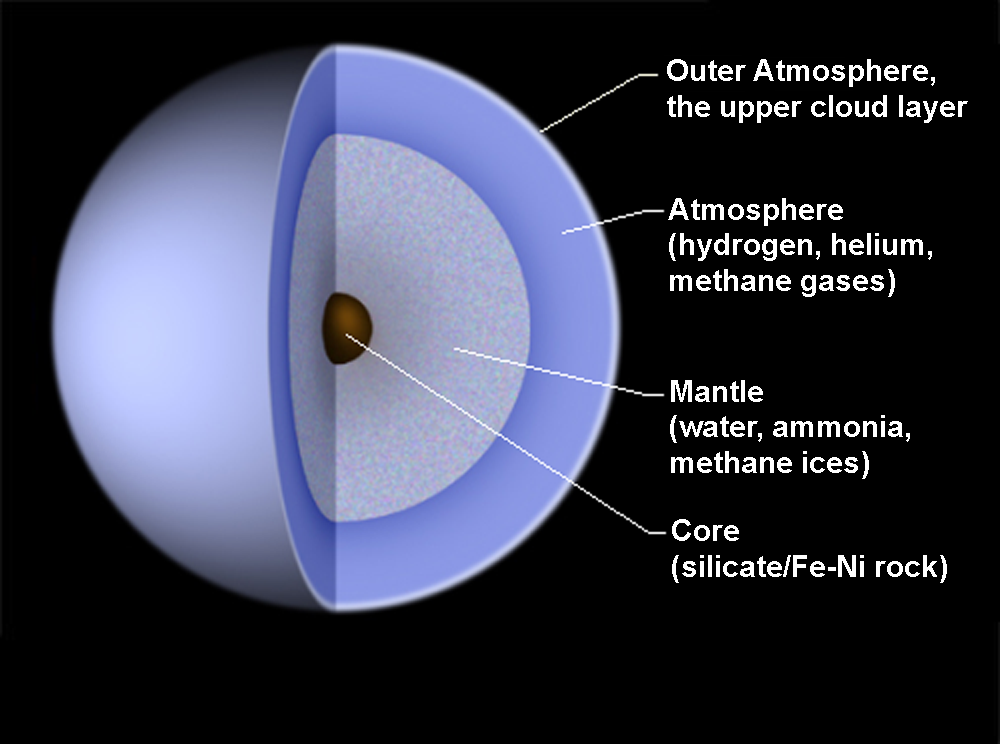 |
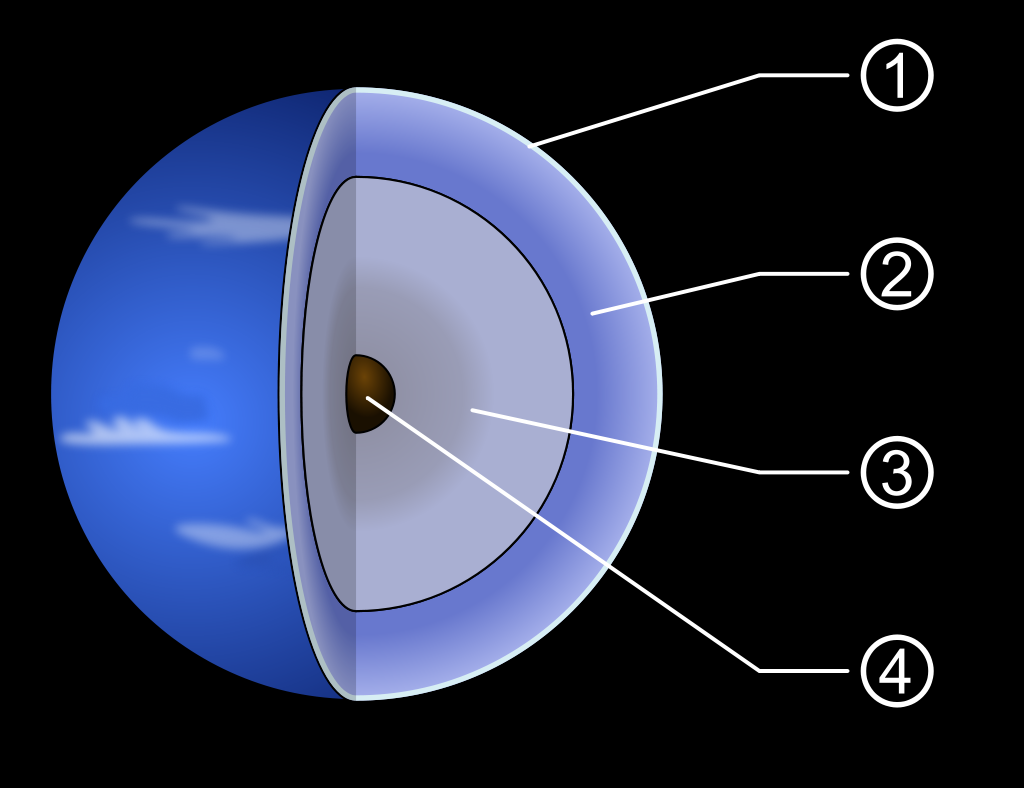 |
|---|---|
 |
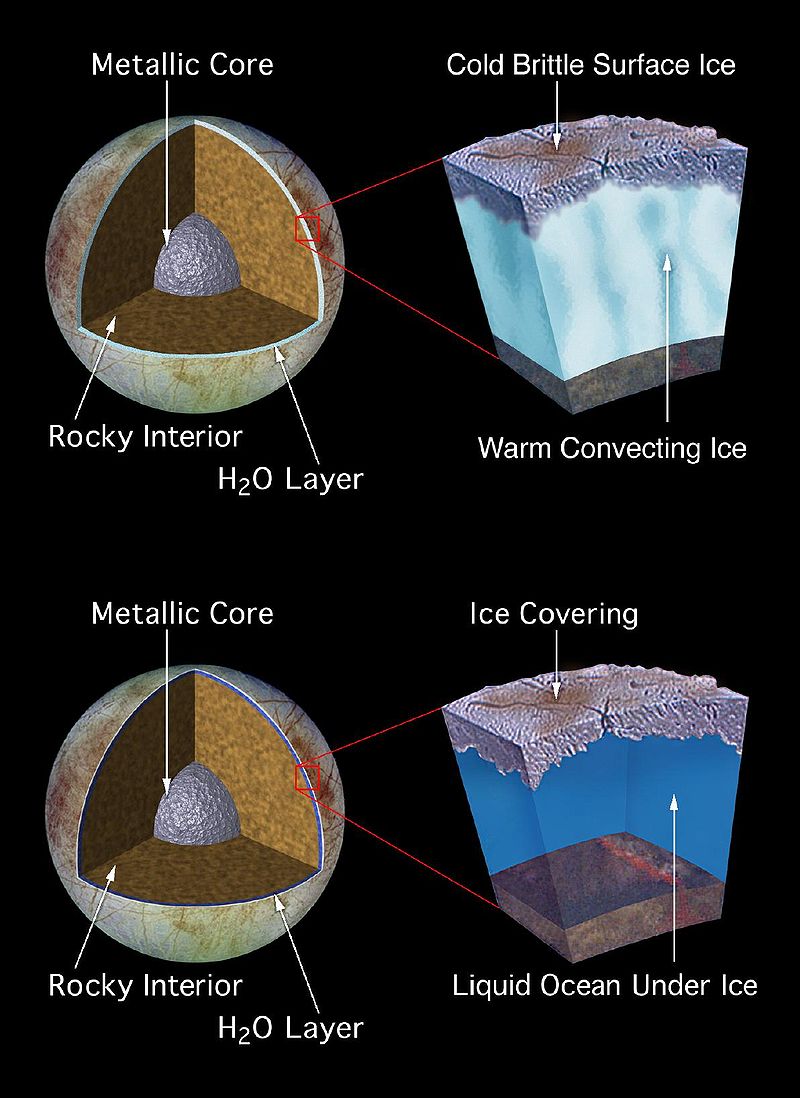 |
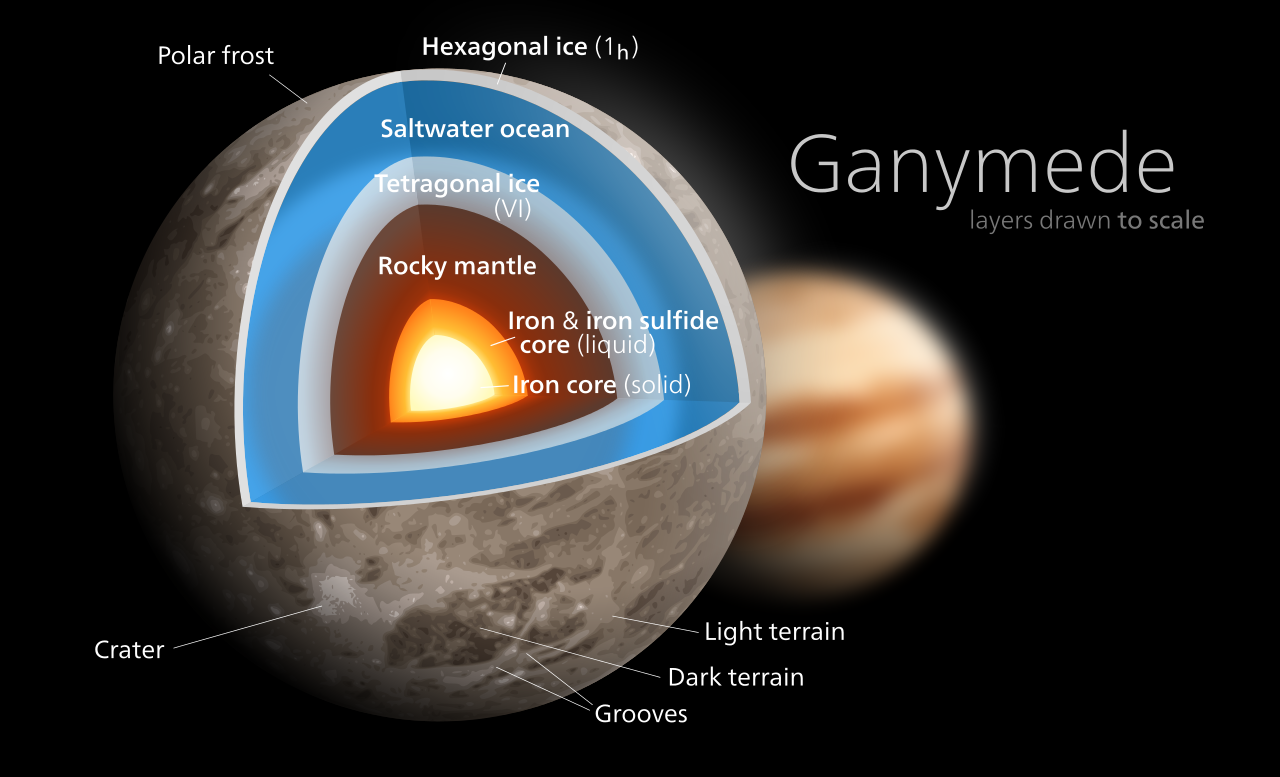 |
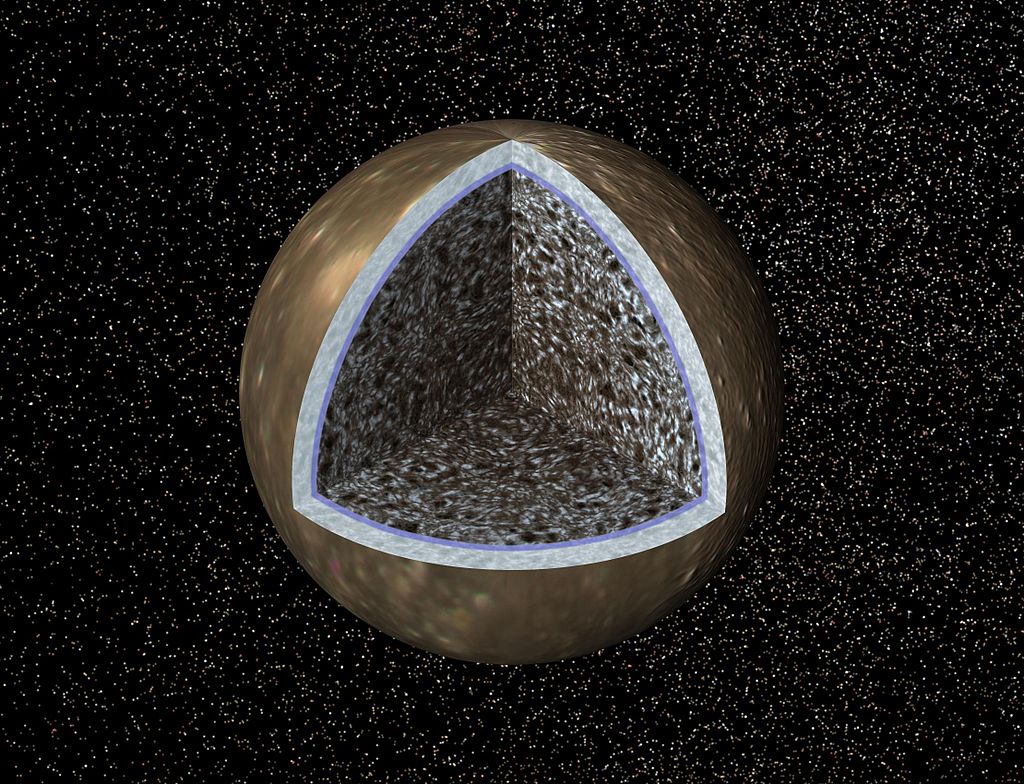 |
|---|---|---|---|
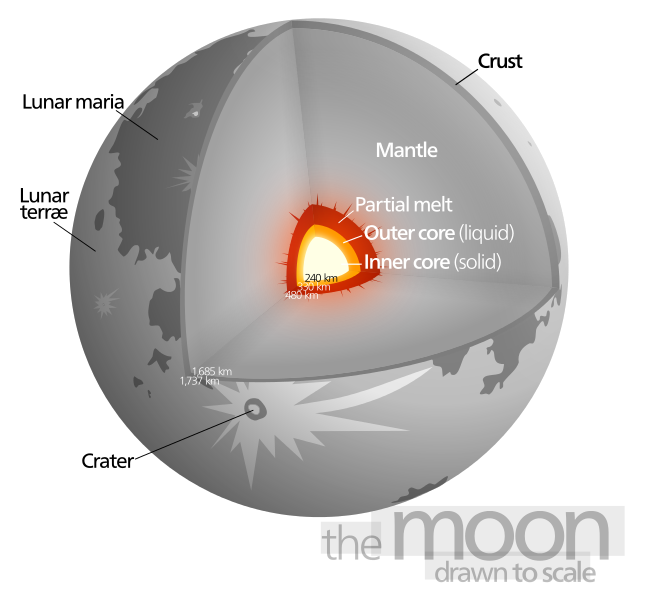 |
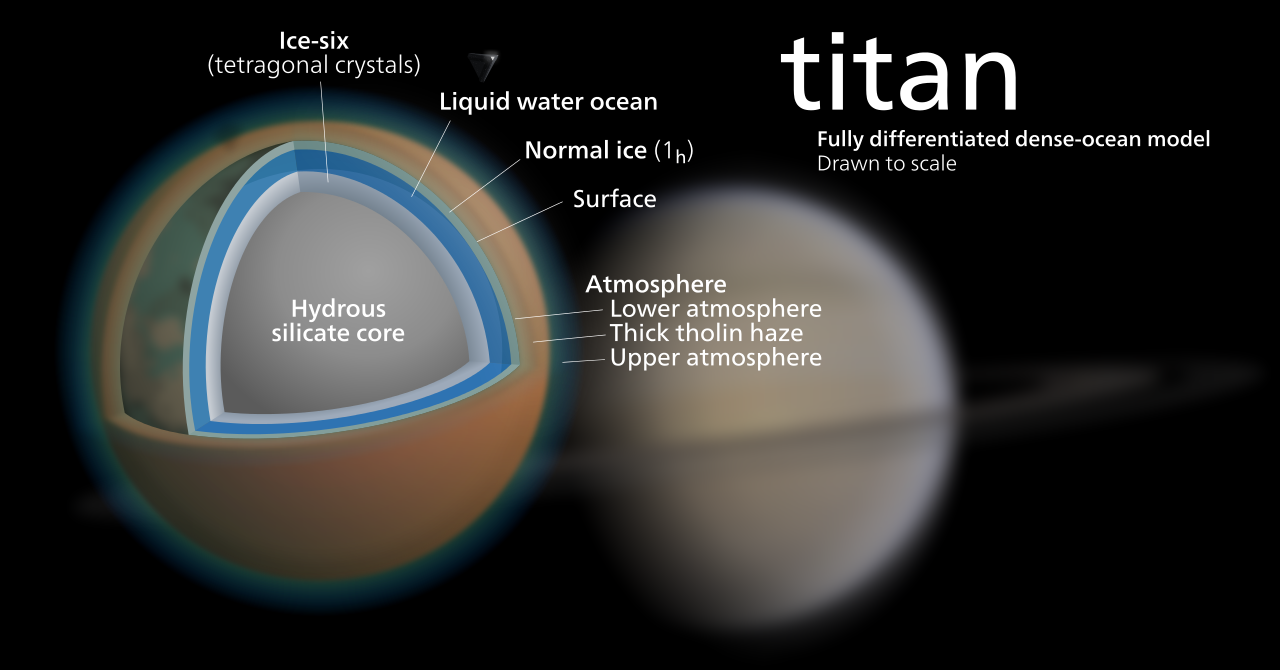 |
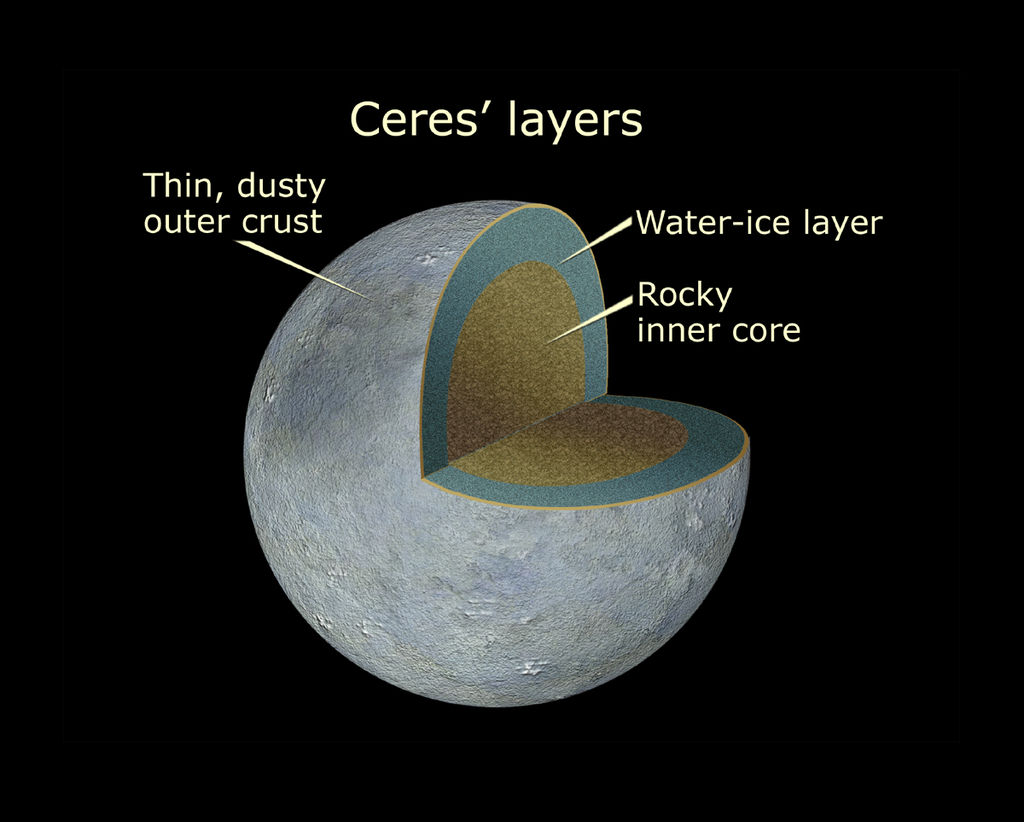 |
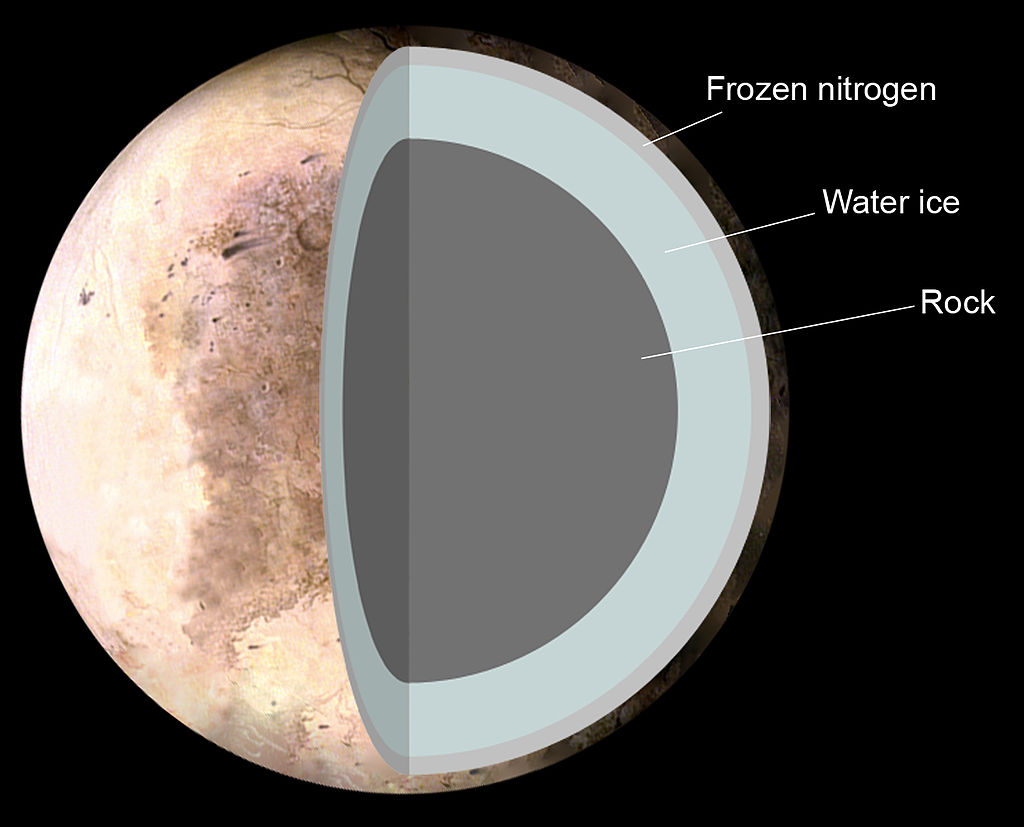 |
|---|---|---|---|
MicroWatts Half life Mantle PicoWatts/kg
/kg (billion abundance of mantle
years) (ppb)
Uranium-238 94.6 4.47 30.8 2.91
Uranium-235 569. .70 .22 .125
Thorium-232 26.4 14.0 124 3.27
Potassium-40 29.2 1.25 36.9 1.08
The Earth loses heat at a rate of .087 Watts/m2, for a global heat los
of 4.42e13 Watts.
80% of the Earth's heat is from radioactivity and 20% is from accretion.
The radioactive heating rate 3 billion years ago is twice that of today.
The Earth's core temperature is ~ 7000 K.
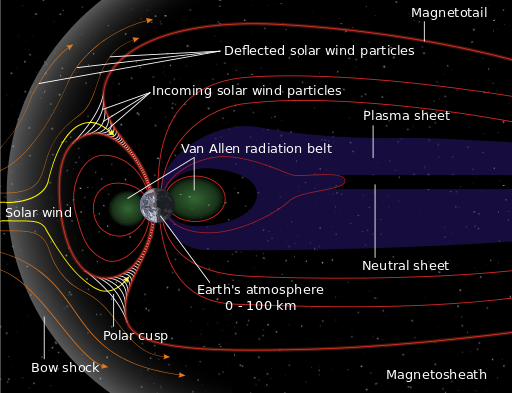 |
|---|
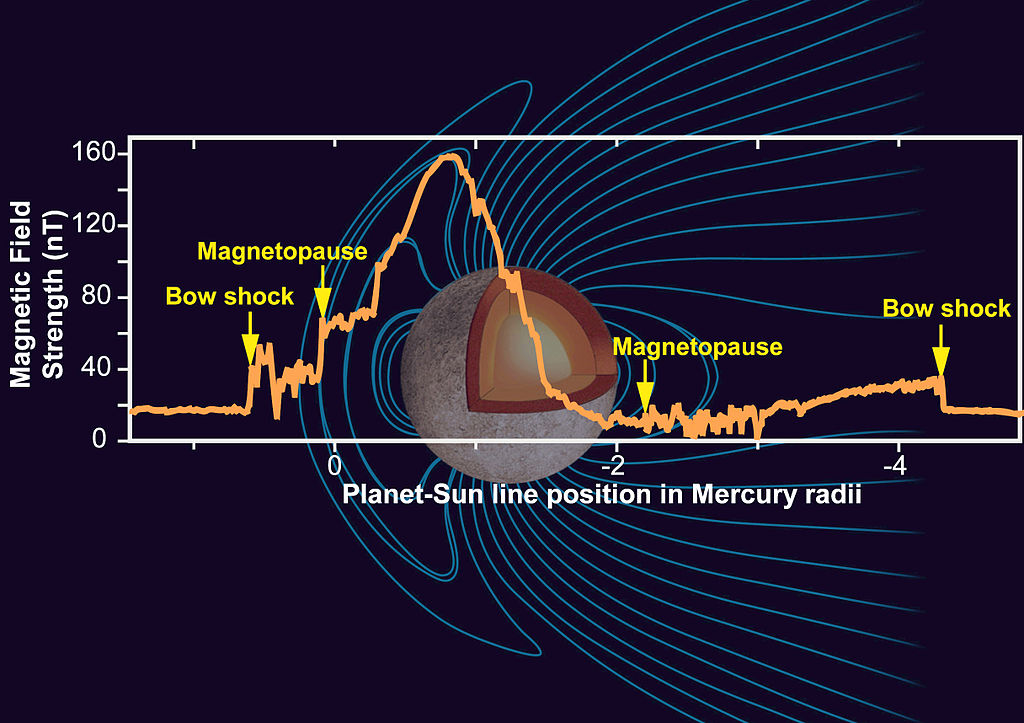 |
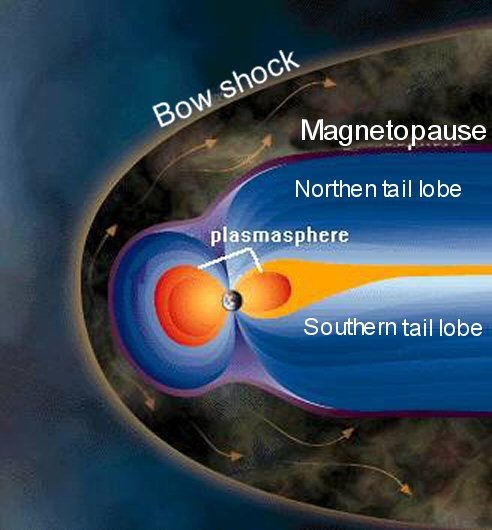 |
|---|---|
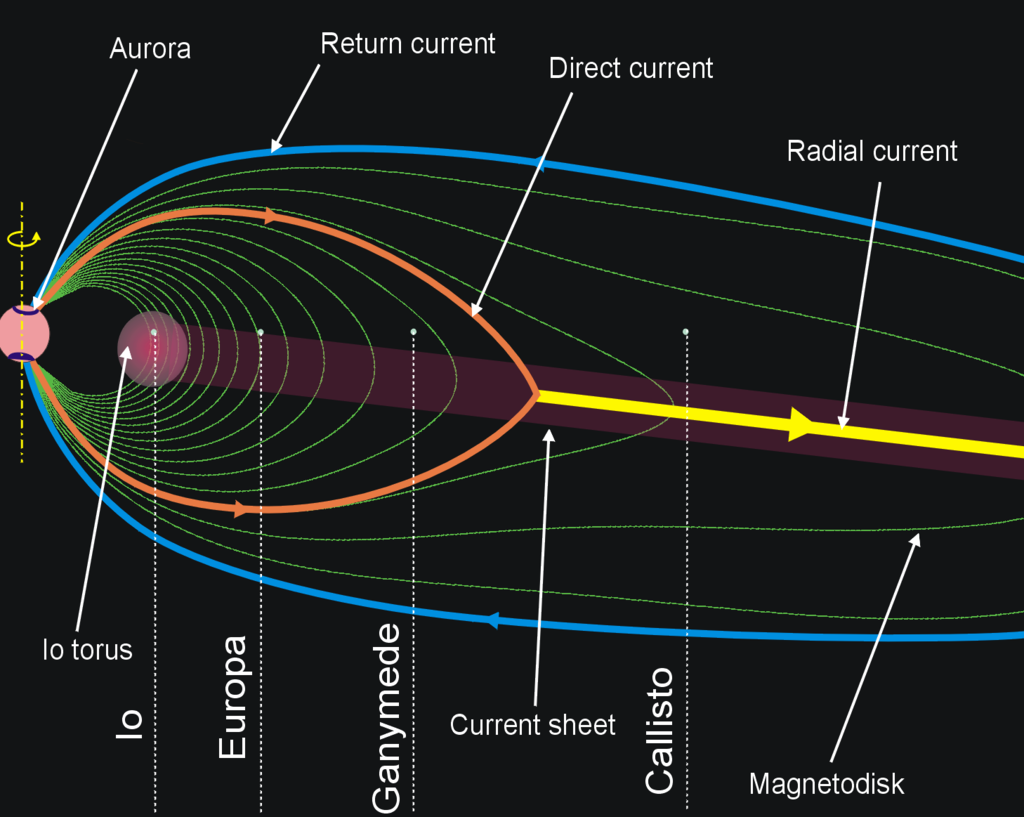 |
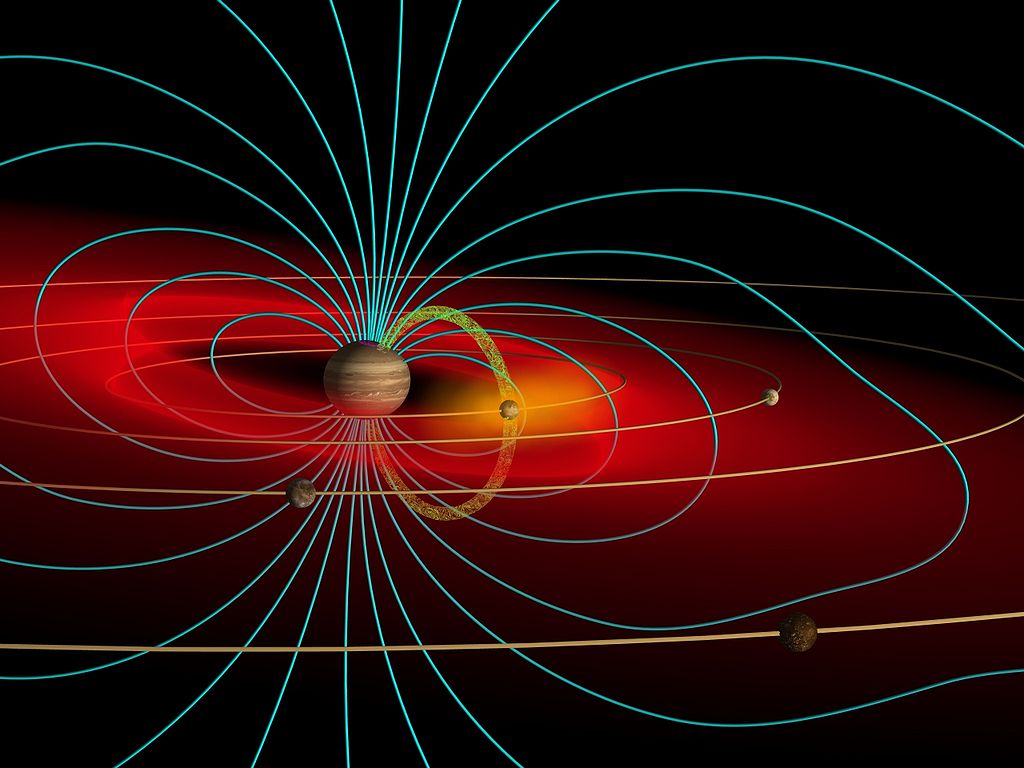 |
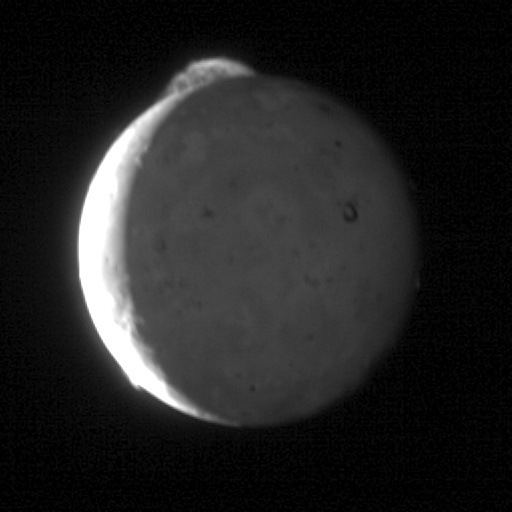 |
|---|---|---|
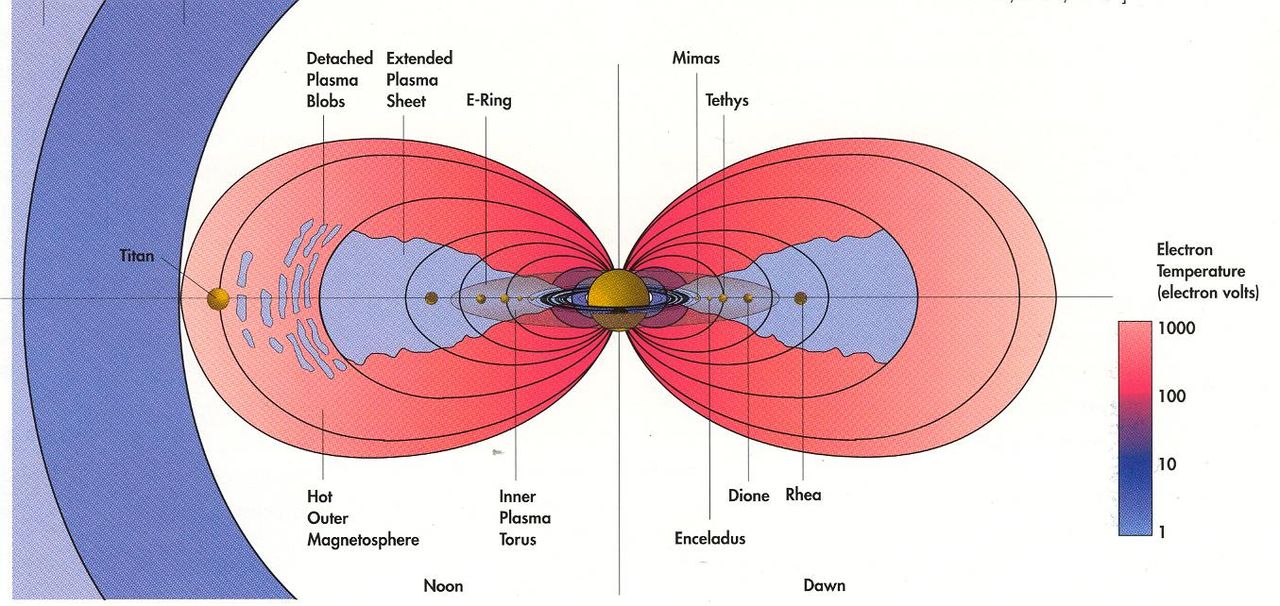 |
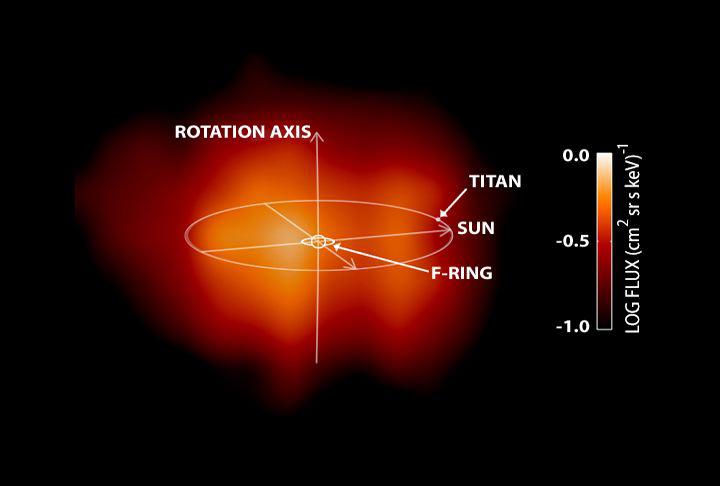 |
|---|---|
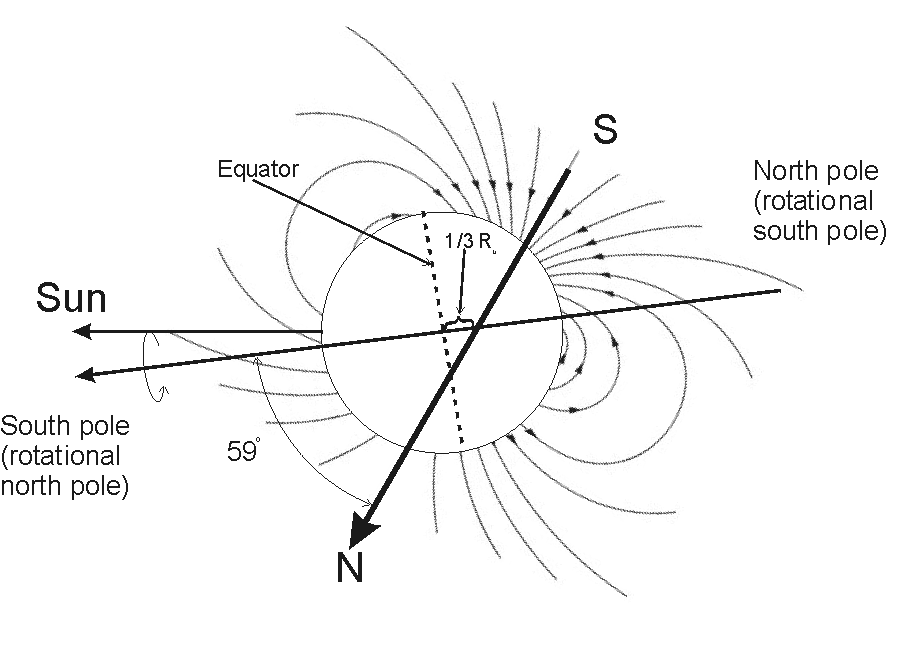 |
 |
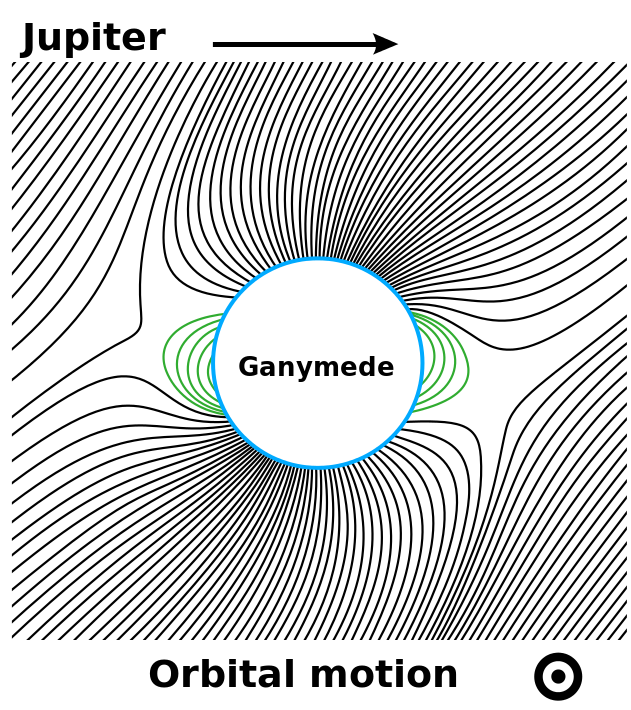 |
|---|---|---|
Dipole Field at Magneto- Axis Radius Spin Core Core Volcanic
moment equator pause angle (Earth (days) heating Temp
(Earth=1) (Gauss) (planet (deg) =1) (1012 (K)
radii) Watts)
Sun 5000000 109 25.0 4e14 1500000
Jupiter 20000 4.28 80 9.6 10.9 .41 400000 36000
Saturn 600 .22 20 <1 9.0 .44 150000 11700
Uranus 50 .23 20 58.6 4.0 .72 18000 5000
Neptune 25 .14 25 47 3.9 .67 18000 5400
Earth 1 .305 10 10.8 1.0 1.00 48 6000 Yes
Europa .0016 .0072 4.5 .24 3.55 1.6 No
Mercury .0007 .003 1.5 14 .38 58.6 No
Venus <.0004 <.00003 - - .95 243.0 Yes
Mars <.0002 <.0003 - - .53 1.03 No
Io ? ? ? ? .29 1.77 100 Yes
The Earth's magnetic moment is 7.91e15 T m3.
Jupiter's mangnetic field is 0.00120 Gauss at Europa's orbit.
The sun rotates with a period of 25.0 days at the equator and 34.4 days at the poles. This extreme differential rotation powers a magnetic field dynamo.
For an object to have a magnetic field it needs size, heat, and spin.
Core heating drives convective turbulence in the mantle, and turbulence generates magnetic fields. If there is no spin, the fields will have random directions and the field at the surface will be small. Spin herds magnetic fields into a uniform orientation and produces a dipole shape, like the Earth's field. In this case the field at the surface will be larger.
Magnetic fields are generated by turbulence and lost by resistive diffusion, and the equilibrium field strength occurs when these are in balance. The larger the object, the longer it takes for diffusion to smooth away the field and the larger the equilibrium field.
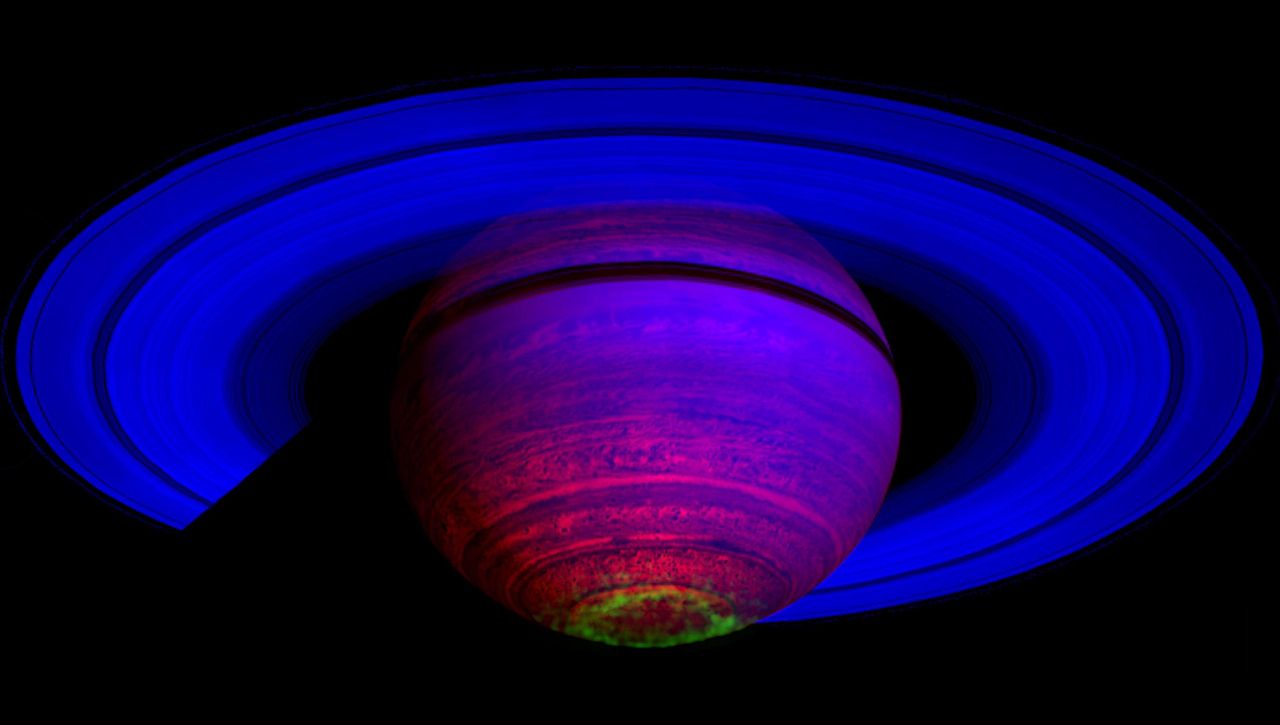 |
|---|
The planets formed within the sun's accretion disk, and the moons of the gas giants formed within the gas giant's accretion disk. In an accretion disk most of the mass ends up in the central object. The rocky planets are too small to form accretion disks and their moons were formed by collisions or capture.
Central Mass of orbiting objects / object Mass of central object Sun .00134 Mercury 0 Venus 0 Earth .0123 Mars .000000004 Jupiter .00021 Saturn .000239 Uranus .000070 Neptune .00021 Pluto .12
All moons are tidally locked to their planets. None of the planets are tidally locked to their moons except Pluto, which is tidally locked to Charon.
The tidal stretching axis of the moon always points to the center of the planet. If the planet is tidally locked to the moon, the planet's tidal streching axis points to the center of the moon. If the planet is not locked, the planet's stretching axis is slightly offset from the center of the moon, causing a torque that inspirals or outspirals themoon.
Planet Moon Planet Moon Moon orbit Moon
rotation orbit direction fate
(days) (days)
Earth Moon 1.00 27.32 Prograde Spiral outward and be stolen by the sun
Mars Phobos 1.025 .319 Prograde Spiral inward and crash into Mars
Mars Deimos 1.026 1.26 Prograde Spiral outward
Jupiter Io .414 1.77 Prograde Spiral outward
Jupiter Callisto .414 16.7 Prograde Spiral outward
Saturn Pan .440 .575 Prograde Shepherd moon
Saturn Titan .440 15.9 Prograde Spiral outward
Uranus Cordelia .718 .335 Prograde Spiral inward and become shredded into a ring
Uranus Puck .718 .762 Prograde Spiral outward
Neptune Triton .671 5.88 Retrograde Spiral inward and become shredded into a ring
Pluto Charon 6.39 6.39 Prograde Stable
Moon orbit Moon orbit / Moon Planet tidal axis
Planet rotation fate
Prograde < 1 Spiral inward Points behind of moon orbit
Prograde > 1 Spiral outward Points ahead of moon's orbit
Prograde 1 (locked) System is stable Points to the center of the moon
Retrograde Any Spiral inward Points behind the moon's orbit
 |
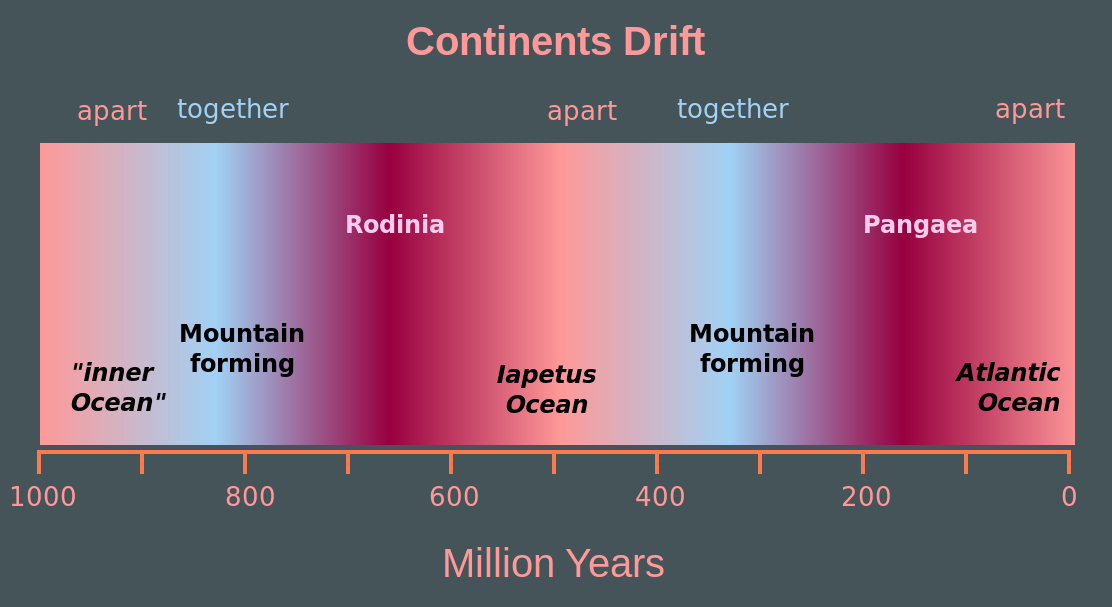 |
|---|---|
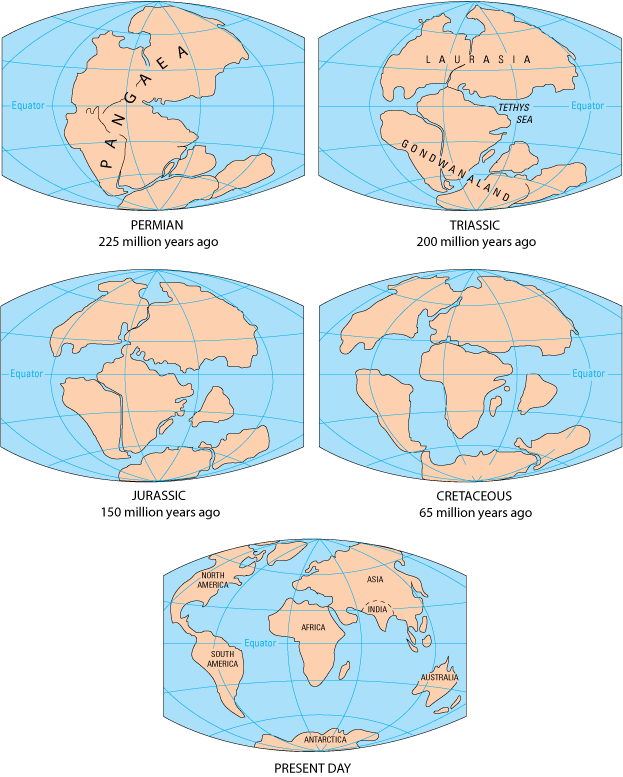 |
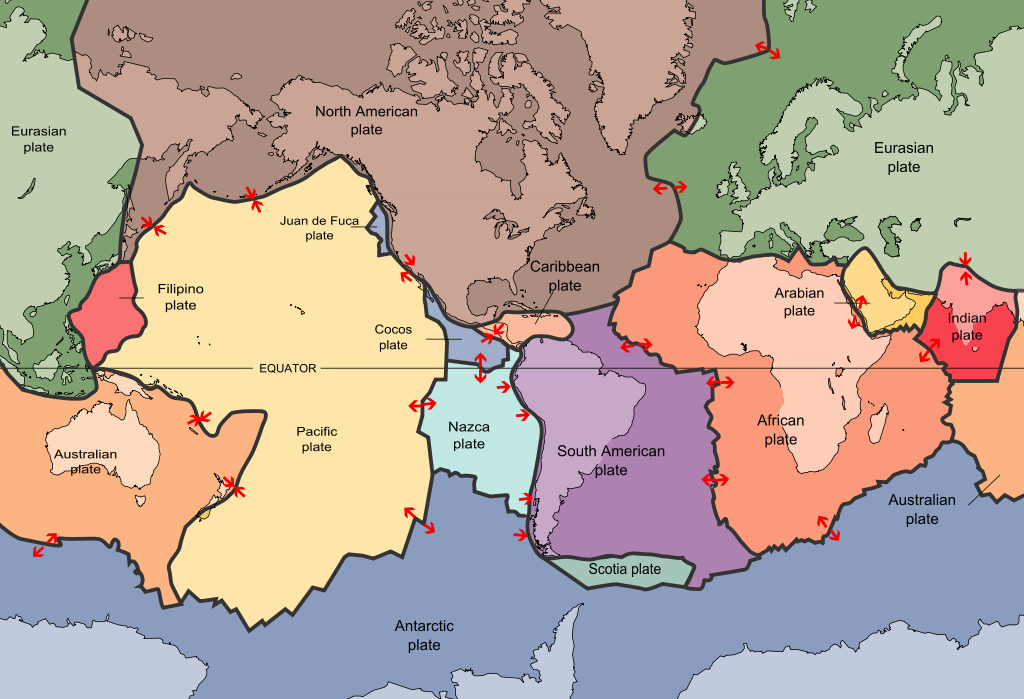 |
|---|---|
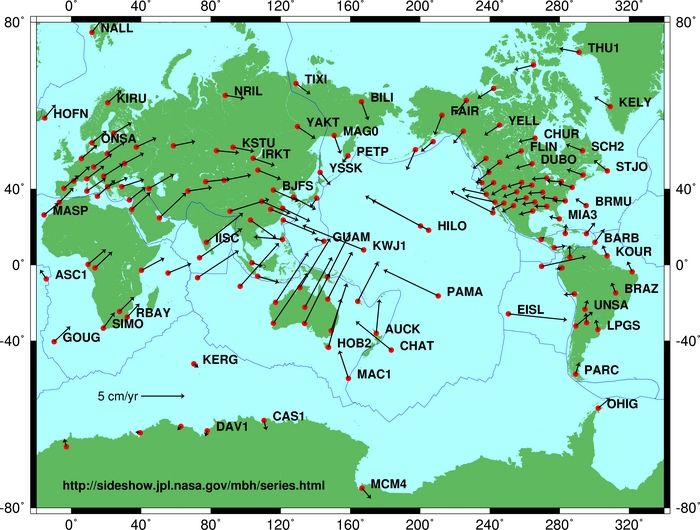 |
|---|
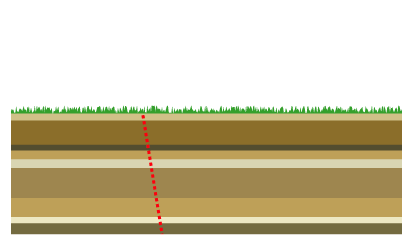 |
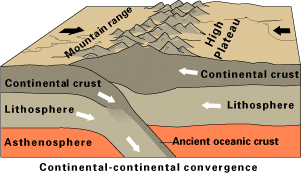 |
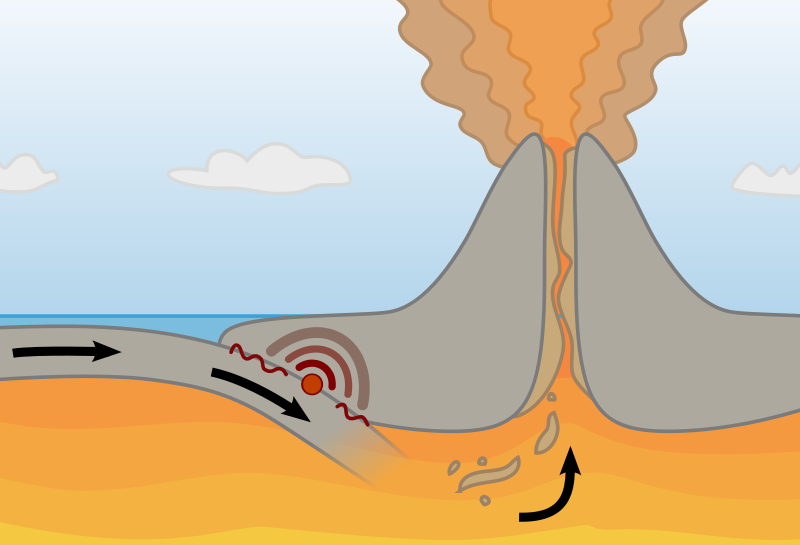 |
|---|---|---|
 |
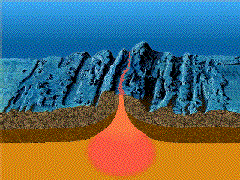 |
|---|---|
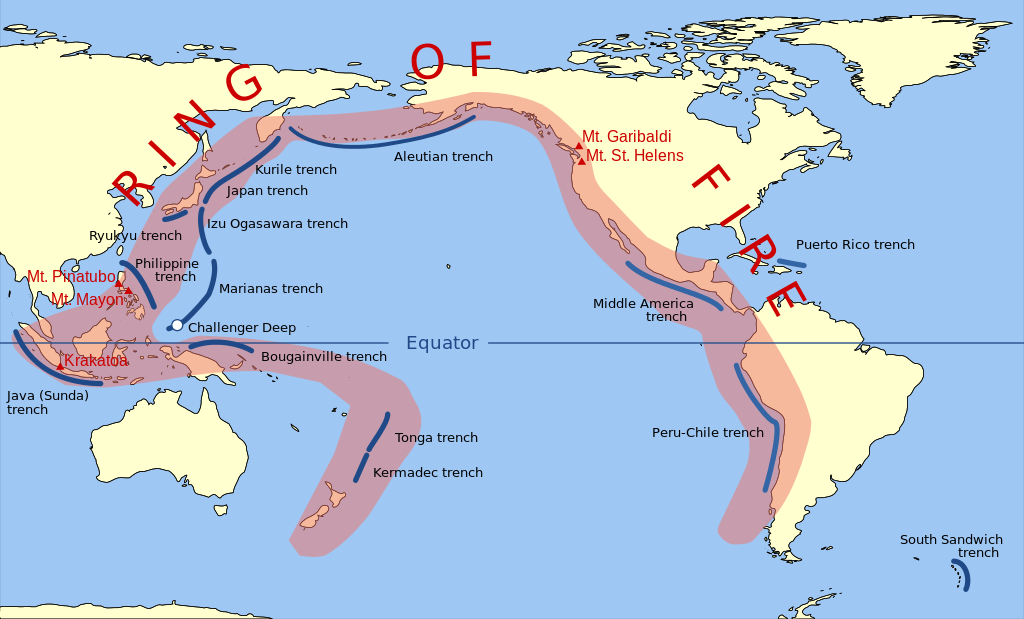 |
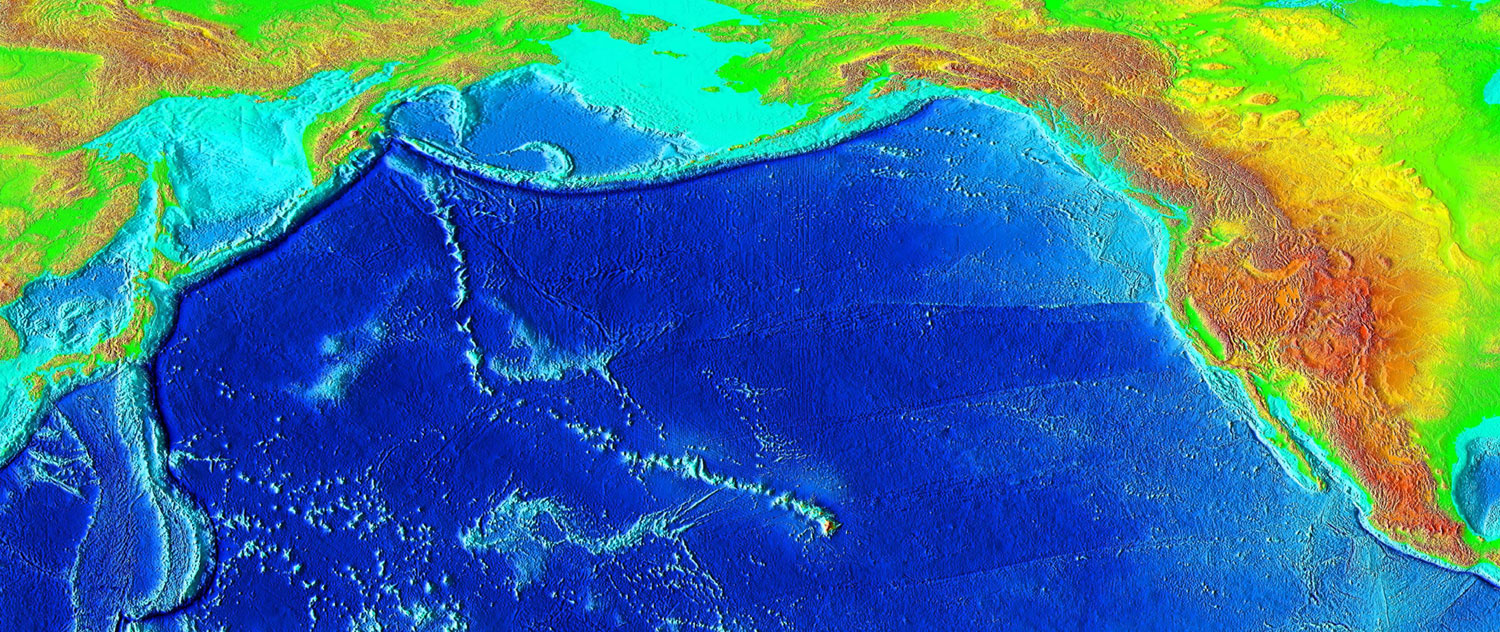 |
|---|---|
 |
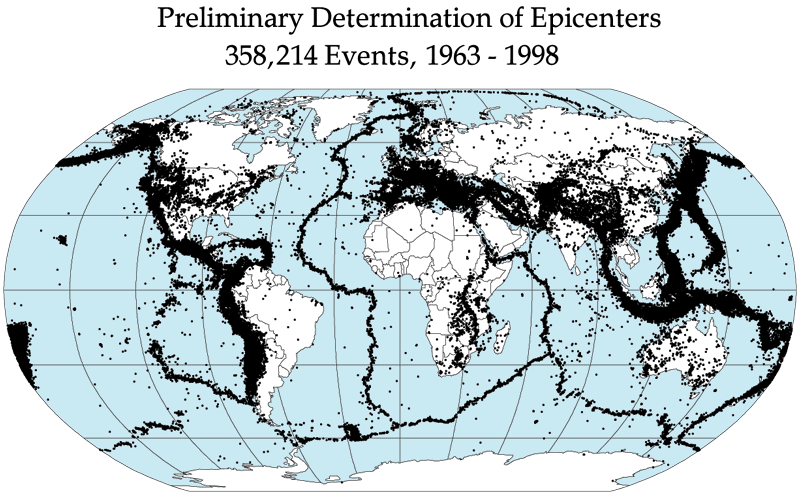 |
|---|---|
The largest earthquakes occur at subduction zones and they cause the largest tsunamis. The pacific plate is being subducted by continental plates all around its circumference, making every city on the Pacific coast vulnerable to tsunamis.
The Atlantic Ocean is expanding and doesn't have subduction zones.
Volcanoes tend to form behind subductions zones, for example the mountains in Washington and Japan.
Earthquake tsunamis are more frequent than asteroid tsunamis.
The largest earthquakes have magnitude 10. Only an asteroid can cause a larger tsunami than this.
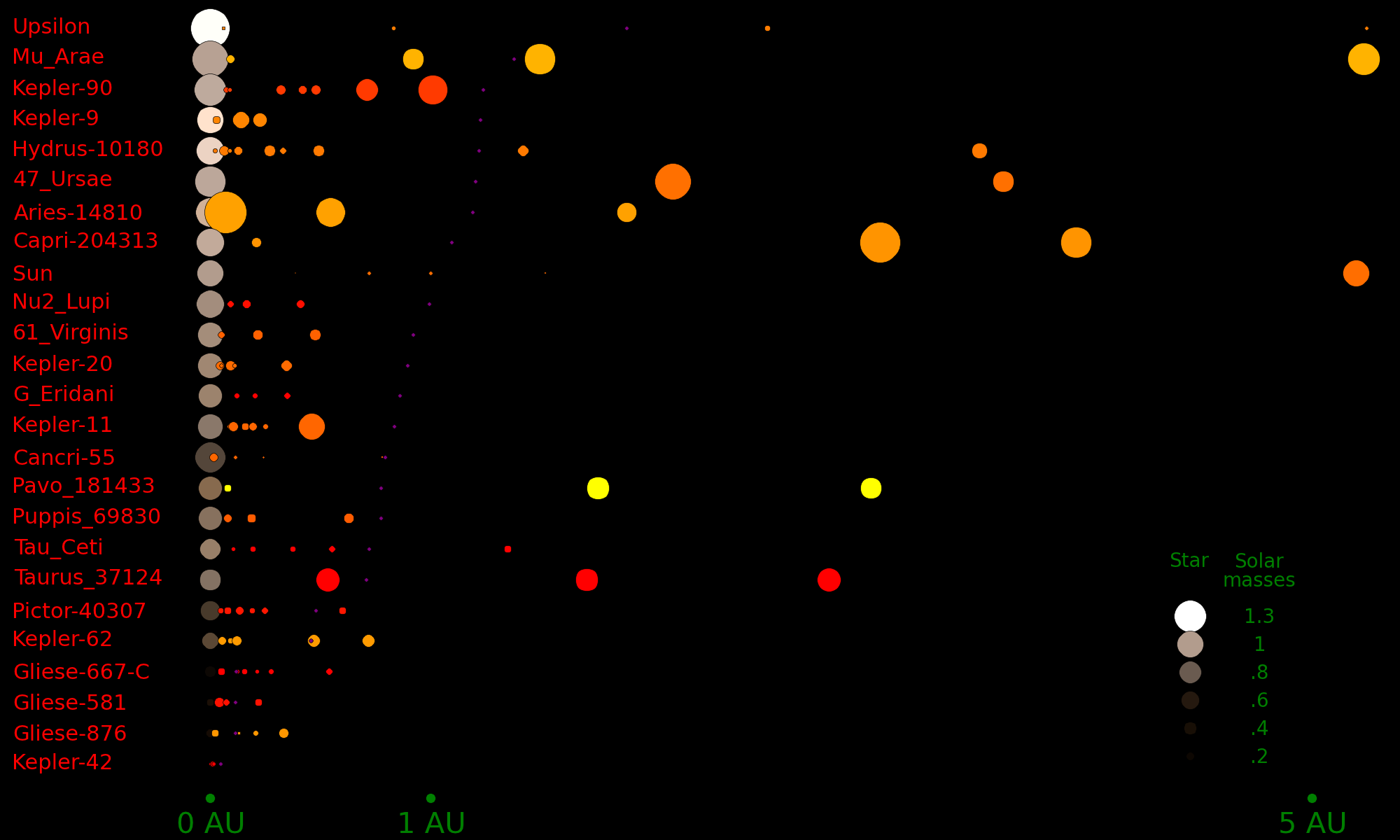 |
|---|
This is a plot of all extraterrestrial planetary systems with at least 3 planets. In the lower right there is an index relating star type with mass. The stars are depicted with the size, brightness, and color that your eye would see.
Planet size is scaled as the cube root of the mass. The solar system is 1/3 of the way down. Jupiter is the orange dot at the far right.
The "metallicity" of a star is defined as Metallicity = Mass of elements heavier than helium / Total mass
If the star has metallicity equal to the sun, orange dots are used for the planets. If the star is more metallic, yellow dots are used, and if it is less metallic, red dots are used.
Planet size tends to increase with star metallicity.
The purple dot indicates the location of the Goldilocks zone for each planetary system, where the temperature is right for liquid water.
Very few of the systems have an Earth-sized planet in the Goldilocks zone.
Most extraterrestrial planetary systems are more massive than the sun's planets. In the "Galactic Museum of Natural History", the solar system might be classified as a "Dwarf planetary system".
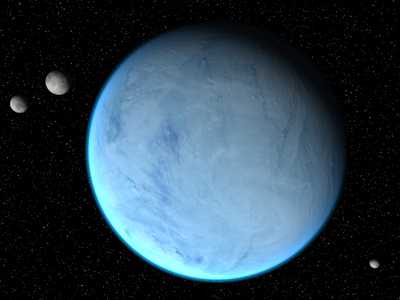 |
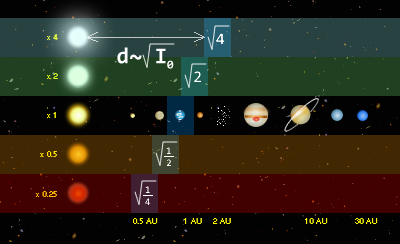 |
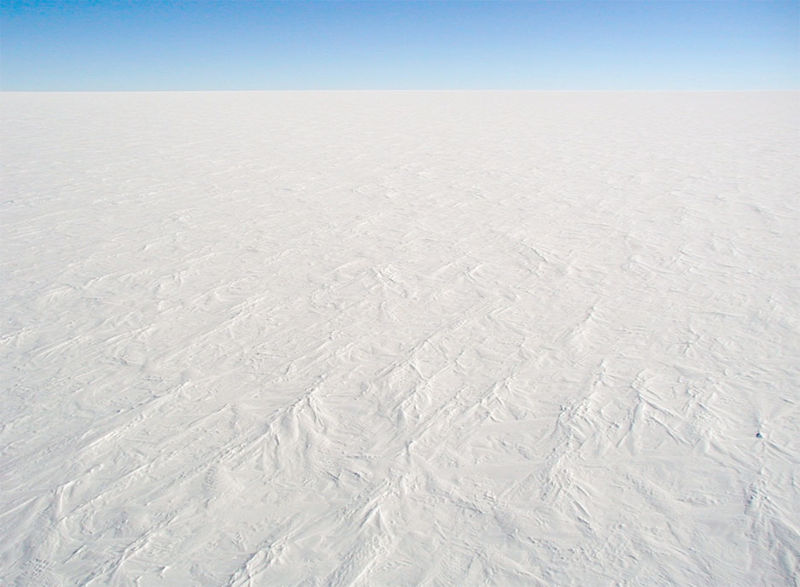 |
|---|---|---|
.tif.jpg) |
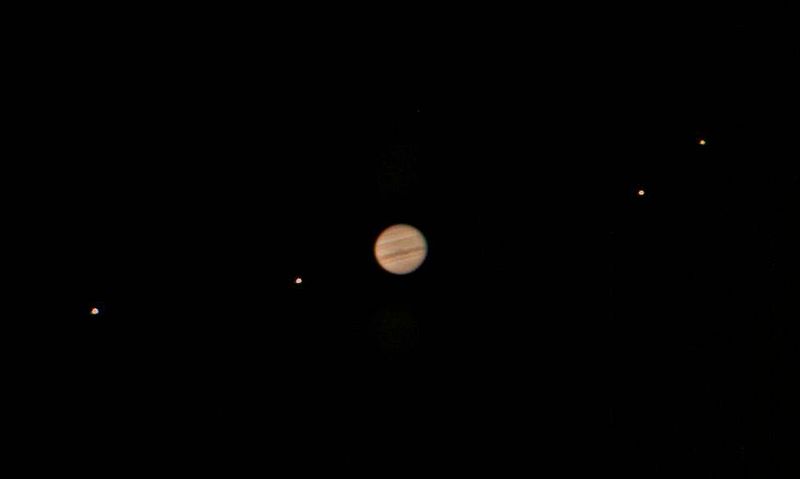 |
 |
|---|---|---|
Goldreich & Tremaine (1980): "We present an illustrative application of our results to the interaction between Jupiter and the plantary disk. The angular momentum transfer is shown to be so rapid that substantial changes in both the structure of the disk and the orbit of Jupiter must have taken place on a time scale of a few thousand years."
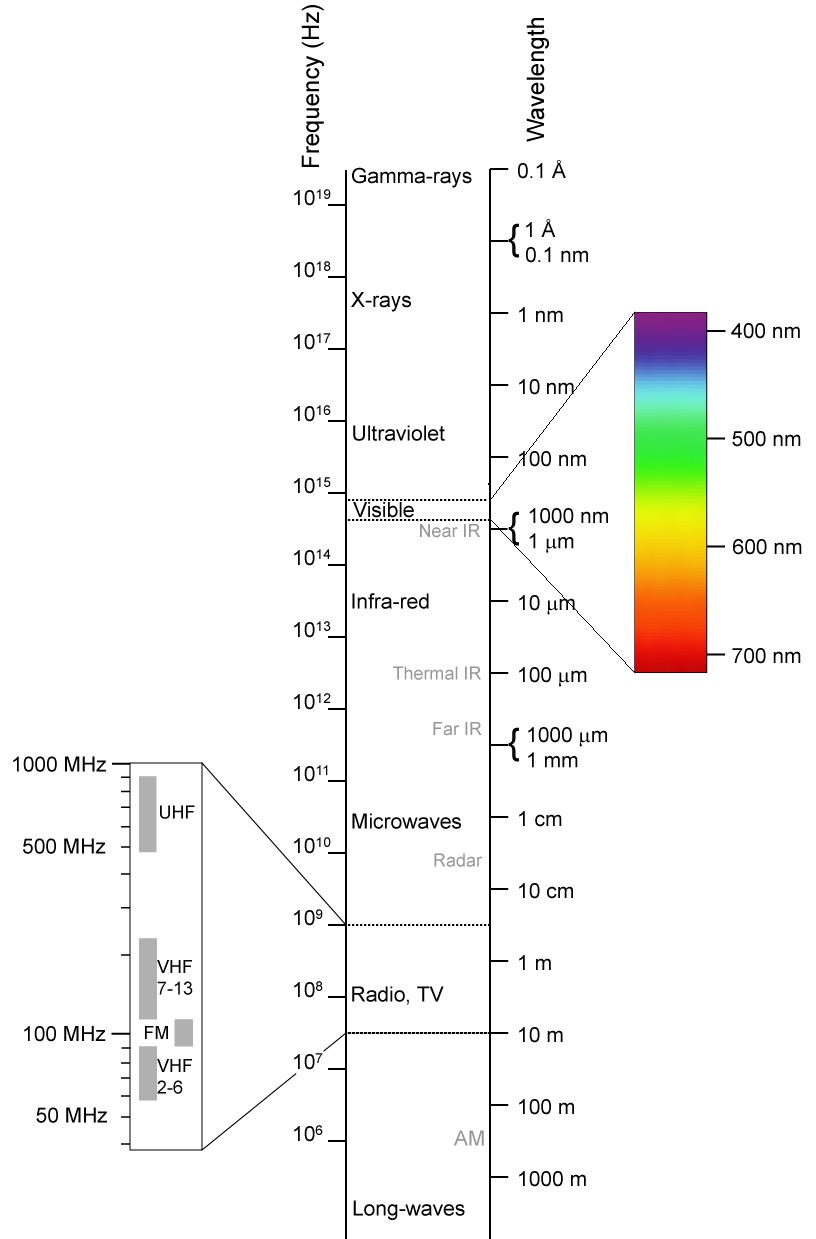 |
|---|
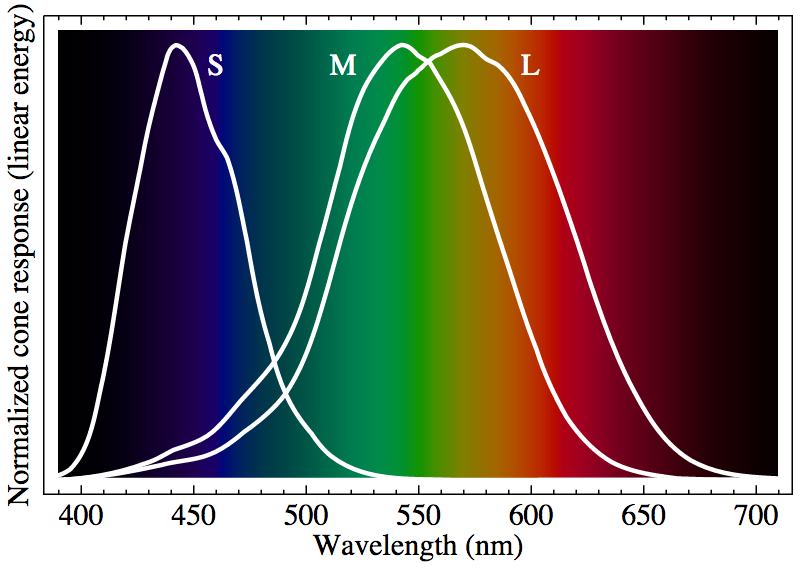 |
 |
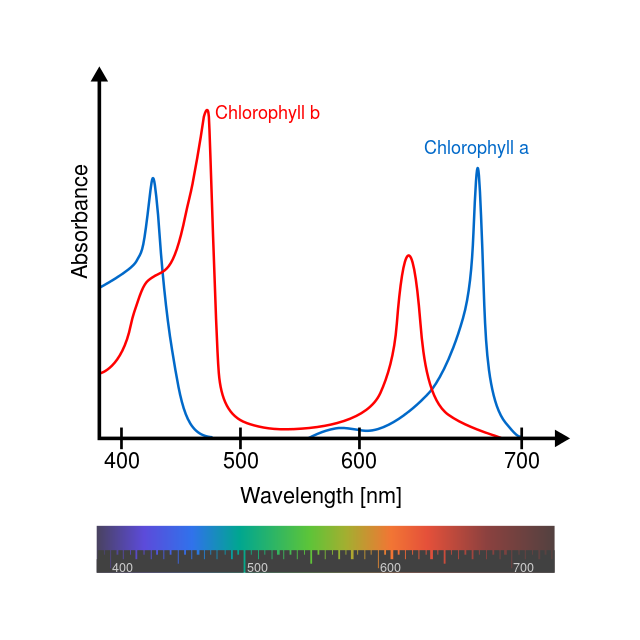 |
|---|---|---|
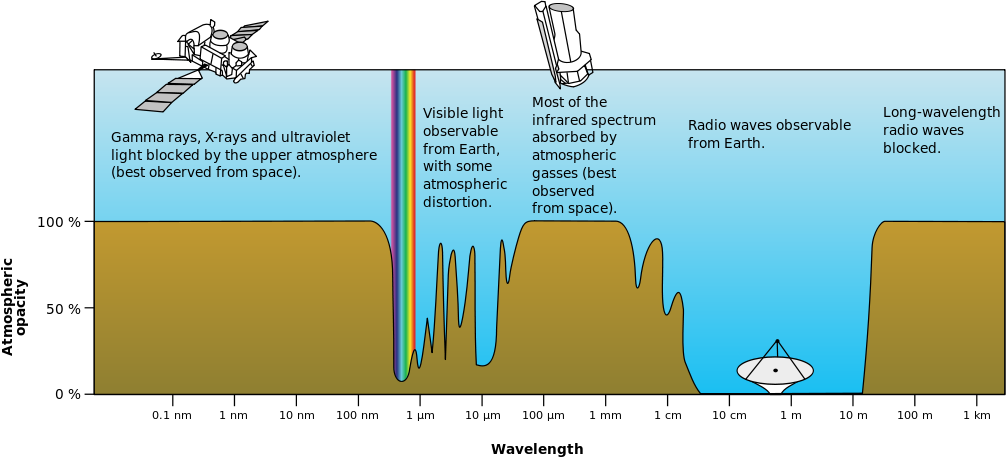 |
|---|
The Earth's atmosphere transmits visible light and radio waves and it blocks all other kinds of radiation.
 |
|
|---|---|
This is a plot of the radiation intensity of blackbody radiation for various
temperatures. Each curve is colored according to what your eye would perceive.
Visible light ranges from 400 nm to 750 nm.
The strip of color at the right depicts the color as a function of temperature.
Laws of blackbody radiation:
T = Temperature in Kelvin
I = Radiation intensity in Watts/meter2
W = Wavelength of the peak of the radiation spectrum for a given temperature
F = Frequency of light
C = Speed of light = 2.998e8 m/s
Stefan-Boltzmann law: I = 5.67e-8 T4
Wein's law: W T = 2.897e-3 Kelvin meters
Wave equation: F W = C
Temperature Intensity Wavelength Color
(Kelvin) (Watts/meter2) (micrometers)
The Earth 288 429 9.8 Infrared
Candle 1000 56700 2.9 Red
Incandescent bulb 2500 2000000 1.16 Orange
The sun 5778 60000000 .50 White
Sirius 9940 600000000 .29 Blue
 |
 |
 |
 |
|---|---|---|---|
 |
 |
 |
|---|---|---|
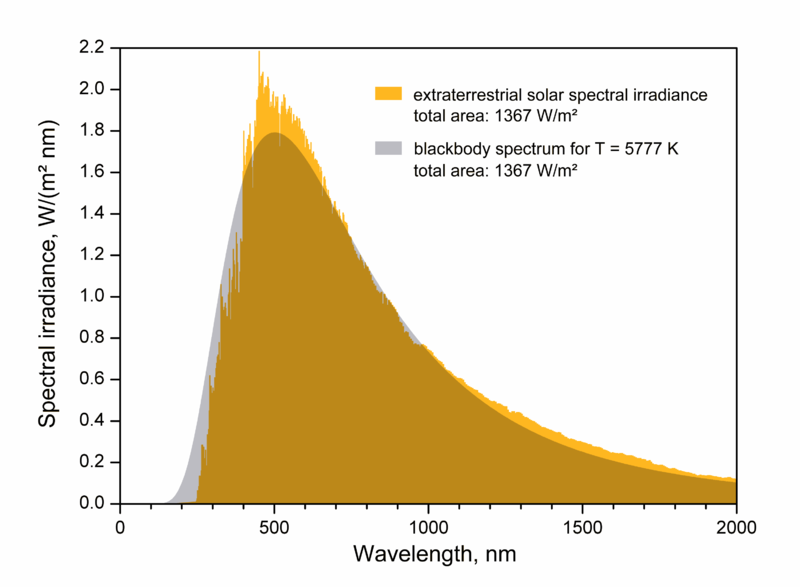 |
 |
|---|---|
phet.colorado.edu: Blackbody radiation
The Planck law gives the intensity of blackbody radiation as a function of temperature and frequency.
Planck constant = h = 6.626e-34 Joule Seconds Frequency = F Hertz Speed of light = C = 2.998e8 meters/second Boltzmann constant = k = 1.381e-23 Joules/Kelvin Temperature = T Kelvin Blackbody intensity = I = 2 h F3 C-2 (ehF/(kT)-1)-1 Watts/Hertz/meter2
The following table gives the power radiated in each band in percentages. A star with a temperature in the range of 4200 Kelvin is optimal for photosynthesis because it is both abundant in visible photons and sparse in UV photons.
Temperature UV Visible IR (Kelvin) % % % 2400 .00067 2.23 97.7 3000 .02 7.2 92.8 4000 .32 20.5 79.2 5000 1.73 34.3 63.8 5772 4.0 42.6 53.4 Sun 6000 4.9 44.4 50.7 UV: 315 nanometers and beyond IR: 680 nanometers and beyond
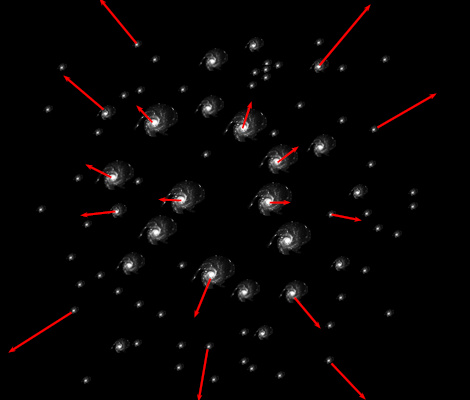 |
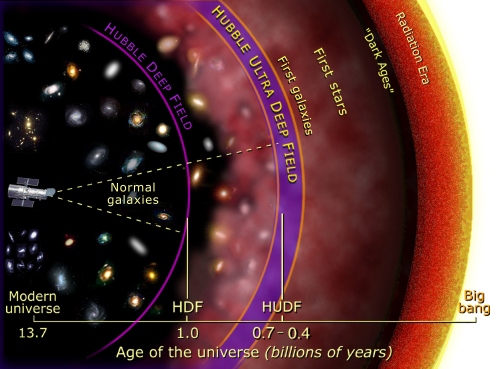 |
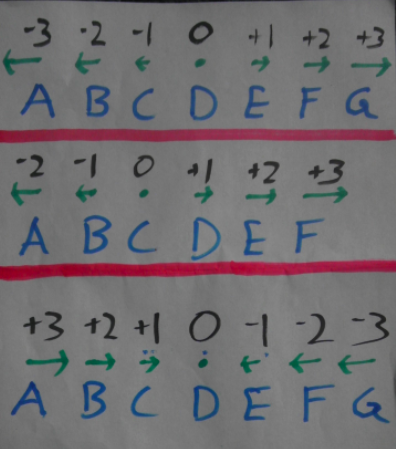 |
|---|---|---|
Distance Mass Speed with Speed Escape Gravity
(millions of (solar respect to according velocity time
light years) masses) Milky Way to Hubble (km/s) (billions
(km/s) law (km/s) of years)
Sun 1.6e-11 1.0 - - 41.9 2.3e-10
Alpha Centauri .0000044 1.1 - - .084 .031
Andromeda 2.54 1.0e12 -120 58 105 14.5
Virgo Cluster 54 1.2e15 1254 1240 790 41.0
Coma Cluster 321 6950 7400
Edge of universe 14000 300000 300000
Hubble constant = 23 km/s/(million light years)
Hubble velocity = Hubble constant * Distance
Solar mass = 1.99e30 kg
Light year = 9.46e15 meters
Age of universe = 13.8 billion years
Distance to the edge of the universe = Speed of light * Age of universe
Andromeda and the Milky Way are close enough for gravity to have
reversed the Hubble expansion. The Virgo and Coma clusters are far enough away to be
a part of the Hubble expansion. The edge of the universe is the horizon beyond
which galaxies recede faster than the speed of light.
"Escape velocity" is the escape velocity of the Earth from the given object.
"Gravity time" is the amount of time it would take for the object's gravity to pull the Earth toward it, if the Earth were released from rest with respect to the object.
If an object's escape velocity is smaller than the Hubble velocity, then the gravity from that object cannot reverse the Hubble expansion.
The Andromeda galaxy will collide with the Milky Way in 4 billion years and in the distance future, the merged galaxy will collide with the Virgo Cluster.
 |
|---|
 |
|---|
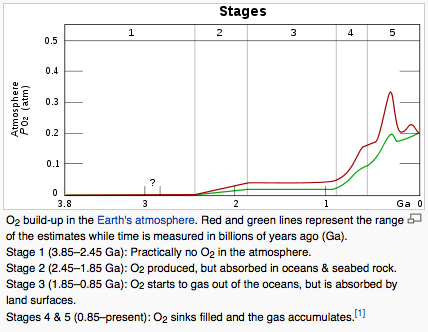 |
|---|
The Earth's atmosphere became abundant in oxygen 600 million years ago, concurrent with the emergence of multicellular life.
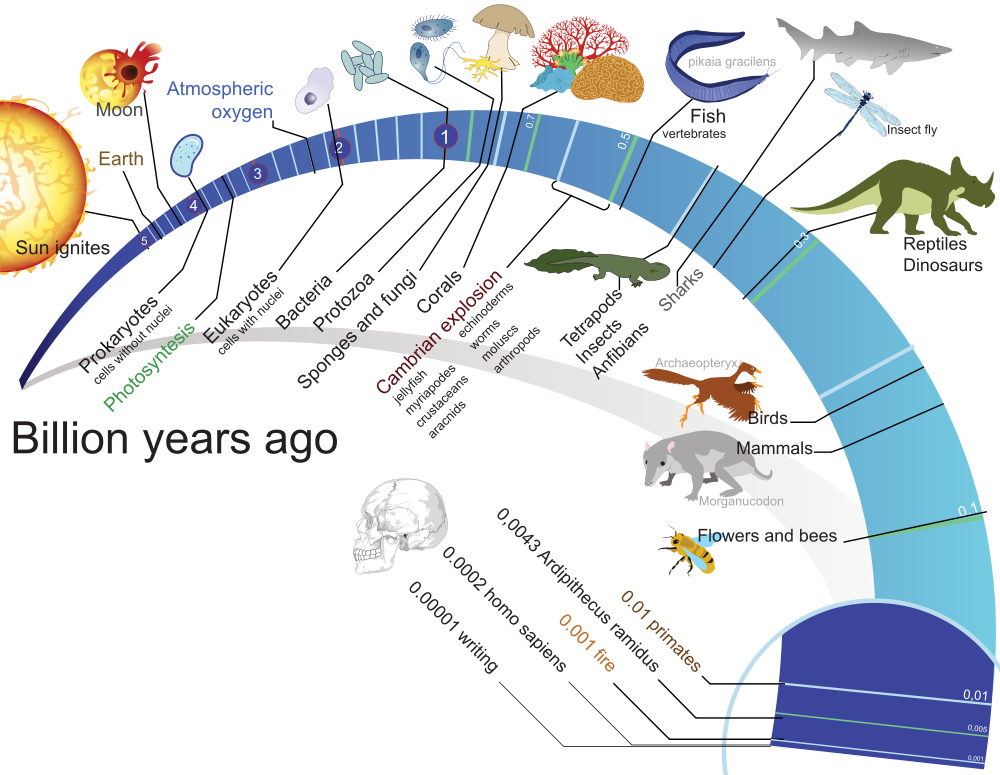 |
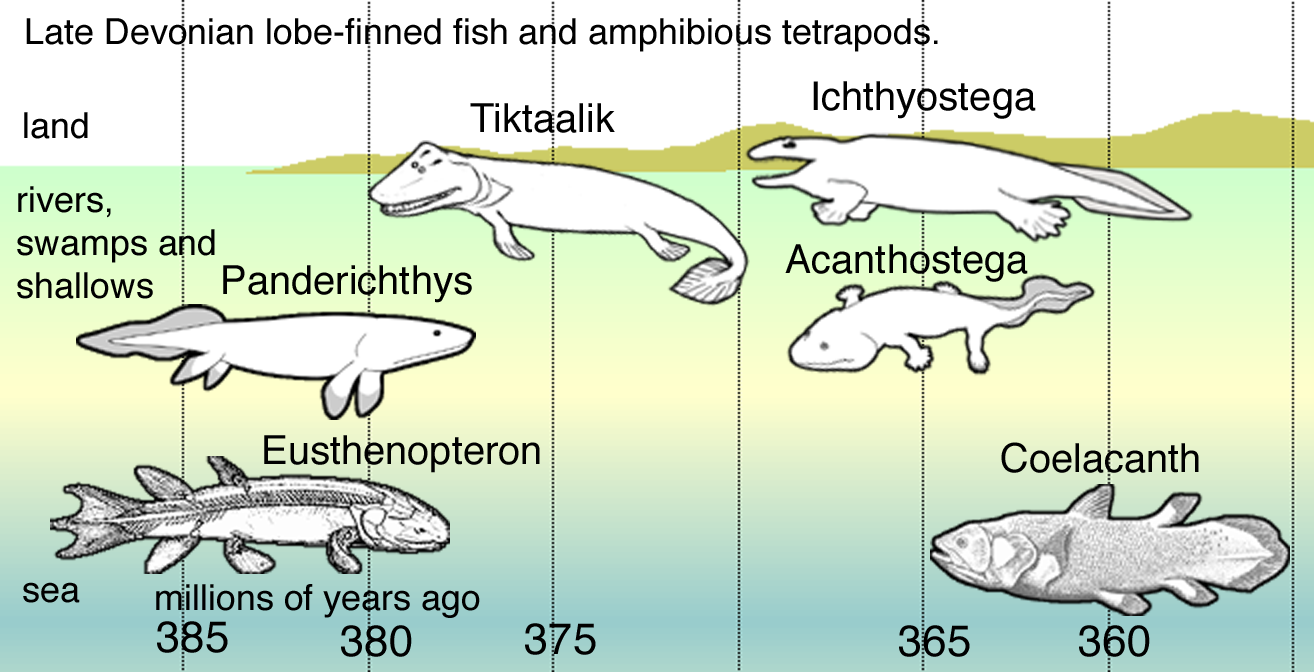 |
|
|---|---|---|
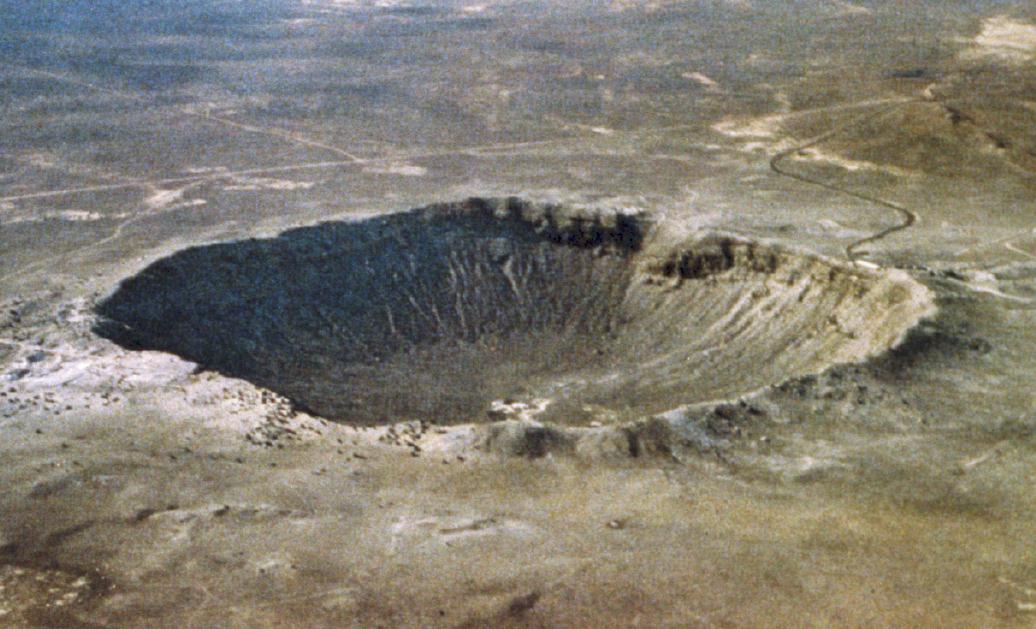 |
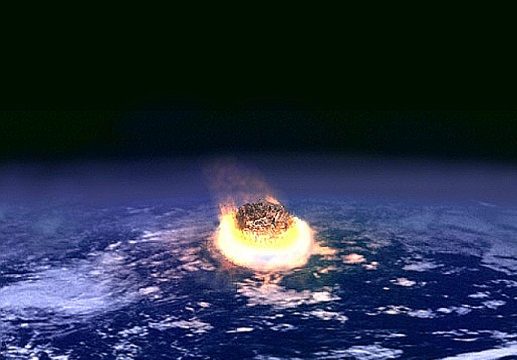 |
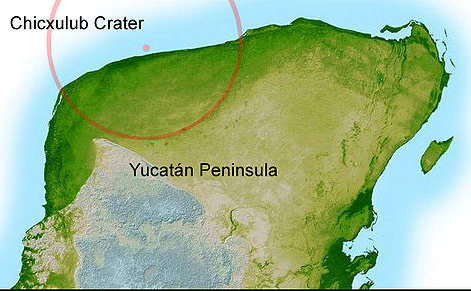 |
|---|---|---|
Planet property If too little If too much
Mass Cannot capture atmosphere Becomes gas giant
No volcanism
Cannot generate a magnetic field
Distance from Too hot Too cold for surface water
star Inside the snow line
Atmospheric Cosmic rays reach the surface Blocks too much sunlight
thickness Atmosphere loses heat at night for photosynthesis
Water content If you don't have oceans then you No dry land
don't have enough photosynthesis
to generate an oxygen atmosphere
Planet spin Does not generate a large-scale Fine
magnetic field
Planet spin tilt Fine Extreme seasons
Star temperature Not enough blue light for Too much UV light
photosynthesis
Star metallicity Small planets Too many gas giants
Star mass Planet is so close to the star that it Fine
is tidally locked to the star
Moon mass Planet tilt becomes unstable, causing Fine
extreme seasons
A moon of a gas giant can potentially be protected from the solar wind by the
gas giant's magnetic field. It can also potentially have volcanism from tidal
heating by the gas giant.
The Earth has been beset by asteroids, supervolcanoes, global ice ages, runaway global warming, supernovae, gamma ray bursts, and the industrial age.
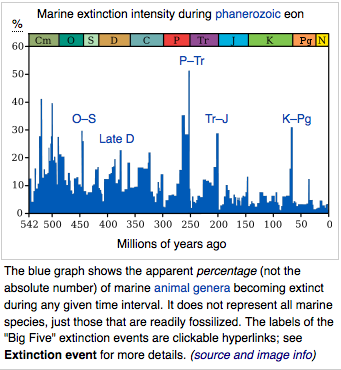 |
|---|
Millions of
years ago
66 Cretaceous–Paleogene extinction, caused by a 10 km asteroid.
Dinosaurs become extinct.
201 Triassic-Jurassic extinction. Cause unknown.
252 Permian-Triassic extinction. Runaway global warming
370 Late-Devonian extinction. Cause unknown.
445 Ordovician-Silurian extinction events. Global glaciation.
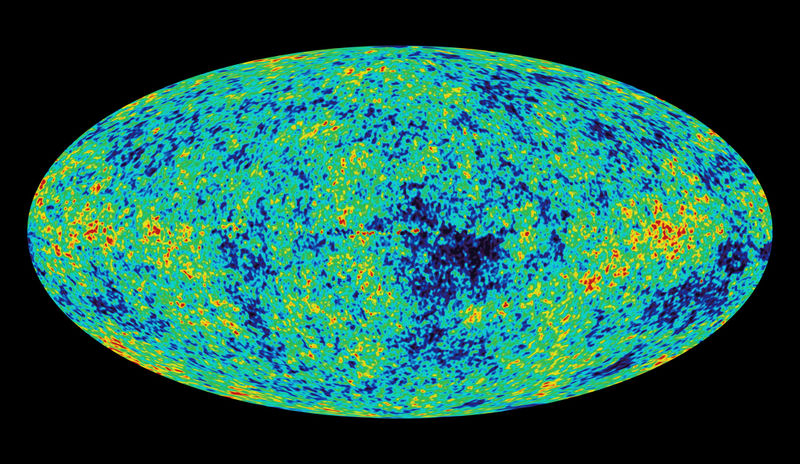 |
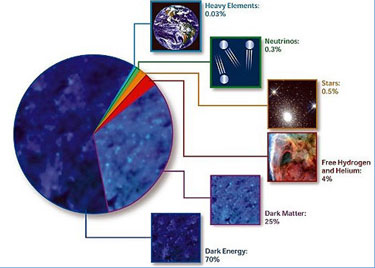 |
|---|---|
kg/m3
Planck density 5 *1096 = PlanckMass / PlanckLength^3
Solar system 2 *10-8 = Mass of sun / (30 AU)^3
Milky Way 3 *10-21 = 1.2e12 solar masses / (100000 lightyears)^3
Matter .12*10-27 = Mean density of protons & electrons in the universe
Dark matter .66*10-27 = Mean density of dark matter in the universe
Dark energy 1.67*10-27 = Mean density of dark energy in the universe
As the universe expands the matter and dark matter density decrease and the
dark energy density is constant.
In the early universe the dark matter density was vastly greater than the dark energy density. In the future dark energy will overwhelm dark matter and the universe will expand unchecked.
 |
 |
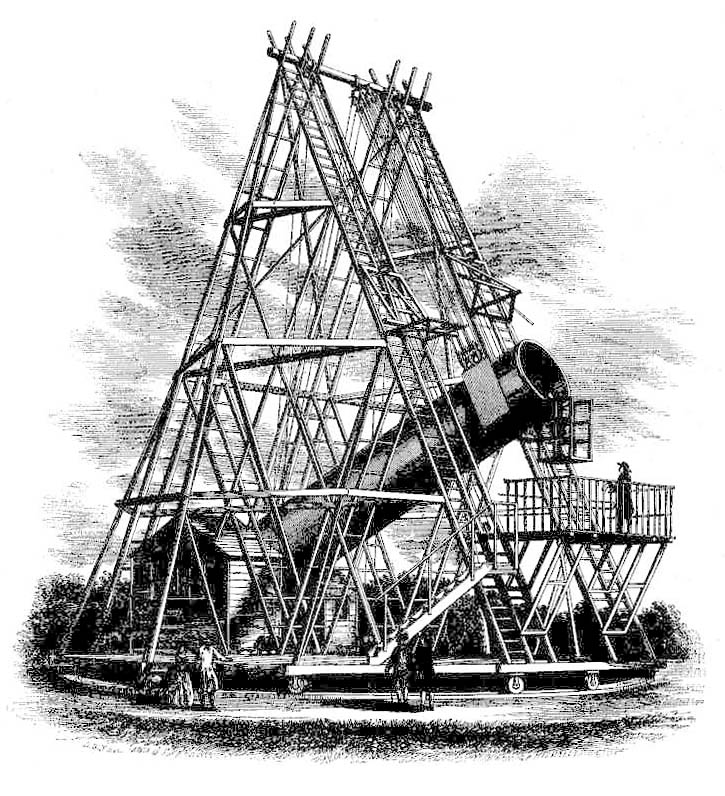 |
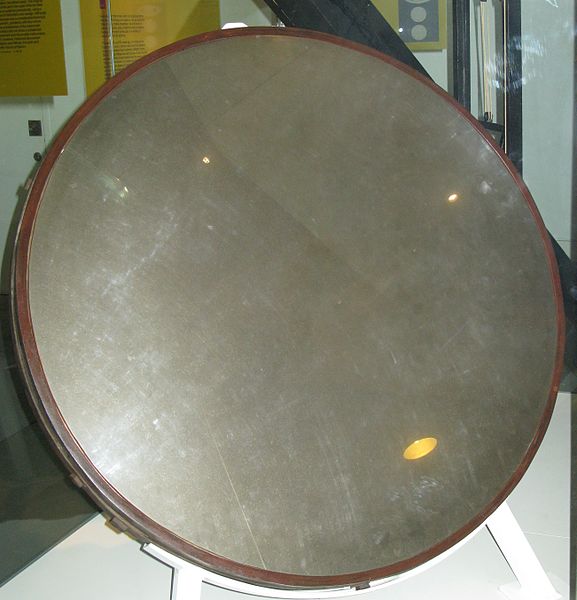 |
 |
|---|---|---|---|---|
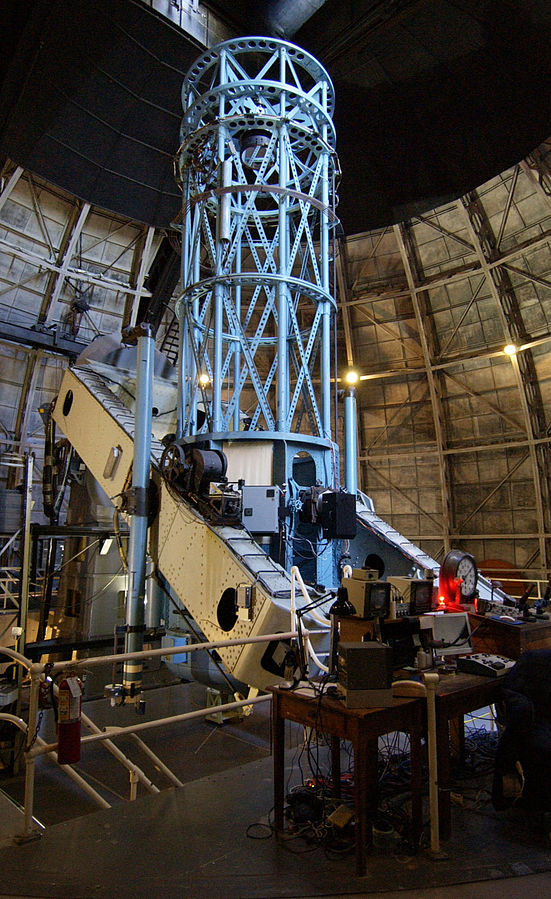 |
.jpg) |
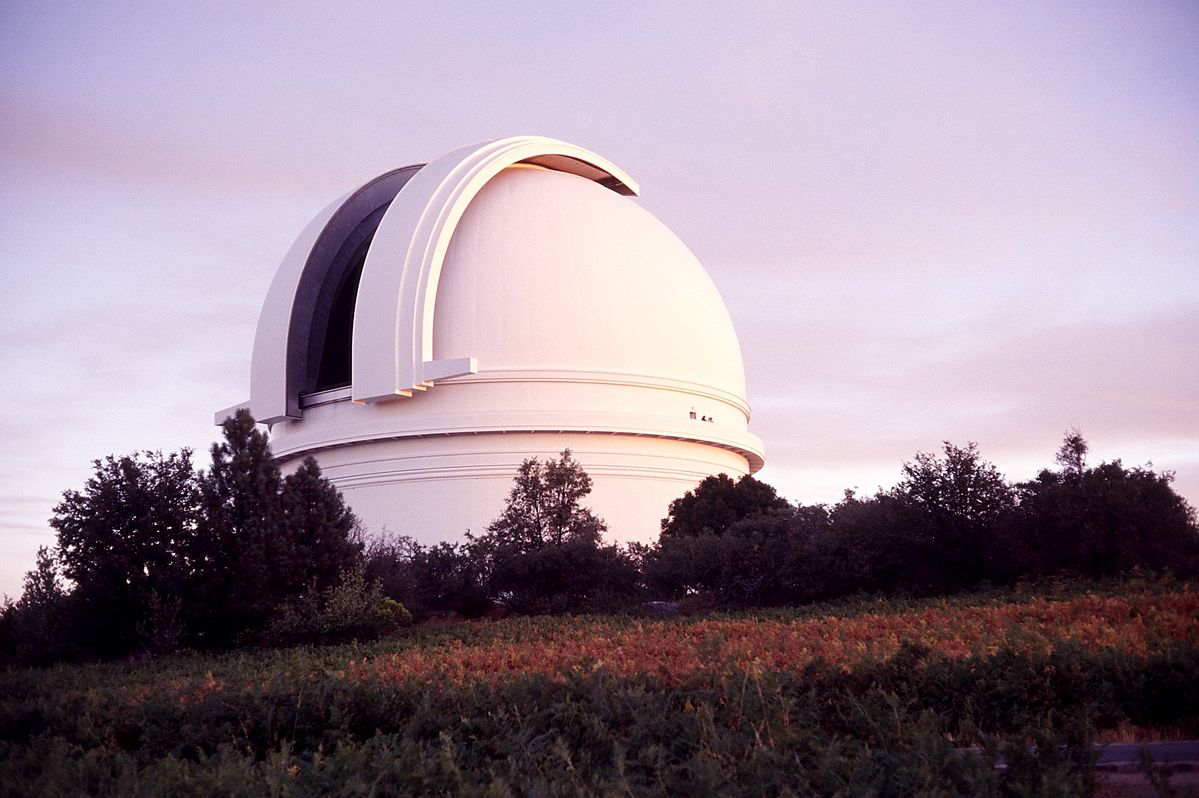 |
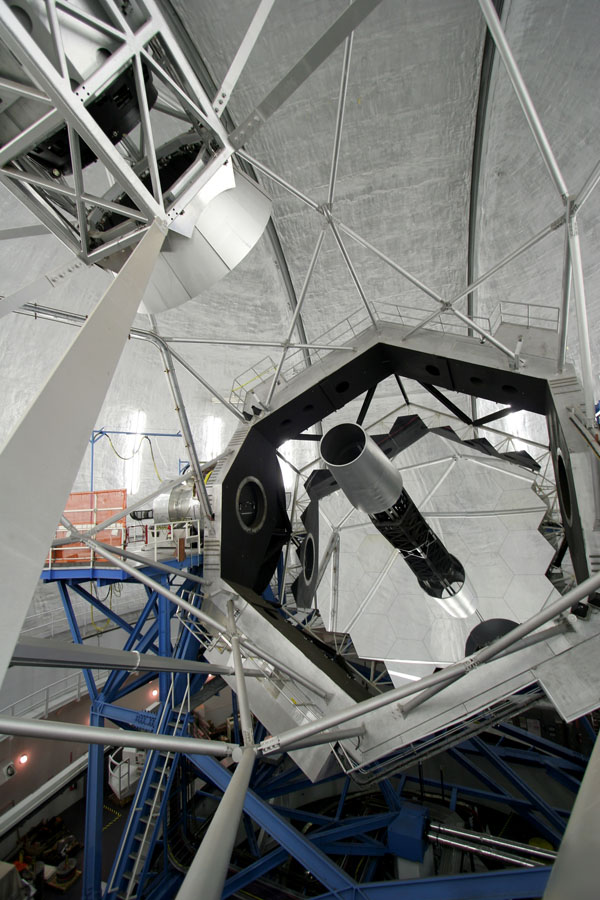 |
|
|---|---|---|---|---|
 |
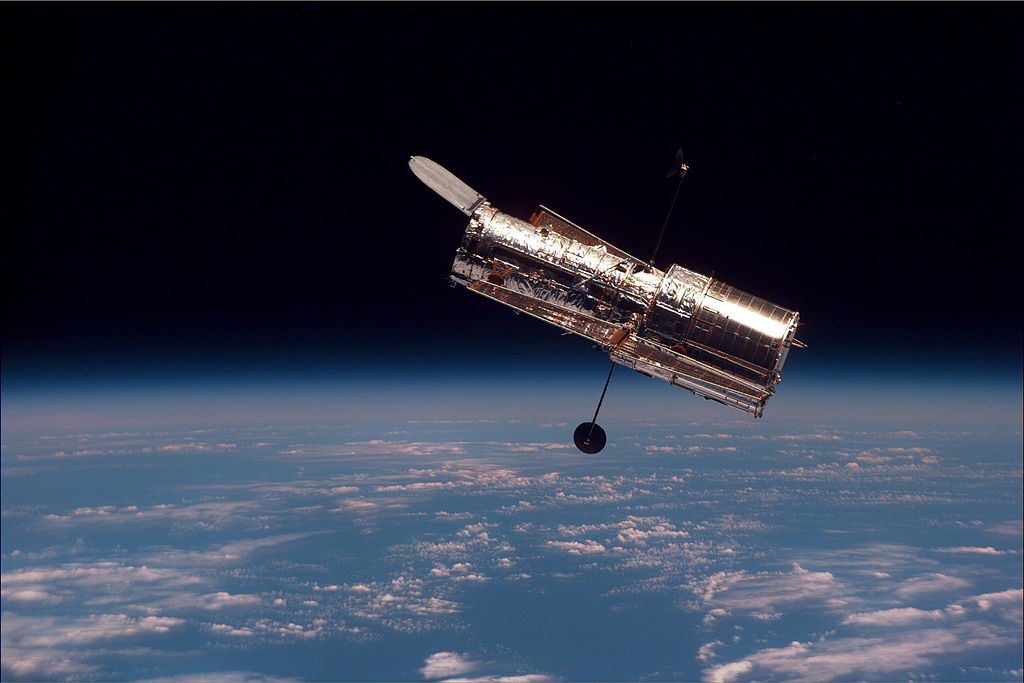 |
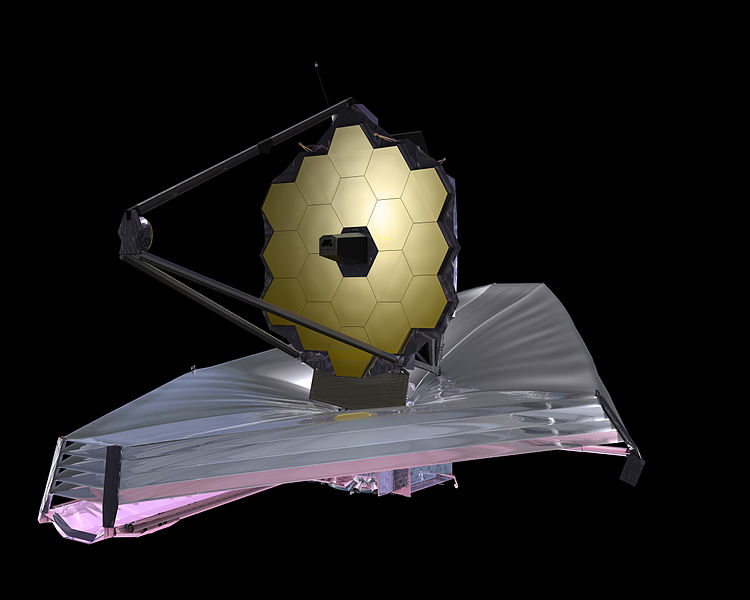 |
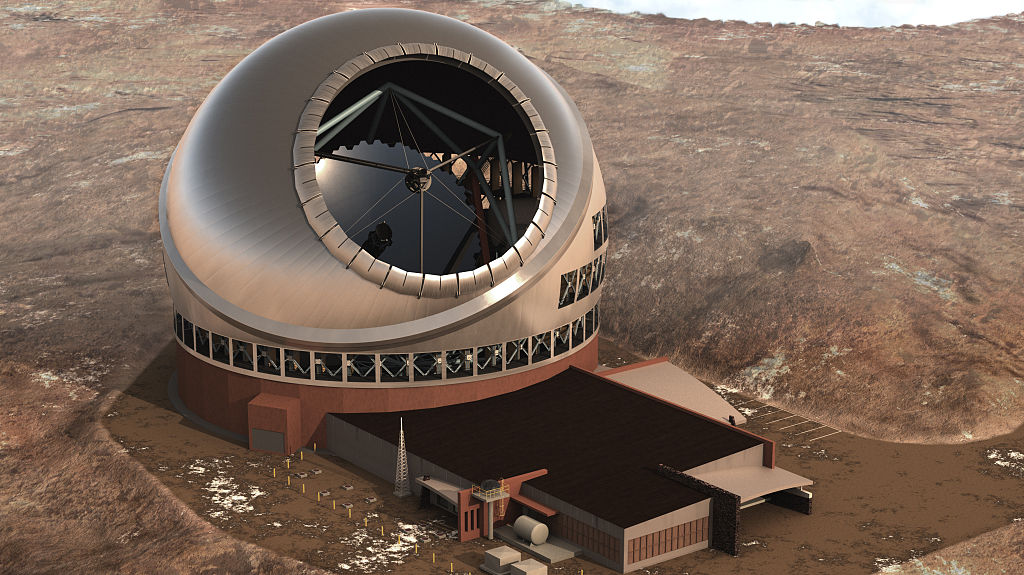 |
|---|---|---|---|
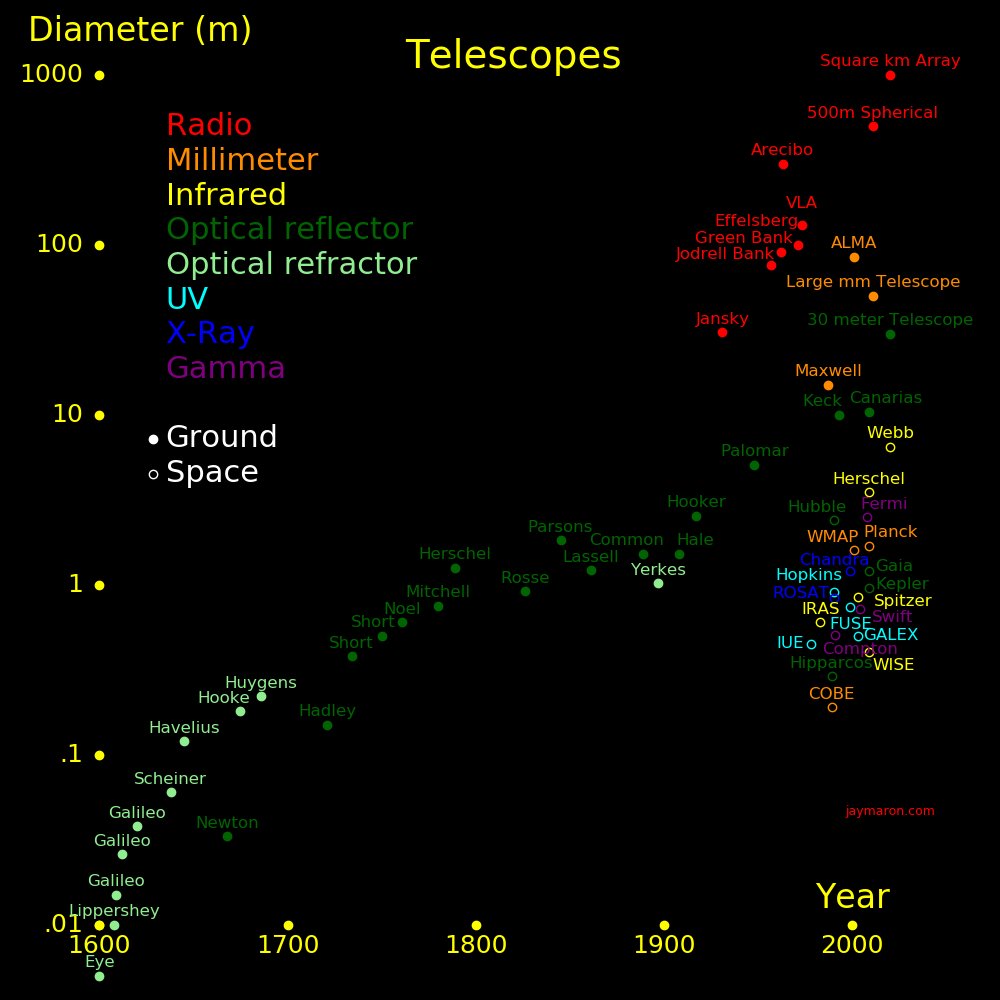 |
|---|
Telescope Diameter Resolution Year
(meters) (arcsecond)
Human eye .005 60
Lippershey's telescope ? ? 1608 First telescope. Refractor
Galileo's telescope #1 .015 7 1609 Refractor
Galileo's telescope #3 .038 2.1 1620 Refractor
Newton's telescope .033 2.5 1668 First reflecting telescope
10 cm telescope .1 .5 Seeing limit
Herschel telescope 1.20 .5 1789 Reflector
Yerkes refractor 1.02 .5 1897 Refractor. End of refractor age
Hale 60-inch 1.52 .5 1908 Mount Wilson observatory
Hooker 100-inch 2.54 .5 1917 Mount Wilson observatory
Hale 200-inch 5.08 .5 1948 Palomar Observatory
Keck 10 .04 1993 Mauna Kea Observatory
Hubble 2.4 .04 1990 Space. Earth orbit
Webb Space Telescope 6.5 .02 2022 Space. L2 Lagrange point
Thirty Meter Telescope 30 .015 ? Mauna Kea Observatory
Extremely Large Tele. 39.3 .005 ? Chile
Modern ground telescopes have adaptive optics to transcend the seeing limit.
 |
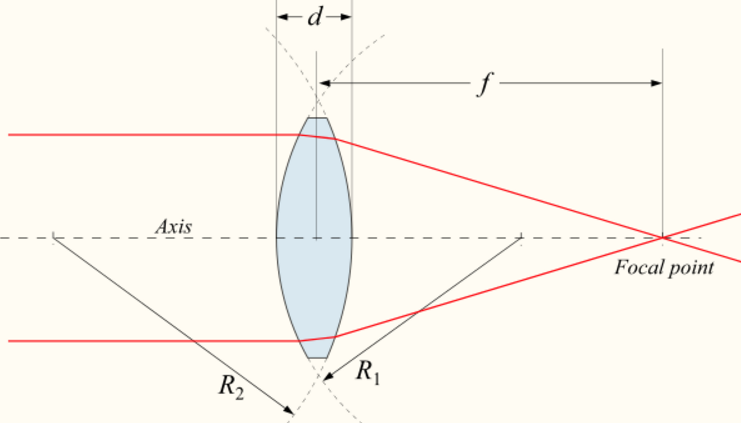 |
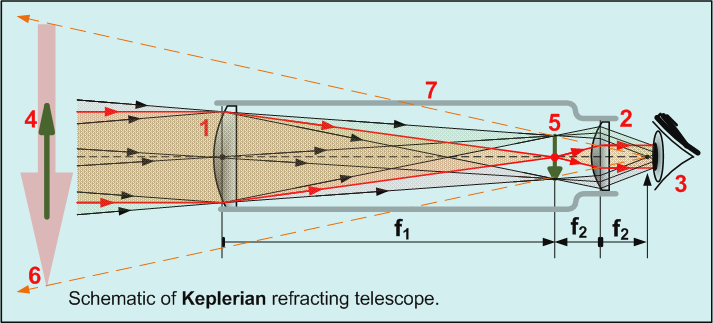 |
|---|---|---|
Refraction depends on wavelength, which introduces "chromatic aberration". This limits the size of refracting telescopes. Reflecting telescopes don't suffer this limitation.
 |
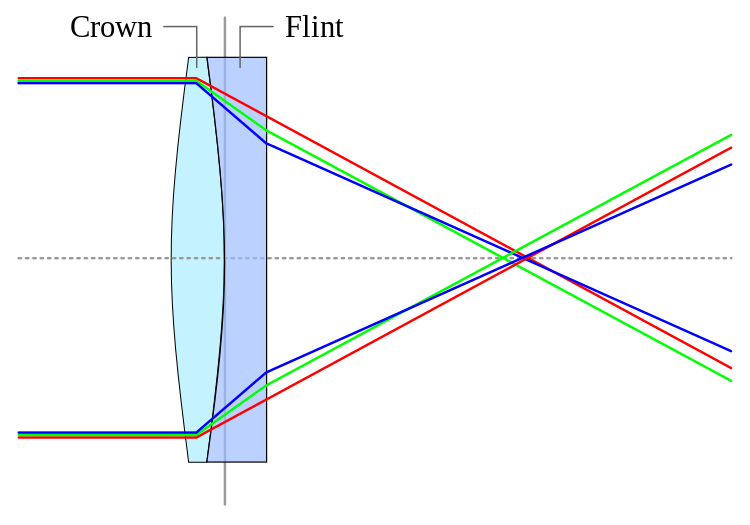 |
|---|---|
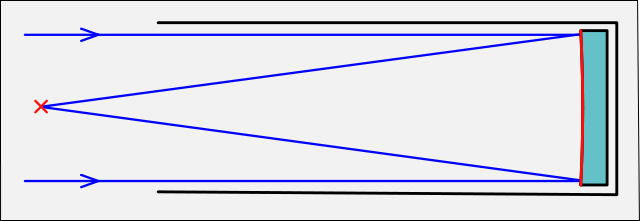 |
 |
 |
|---|---|---|
 |
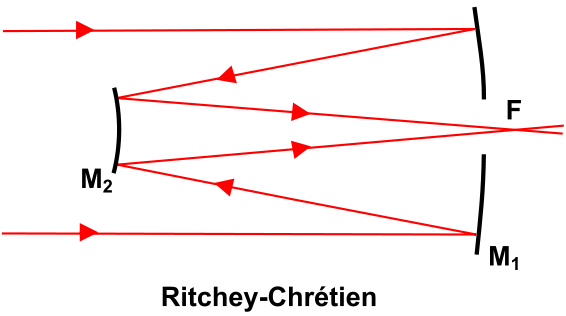 |
|---|---|
1608 Lippershey constructs the first refracting telescope 1663 Gregory publishes a design for a "Gregorian" reflector 1668 Newton constructs the first reflecting telescope, a "Newtonian" reflector 1672 Cassegrain publishes a design for a "Cassegrain" reflector 1910 Ritchey-Chretien reflecting telescope, the basis for modern reflectors
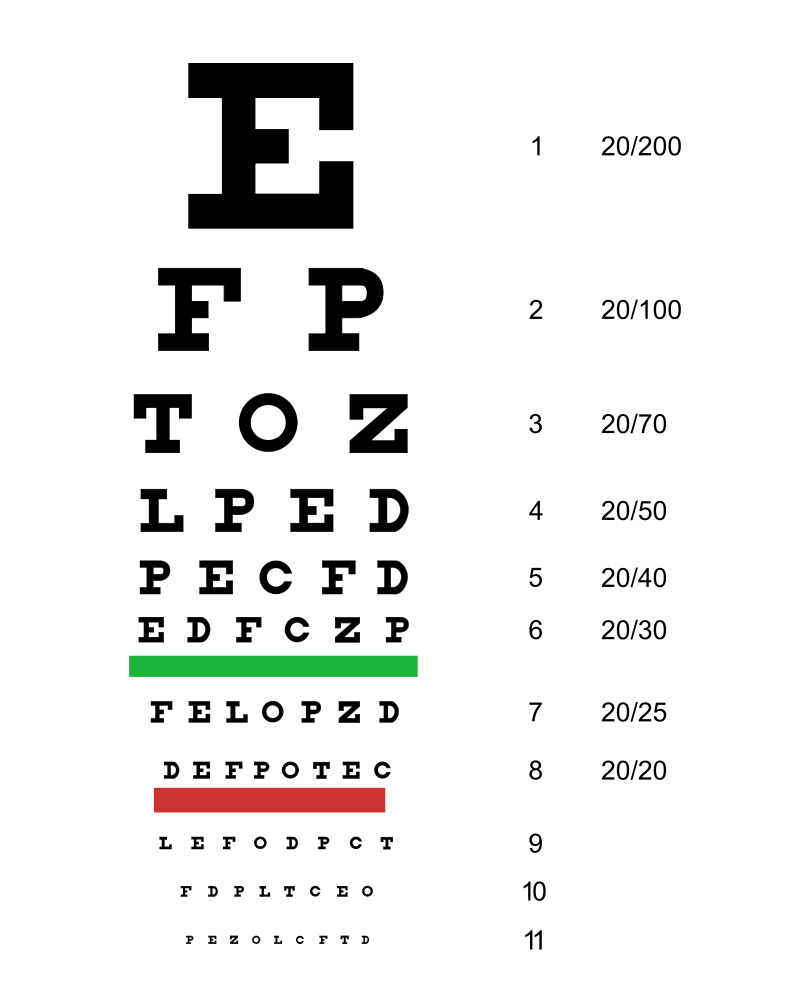 |
|---|
A person with 20/20 vision can distinguish parallel lines that are spaced by an angle of .0003 radians, about 3 times the diffraction limit. Text can be resolved down to an angle of .0015 radians.
Resolution Resolution Diopters
for parallel for letters (meters-1)
lines (radians)
(radians)
20/20 .0003 .0015 0
20/40 .0006 .0030 -1
20/80 .0012 .0060 -2
20/150 .0022 .011 -3
20/300 .0045 .025 -4
20/400 .0060 .030 -5
20/500 .0075 .038 -6
"Diopters" is a measure of the lens strength required to correct vision to 20/20.
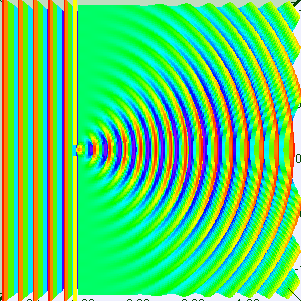 |
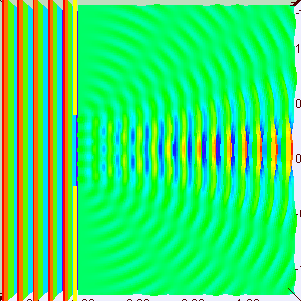 |
|---|---|
The resolution of a telescope is limited by diffraction.
Wavelength of light = L Mirror diameter = D Resolution angle = θ = 1.22 * L / DIf we assume blue light with L=440 nm,
D θ
Eye .005 .00011
10 cm telescope .1 .0000054
Hubble telescope 2.5 .00000021
1 Degree = 60 arcminutes = 3600 arcseconds
1 arcsecond = 4.8e-6 radians
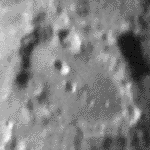 |
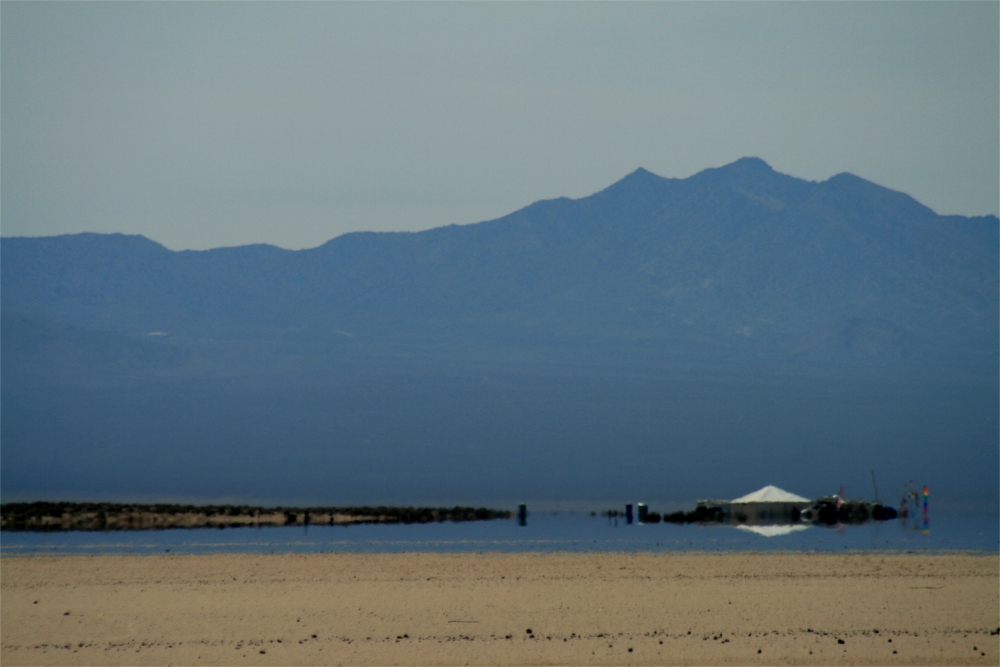 |
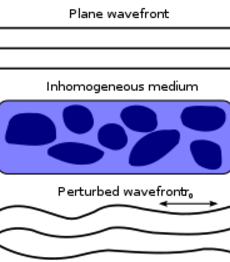 |
|---|---|---|
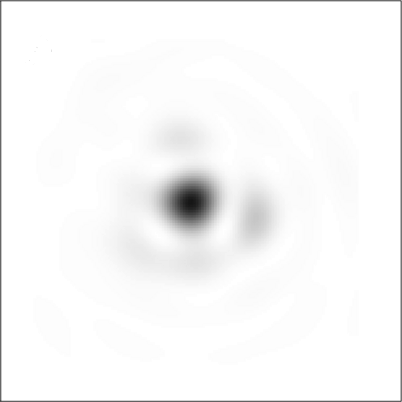 |
 |
|---|---|
The atmosphere blurs light from outer space, limiting telescopes to a resolution of 5e-6 radians or 1 arcsecond. This is the resolution of a 10 cm telescope. A telescope larger than 10 cm has the same resolution as a 10 cm telescope. The advantage of the larger telescope is more light.
Telescope Resolution Reason for diameter (radians) resolution limit (meters) < .1 5e-7 / Diameter Diffraction > .1 5e-6 AtmosphereA space telescope doesn't experience atmospheric distoration and the limit is from diffraction only. The 2.5 meter Hubble space telescope has a better resolution than the 10 meter Keck Earth telescope.
Telescopes equipped with "adaptive optics" can correct atmospheric distortion and reach a resolution better than 5e-6 radians.
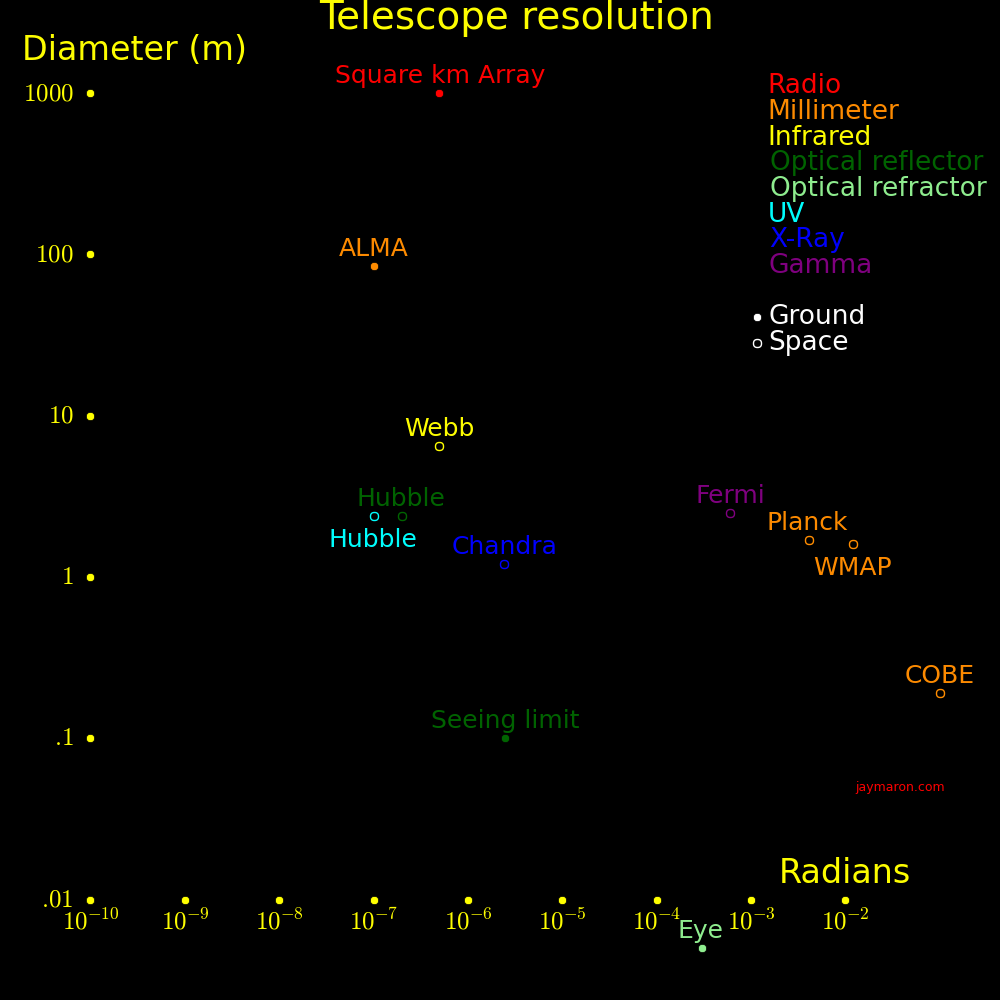 |
|---|
Astronomers measure brightness in a goofy unit called "magnitudes". It was defined by Hipparcos in Ancient Greece and it's still with us.
The "Apparent luminosity" of a star is its brightness as viewed from the Earth.
The "Absolute luminosity" is the power generated by a star in Watts.
Distance to star = R meters Luminosity = L = 3.29⋅1028 * 10-M/2.5 Watts Flux = l = L / (4 π R2) Watts/meter2 Absolute magnitude = M = m + 87.71 - 2.17 log10(R) Apparent magnitude = m = M - 87.71 + 2.17 log10(R) Flux corresponds to the brightness of an object as viewed from the Earth.The fainter an object, the larger its apparent magnitude "m".
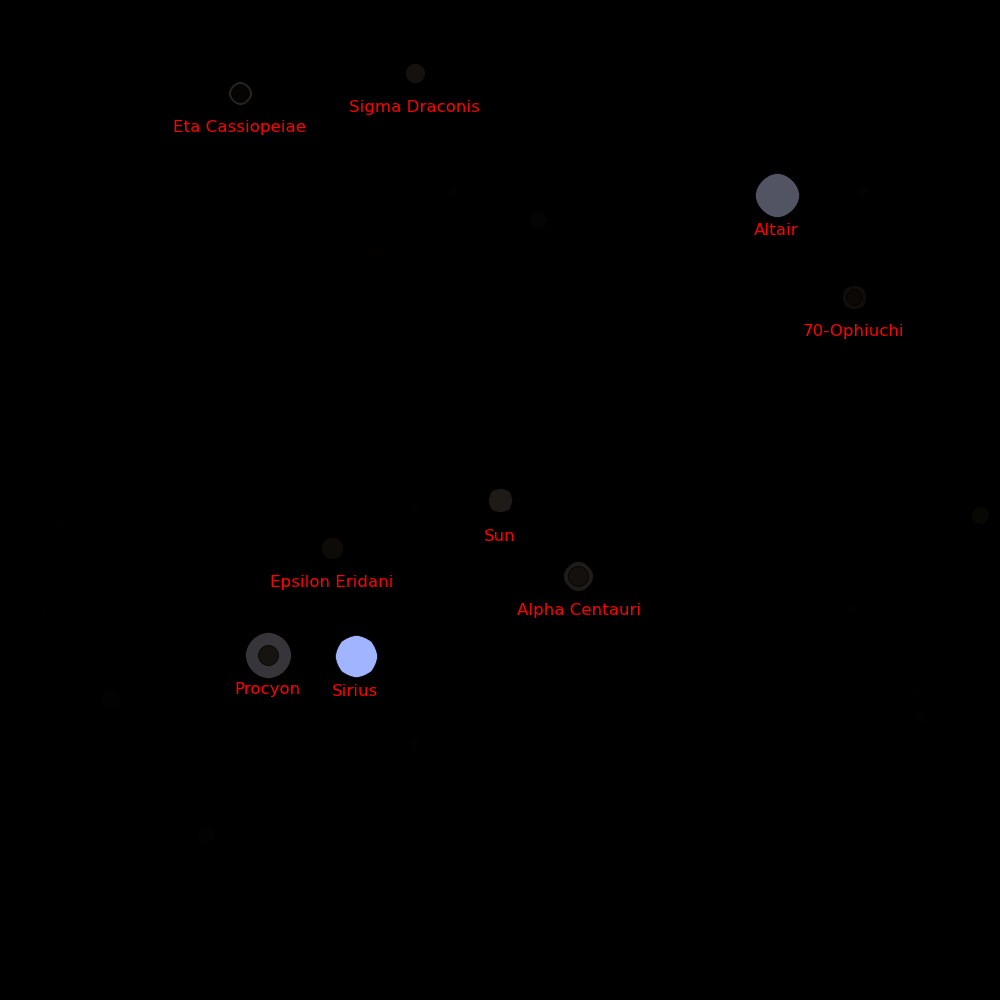 |
|---|
Distance Luminosity Flux Absolute Apparent
from Watts Watts/m2 magnitude magnitude
Earth (L) (l) (M) (m)
Sun 1 AU 3.8e26 1360 4.8 -26.7
Full Moon .00257 AU 4.8e15 2.6e-3 32.1 -12.7
Mars .52 AU 2.3e16 3.1e-7 30.4 -2.9
Jupiter 4.2 AU 1.5e18 3.1e-7 25.8 -2.9
Saturn 8.5 AU 6.8e17 3.4e-8 26.7 -.5
Uranus 18.2 AU 1.5e16 1.6e-10 30.9 5.3 Discovered 1781
Ceres 1.77 AU 4.3e13 4.9e-11 37.2 6.6 Discovered 1801
Neptune 29.1 AU 3.8e15 1.6e-11 32.3 7.8 Discovered 1846
Pluto 28.7 AU 1.8e13 7.8e-14 38.2 13.6 Discovered 1930
Alpha Centauri A 4.36 ly 5.9e26 2.7e-8 4.4 0.0
WISE-0855 7.2 ly 3.4e21 5.9e-14 17.5 13.9 Rogue planet
Sirius 8.58 ly 9.8e27 1.2e-7 1.4 -1.5 Brightest star
Exo-Sun 10.0 ly 3.8e26 3.4e-9 4.8 2.0
Exo-Earth 10.0 ly 5.4e16 4.8e-19 29.5 26.6
Betelgeuse 640 ly 5.8e31 1.3e-7 -6.0 .4 Massive star
Andromeda 2560000 ly 9.9e36 1.3e-9 -21.6 4.2
Values for solar system objects are for when they are closest to the Earth.
Uranus is at the limit of human vision. It's conceivable that an ancient civilization could have detected Uranus. Ceres is just beyond human vision.
WISE-0855 is a brown dwarf with a mass somewhere between 3 and 10 Jupiter masses. It has a temperature of 240 Kelvin and was detected by the WISE infrared space telescope.
"Exo-Sun" and "Exo-Earth" are values for if the sun and the Earth are at a distance of 10 light years.
GRB 080319B is the most luminous recorded gamma ray burst.
 |
|---|
The horizontal lines represent the limits of the Pan-STARRS, Keck, Hubble, and Webb telescopes. Exo-Earth is detectable by the Keck telescope.
Flux Apparent
limit magnitude
Watts/m2 limit
Human eye 3.4e-11 7
Pan-STARRS 5e-18 24
Keck 10 meter 1e-19 28
Hubble 1e-20 31
Webb 5e-22 34
 |
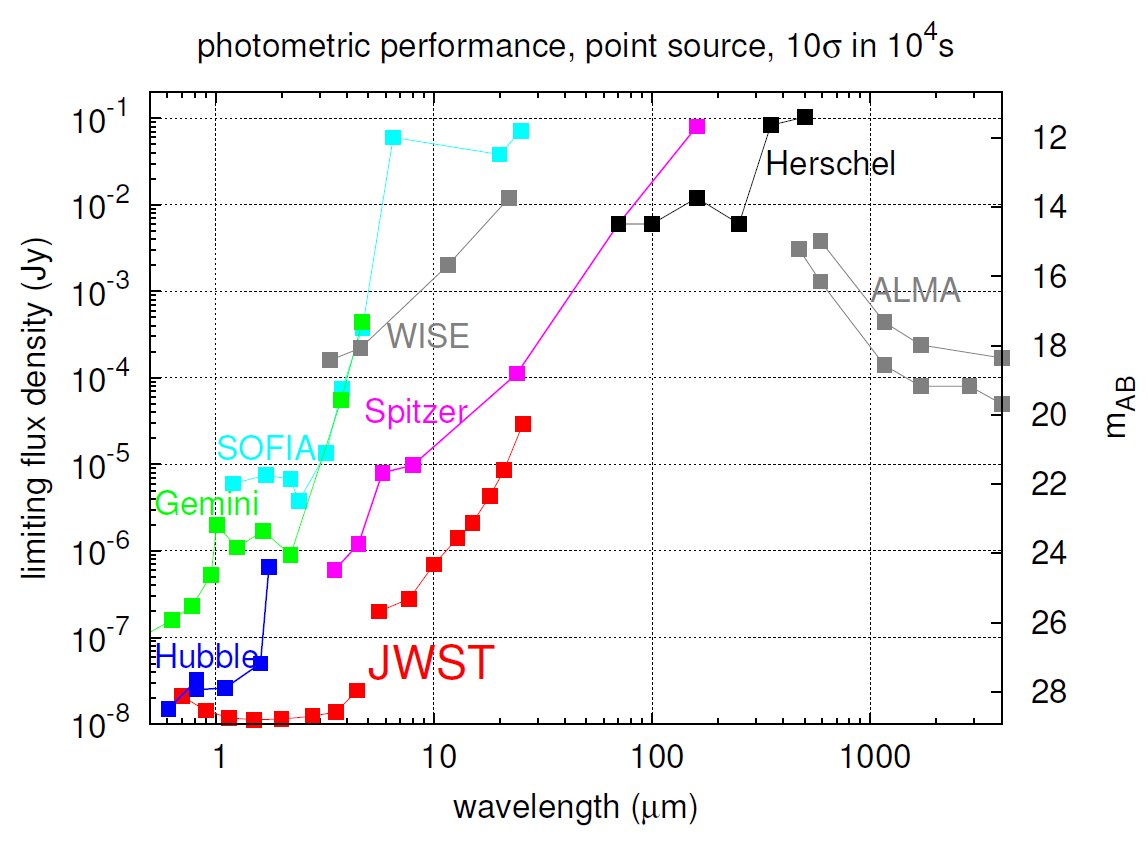 |
|---|---|
Observable from the ground?
Gamma ray No
X ray No
Ultraviolet No
Visible Yes
Infrared No
Millimeter Yes, if the air is dry
Radio Yes
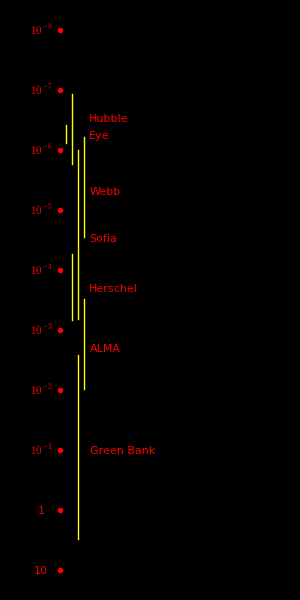 |
|---|
The SOFIA tel escope can see in the infrared because it flies on a Boeing 747 at an altutude of 12 km, which is above most of the atmosphere's water.
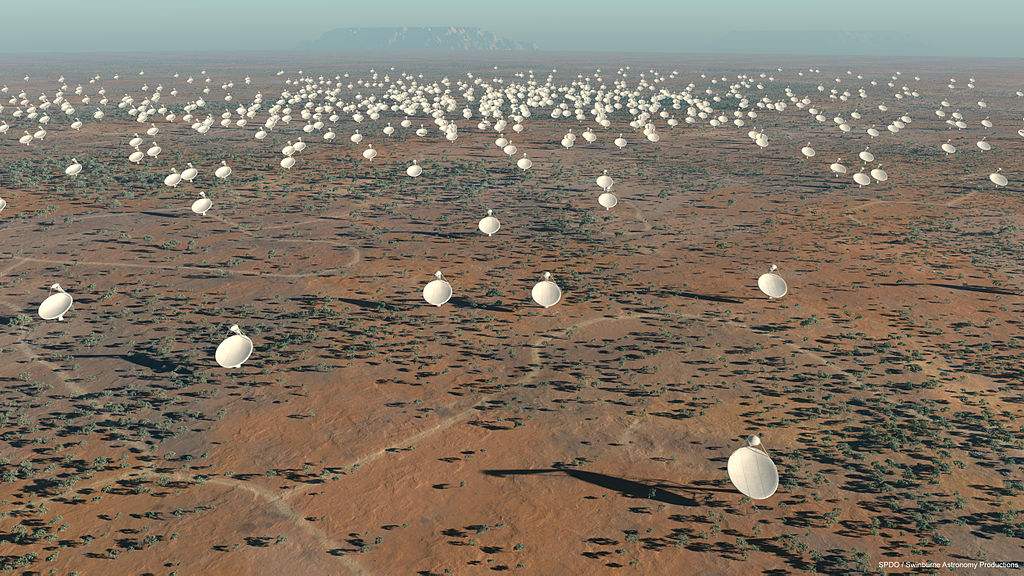 |
 |
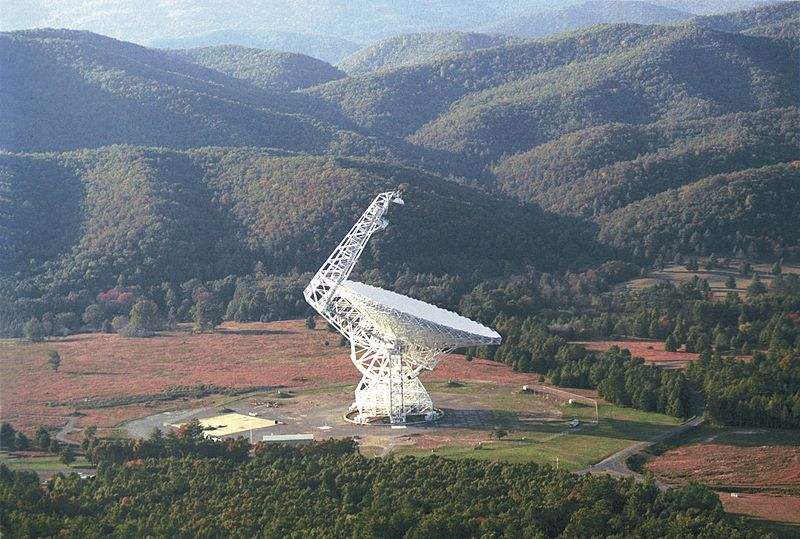 |
|---|---|---|
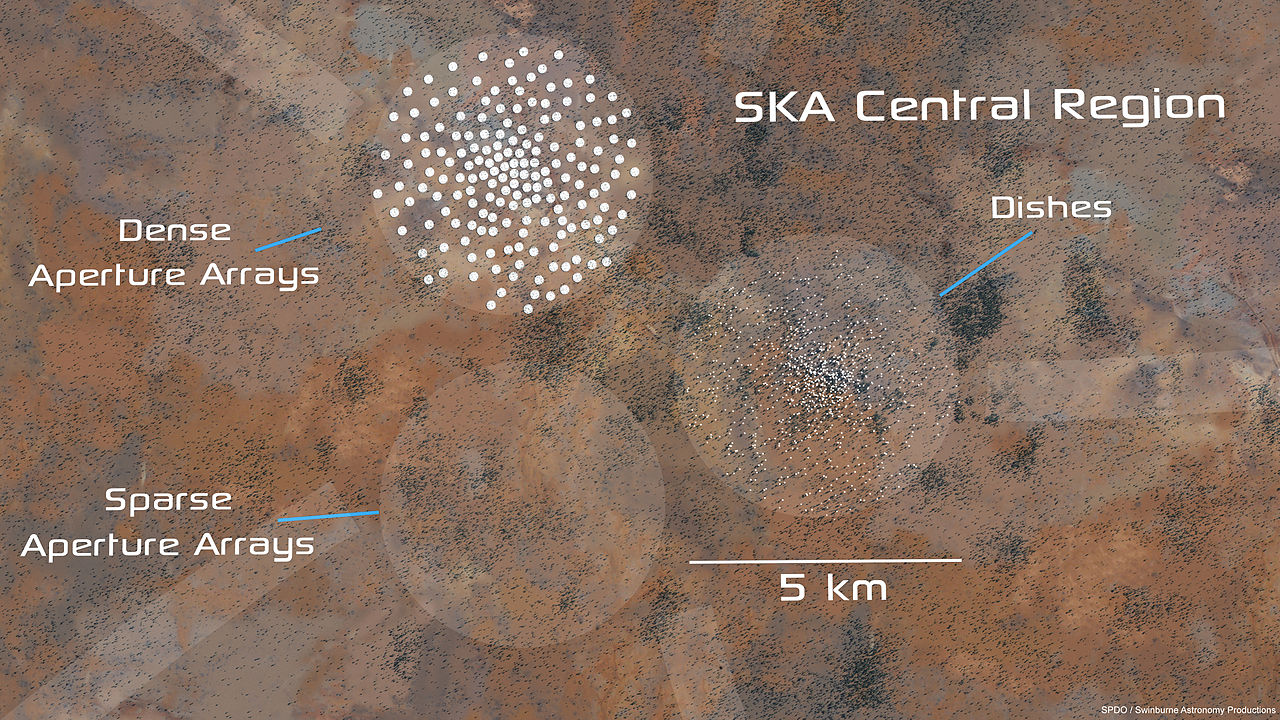 |
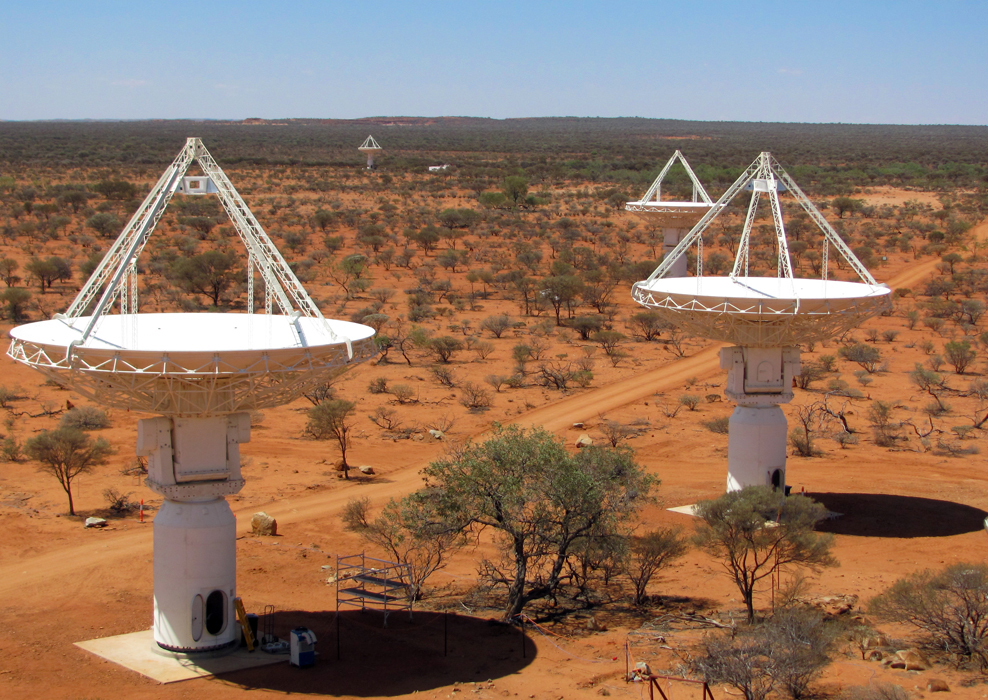 |
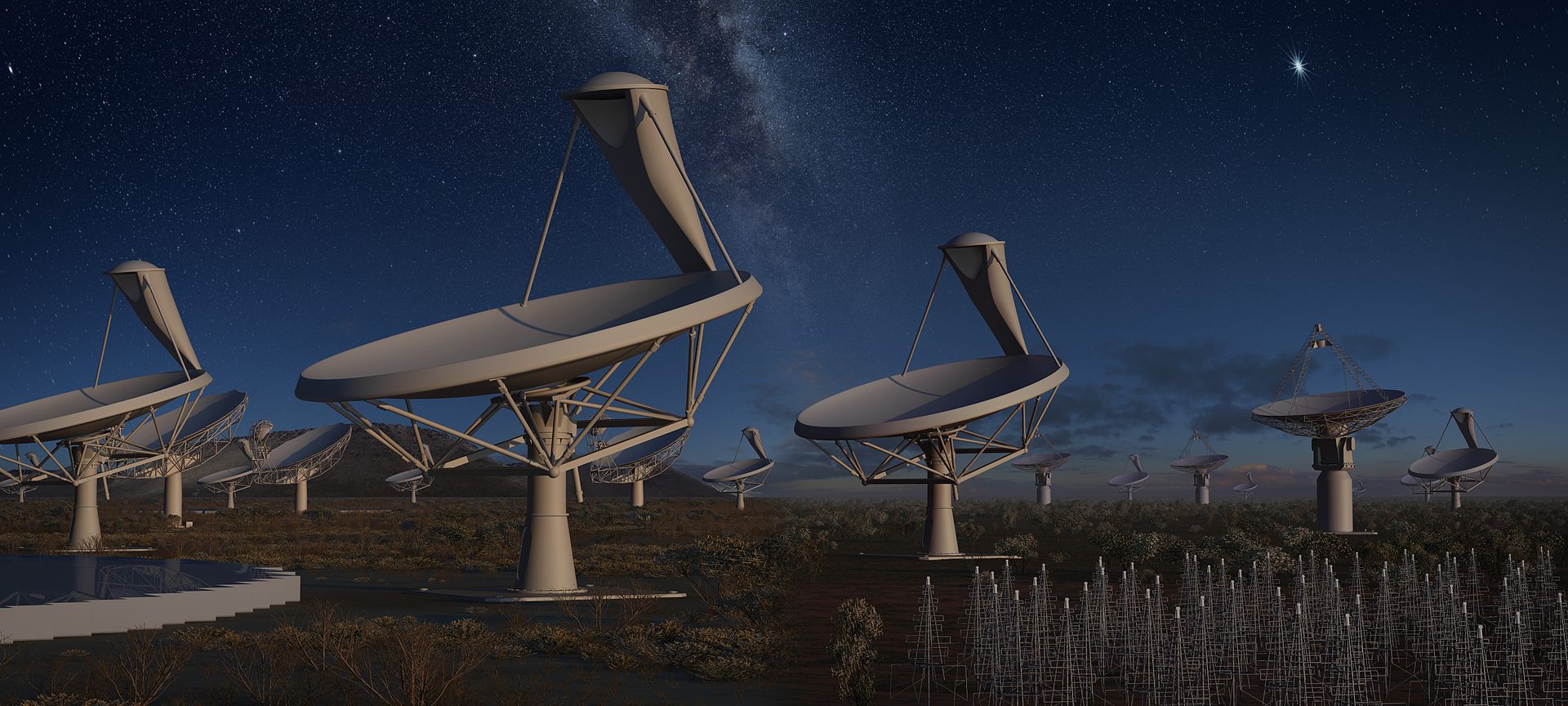 |
|---|---|---|
Min & Max
Aperture Year wavelength
(m) (meters)
Square kilometer Array 1000 2019 .01 4.3 Australia and South Africa
Green Bank II 100 2000 .0026 3.0 Green Bank, West Virginia. Largest steerable dish
Arecibo 300 1963 .03 1.0 Puerto Rico
Green Bank I 91 1962 Collapsed and rebuilt as Green Bank II
Jodrell Bank 76 1951
Jansky 30 1931
Astron 10 2011 .01 1.0 High Earth orbit. Used for large-baseline interferometry
Min & Max
Aperture Year wavelength
(meters) (mm)
CSO 10.5 1986 .3 2.0 Mauna Kea Caltech
Maxwell 15 1987 .3 2.0 Mauna Kea
ALMA 12 2011 .3 9.6 Atacama Desert, Chile 54 12-meter dishes and 12 7-meter dishes
LMT 50 2011 .85 4.0 Sierra Negra, Mexico Large millimeter Telescope
CCAT 25 2017 Cerro Chajnantor, Chile Wavelength range similar to ALMA
CSO = Caltech submillimeter observatory
CCAT = Cerro Chajnantor Atacama Telescope
ALMA = Atacama Large Millimeter Array
Diameter Resolution Mass Min Max Year Location
(m) (urad) (tons) (mm) (mm)
Planck 1.9 4100 .21 .3 11 2009 L2
WMAP 1.6 12000 .76 .32 1.30 2001 L2
COBE .19 1.41 1989 Geocentric
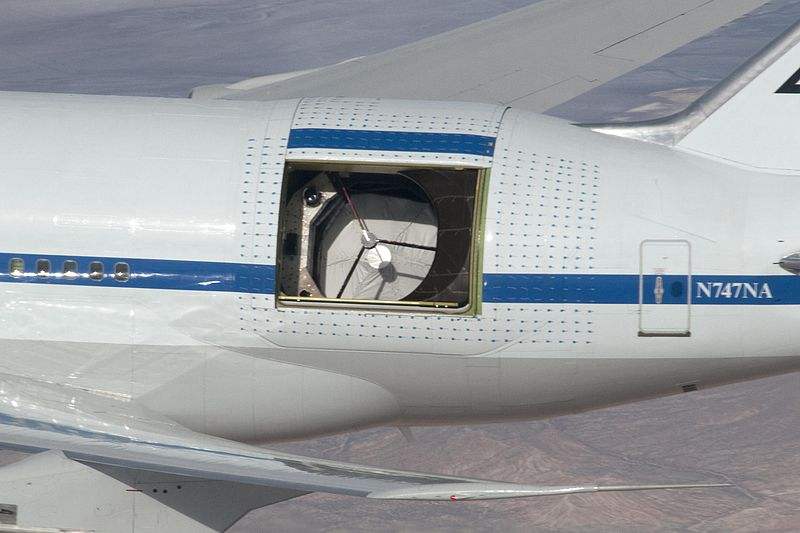 |
|---|
Aperture Year Min Max Location
(meters) (mm) (mm)
WMAP 1.6 2001 .003 .015 L2 Lagrange point NASA Observes cosmic microwave background
Spitzer .85 2003 .003 .180 Sun orbit NASA
WISE .40 2009 .003 .025 Earth orbit NASA
Herschel 3.5 2009 .055 .672 L2 ESA
SOFIA 2.5 2010 .001 .655 Boeing 747 at an altitude of 12 km
SOFIA = Stratospheric Observatory for Infrared Astronomy
Aperture Low High
meter nm nm
International UV Explorer .45 115 320 1978 1996 Full-spectrum reflector
FUSE 90 120 1999 2007 Full-spectrum reflector
Extreme UV Imaging Telescope 17 30 Monochromatic reflectors at 4 wavelengths
EUEV 7 76 1992 2001 Grazing incidence
Rosat XUV .84 .6 30 1990 1999 Grazing incidence
Aperture Resolution Low High Focus Mass Year
meter urad keV keV m tons
Rosat .84 .1 2 1990
Swift .30 .2 10 .61 2004 Geocentric NASA GSFC
Chandra 1.2 2.4 .1 10 10 4.8 1999 Geocentric NASA SAO CXC
XMM-Newton .70 24 .1 12 7.5 3.2 1999 Geocentric ESA
Hitomi soft .3 12 5.6 2.7 2016 Geocentric JAXA
Hitomi hard 5 80 12 2.7 2016 Geocentric JAXA
NuSTAR .32 46 3 79 10.15 .17 2012 Geocentric NASA
INTEGRAL JEM-X .31 3 35 4.0 2002 Geocentric ESA RKA NASA
INTEGRAL Main .31 3500 15 10000 4.0 2002 Geocentric ESA RKA NASA
NuSTAR has a collecting area of 847 cm2 at 7 keV and a collecting area of 60 cm2 at 78 keV. The field of view is 12 arcminutes.
The Hitomi lost attitude control and went into an uncontrollable spin, destroying the telescope.
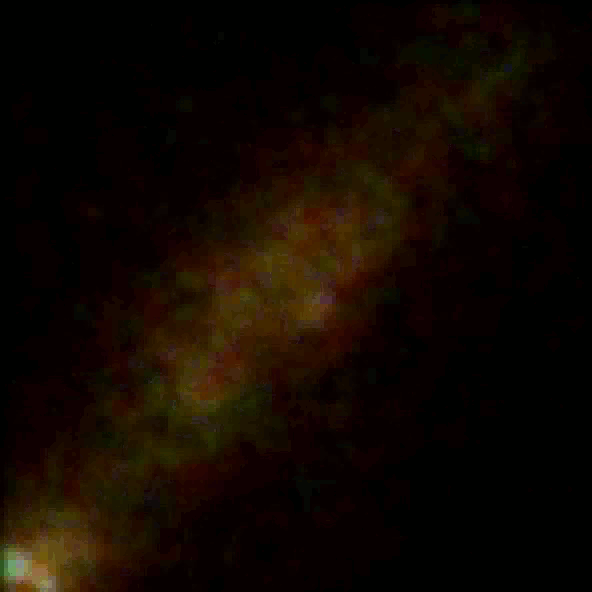 |
|---|
Year Low High Mass
MeV MeV tons
Hitomi 2016 .06 .6 2.7 Geocentric JAXA
INTEGRAL 2002 .015 10 4.0 Geocentric ESA RKA NASA
Fermi 2008 30 300000 4.3 Lagrange #2 NASA
Aperture Magnitude Field of Exposure Full-sky CCD Year
meters limit view seconds survey time Gpixels
degrees days
Pan-STARRS 3.6 24.0 3.0 60 8 1.4 2010 Hawaii
LSST 8.4 24.5 3.5 15 2 3.2 2021 El Penon, Chile
The Pan-STARRS and LSST telescopes are designed to find solar system objects, which is why they use short exposures.
Frequency = F
Wavelength = W
Planck constant = h = 4.1357⋅10-15 eV seconds
Speed of light = C = F W = 2.9979⋅108 meters/second
Energy = E = h F
Aperture diameter = D
Diffraction angle = A = 1.22 W / D
Energy Wavelength Temperature
(eV) (nm) (Kelvin)
Gamma ray 1000000 .0012
X-Ray 1000 1.2 290000
Bohr energy 13.6 91 32000
UV-Extreme min 12.4 100 29000
UV-C min 4.43 280 10350
UV-B min 3.94 315 9200
Human UV limit 3.10 400 7244
Violet 3.06 405 7155
Blue 2.79 445 6512
Cyan 2.58 480 6037
Green 2.33 532 5447
Yellow 2.10 589 4920
Orange 2.03 610 4750
Red 1.91 650 4458
Human IR limit 1.63 750 3864
1 electron Volt 1 1222 2371
Infrared .12 10000 290
Millimeter .0012 106 2.90 300 GHz
Radio 109 .0029 300 MHz
1800 Herschel discovers infrared light by its effect on a thermometer
1801 Ritter discovers UV rays by their effect on AgCl
1835 Melloni builds a thermoelectric infrared detector
1878 UV rays are found to kill bacteria
1879 Stefan-Boltzmann law: Power = Constant * Area * Temperature^4
1901 Planck hypothesizes that E=hF
1905 Einstein discovers the photoelectric effect
1960 UV rays found to be harmful to DNA
 |
 |
|---|---|
"Ridge A" in Antarctica is a 4 km high plateau where the environment is cold, dry, and has no wind, making it the best place in the world for a telescope. Resolution is up to 3 times higher than what can be achieved by telescopes at the equator. It is also ideal for submillimeter astronomy, which requires cold dry air.
Properties of Ridge A:
Altitude = 4053 meters.
Distance from the South Pole = 1000 km.
Distance from Dome A = 144 km. Dome A is the highest ice feature in
Antarctica, with an altitude of 4091 meters.
Annual snowfall = 2 cm.
Average temperature = -70 Celsius.
 |
|---|
Modern mathematics and physics was launched when Simon Stevin popularized decimal numbers in Europe. Cartesian geometry and the calculus followed shortly after. Mathematics has been on a roll ever since.
Decimal numbers enable precise calculation, which is essential for science. Shortly after decimal numbers were popularized, the logarithm and the slide rule were invented. The slide rule enables fast multiplication and division.
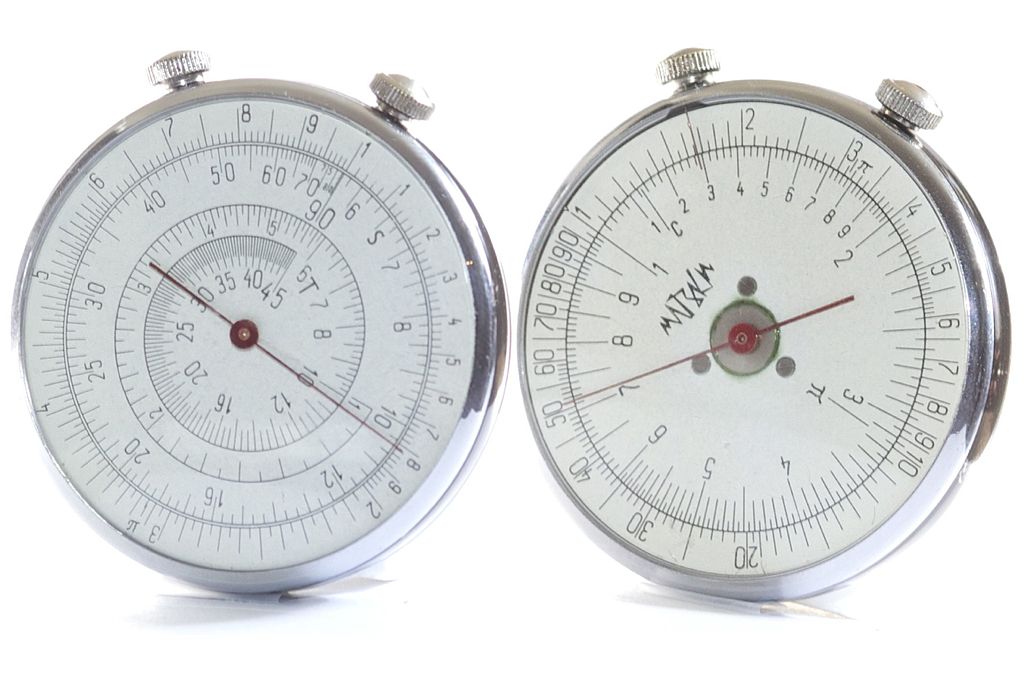 |
 |
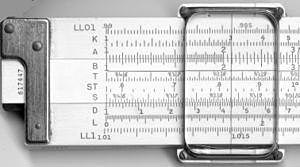 |
|
|---|---|---|---|
1585 Stevin popularizes decimal numbers in Europe
1614 Napier develops logarithm tables
1622 Oughtred develops the slide rule
1604 Galileo publishes the mathematical description of acceleration.
1637 Cartesian geometry published by Fermat and Descartes.
1684 Leibniz publishes the calculus
1687 Newton publishes the Principia Mathematica, which contained the calculus,
the laws of motion (F=MA), and a proof that planets orbit as ellipses.
-240 Eratosthenes measures the Earth's circumference to 20% error.
-240 Aristarchus proves that the sun is at least 10 times larger than the Earth
using lunar eclipses.
150 Ptolemy publishes The Almagest with the geocentric model
550 Aryabhata publishes accurate measurements of size of the sun and moon
1543 Copernicus publishes a heliocentric model.
1600 Brahe measures accurate planet positions
1608 Lippershey invents the telescope
1609 Galileo builds a telescope and begins observing
1609 Kepler proves that planets orbit as ellipses using Brahe's data
1613 Galileo publishes observations of the phases of Venus, which support
the heliocentric model
1632 Galileo publishes the "Dialogue Concerning the Two Chief World Systems",
which contained a comparison of the systems of Ptolemy and Copernicus
1672 Richter and Cassini measure the parallax of Mars, producing a precise
value for the size of the sun
1687 Newton publishes the Principia Mathematica, which contained the calculus,
the laws of motion (F=MA), and a proof that planets orbit as ellipses.
1718 Halley finds that the stars move. He found that Sirius, Arcturus and
Aldebaran were 1/2 of a degree from the positions charted by the Ancient
Greek astronomer Hipparchus
1783 Herschel finds that the solar system is moving with respect to the stars
1826 Olbers' paradox. If the stars in the universe are uniformly distributed
and if the universe is infinite, then the sky would appear infinitely bright
with stars.
1863 Bessel measures the first stellar parallax, showing that the
stars are more than 4 light years away. This also implies that stars
are as luminous as the sun.
The parallax of stars is too small to see without a telescope.
1905 Einstein publishes special relativity
1915 Einstein publishes the general theory of relativity.
Einstein shows that general relativity is consistent with the existence
of a cosmological constant. At the time the cosmological constant was a
proposed explanation for why the universe hasn't collapsed gravitationally.
1920 Shapley finds that the sun is not at the center of the galaxy.
Because starlight is absorbed by interstellar gas, we only see the nearby
stars and it appears as though we live at the center of a disk of stars.
Shapley measured the distances to globular clusters and found that they
are centered on a point (the galactic center) that is far from the sun.
1922 Friedmann finds a solution to the equations of general relativity that
are consistent with an expanding universe.
1923 Hubble measures the distances to Andromeda and Triangulum and finds that
they are outside the Milky Way. These were the first objects to be shown
to be outside the Milky Way.
1929 Hubble's law published. For distant galaxies, the recession velocity is
proportional to distance.
1933 Zwicky's analysis of the Coma cluster of galaxies shows that they contain
unseen matter that is not due to stars.
1965 Penzias and Wilson discover the cosmic microwave background radiation.
1970 Rubin and Ford measure galactic rotation and show that galaxies contain
matter that is not due to stars.
1980 Guth and Starobinsky propose the theory of inflation to explain why the
universe is flat
1998 Observations of supernovae show that the expansion of the universe is
accelerating and the the cosmological constant is positive.
Previous to this it was not known if the universe was destined for
collapse (big crunch) or for infinite expansion (big chill).
2003 WMAP mission measures the Hubble constant to 5% precision, as well as
other cosmological parameters.
Previous to this, the Hubble constant had an error of ~ 20%.
This settled once and for all the question of the overall structure of the
universe.
-260 Aristarchus established that the distance to the sun is at least 20 times the distance to the moon.
In 499, Aryabhata publishes a measurement of the distance to the sun.
Brahe's data consisted of measurements of angles between different objects. This data could be used to establish the shape of orbits but not their size. For example, if the size of the solar system were doubled along with the speeds of the planets, the angles would stay the same and you wouldn't be able to tell the difference.
In 1639, Horrocks used a transit of Venus to measure the distance to the sun, but this method is incapable of giving an accurate value, and it can only be done once per century.
In 1672, Richter and Cassini measured the parallax of Mars which gives a result for the distance to the sun that is more accurate than the Venus method. The Mars method has an advantage over the Venus method in that it can be done once every 26 months, when Mars is at closest approach.
In 1676, Romer used the moons of Jupiter to measure the time it takes for light to cross the Earth's orbit. This gives a value for R/C.
In 1729, Bradley measured the deflection of starlight due to the Earth's motion, which gives a measurement of V/C, or equivalently, a measurement of R/C.
In 1849, Fizeau produced the first measurement for the speed of light that was independent of the Earth-sun distance R.
Speed of light = C Earth-sun distance = R Earth orbital velocity = V Earth orbital time (1 year) = T = 2 π R / V Time for light to cross the Earth's orbit= t = 2 R / C
The unit of energy used for atoms, nuclei, and particle is the "electron Volt", which is the energy gained by an electron upon descending a potential of 1 Volt.
Electron Volt (eV) = 1 eV = 1.602e-19 Joules Kilo electron Volt = 1 keV = 103 eV Mega electron Volt = 1 MeV = 106 eV Giga electron Vlt = 1 GeV = 109 eV
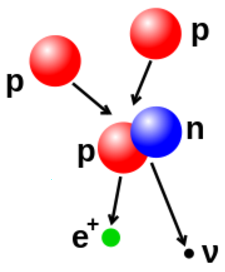 |
 |
|---|---|
Proton + Proton -> Deuterium + Positron + NeutrinoHydrogen fusion requires a temperature of at least 4 million Kelvin, which requires an object with at least 0.08 solar masses. This is the minimum mass to be a star. The reactions in the fusion of hydrogen to helium are:
P + P --> D + Positron + Neutrino + .42 MeV P + D --> He3 + Photon + 5.49 MeV He3 + He3 --> He4 + P + P + 12.86 MeV
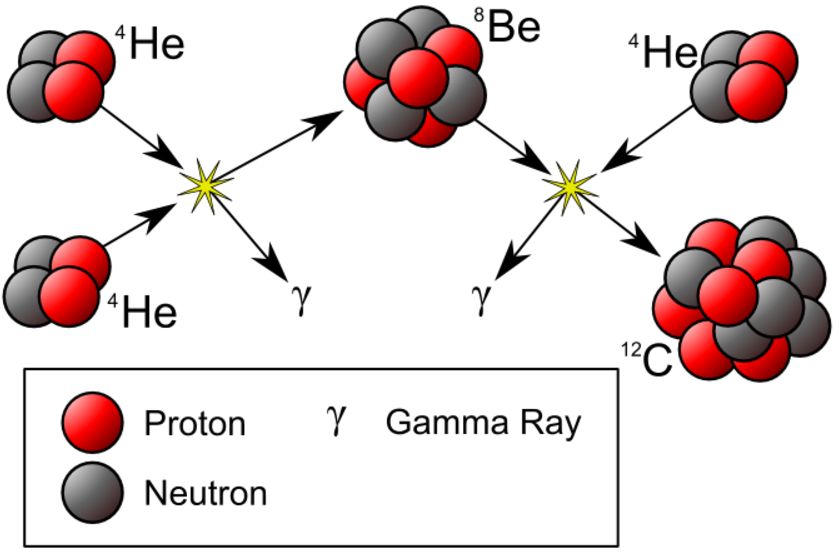 |
|---|
As the core of a star star runs out of hydrogen it contracts and heats, and helium fusion begins when the temperature reaches 10 million Kelvin.
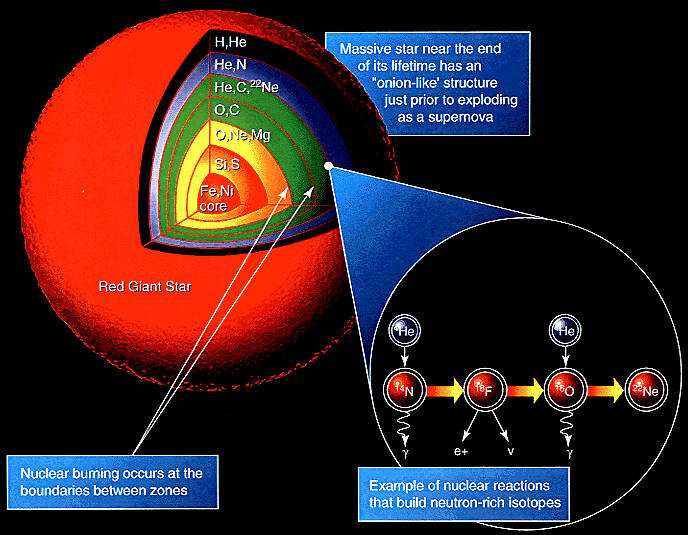 |
|---|
A heavy star continues to fuse elements until it reaches Iron-56. Beyond this, fusion absorbs energy rather than releasing it, triggering a runaway core collapse that fuses elements up to Uranium. If the star explodes as a supernova then these elements are ejected into interstellar space.
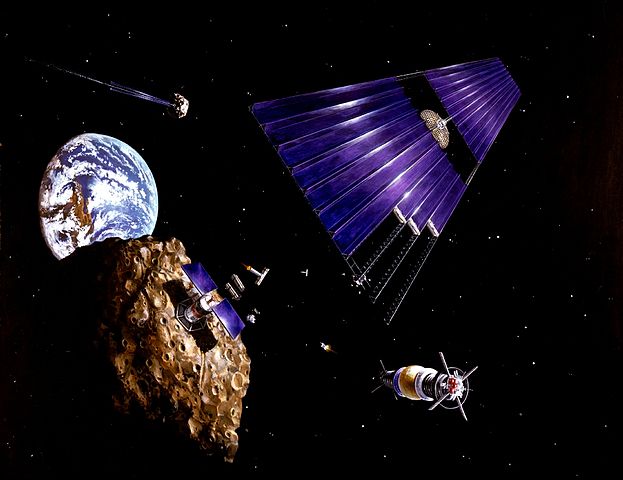 |
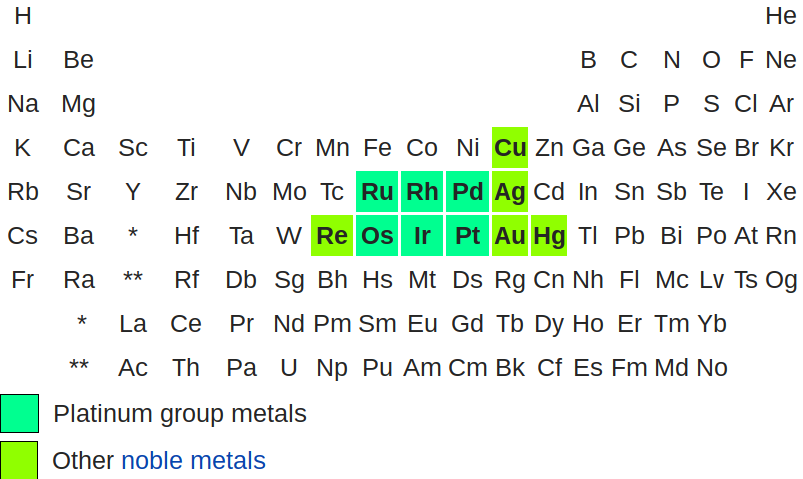 |
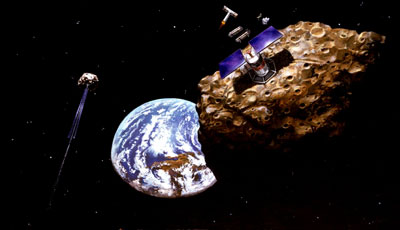 |
|---|---|---|
Platinum group metals are abundant in metal asteroids and rare in the Earth's crust. The Earth's best platinum mines are metal asteroid craters. A 30 meter metal asteroid has 15 billion dollars of platinum group metals.
Metal asteroids are 91% iron, 7% nickel, and .6% cobalt. Cobalt is used in lithium-ion batteries and nickel is used for steel alloy. Bringing the iron to the Earth saves us energy on steel production. The iron is also useful for building large-scale structures in space.
The asteroid belt is formed from a destroyed planet. The metal core of the planet is the asteroid 16-Psyche, and metal asteroids are shrapnel from the core. 16 Psyche has a diameter of 186 km and contains 100 quadrillion dollars of platinum group metals.
The moon has metal asteroid craters, and we should be prospecting for them.
The plot shows the elements in the Earth's crust and in a metal asteroid.
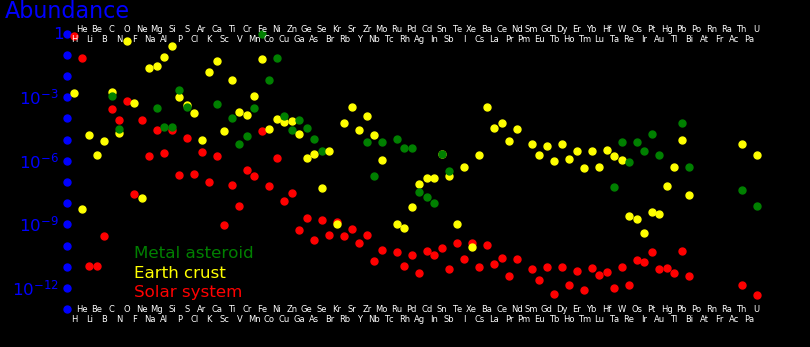 |
|---|
The table shows the value of metals in a billion kg asteroid, which is 30 meters in size. The most profitable elements are osmium, rhodium, nickel, platinum, and palladium. The best catalysts are rhodium, platinum, and palladium, hence these metals will always have value.
Mass in asteroid Value Value in asteroid
tons $/kg Billion $
Osmium 7.6 1600000 12
Rhodium 4.1 500000 2.0
Nickel 67000 16 1.1
Platinum 19 35000 .7
Palladium 3.8 72000 .3
Cobalt 6300 33 .2
Iron 910000 .75 .7
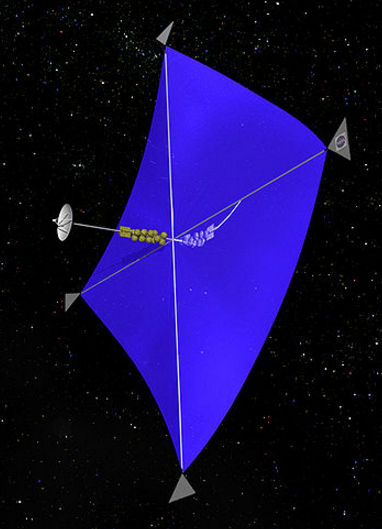 |
|---|
Metallic asteroids can be mined by distillation, where a space mirror focuses sunlight onto the asteroid to boil off the iron and leave behind the platinum group metals. This also imparts momentum to the asteroid to send it to the Earth.
The best way to get to a metal asteroid is with a fission thermal rocket. It has an exhaust speed of 13 km/s, far better than a hydrogen+oxygen rocket (4.4 km/s). We should be developing these rockets.
In the limit of
Mass of Planet / Mass of Star -> 0the distance from the planet to L1 or L2 is the same and is called the "Hill radius" H.
G = Gravitational constant M0 = Mass of Star M = Mass of Planet R = Planet orbit radius T = Planet orbit time m = Mass of moon r = Moon orbit radius t = Moon orbit time H = Planet Hill radiusTo calculate the Hill radius, we set (without loss of generality)
G = M0 = R = 1We assume that the star is vastly heavier than the planet and that the planet is vastly heavier than the moon:
m << M << 1 → r << 1In the limit M → 0, the distance from the planet to L1 or L2 is the same and is called the "Hill radius".
Suppose an object is orbiting at L2 with velocity U. Since this object orbits with the same angular velocity as the planet,
U = (1 + H)The force balance on this object is
Force from star + Force from planet = Centripetal force 1/(1+H)2 + M/H2 = U2/(1+H) 1 - 2H + M/H2 = 1 + H H = (M/3)1/3Restoring units,
H = R (M/(3*M0))1/3
 |
|---|